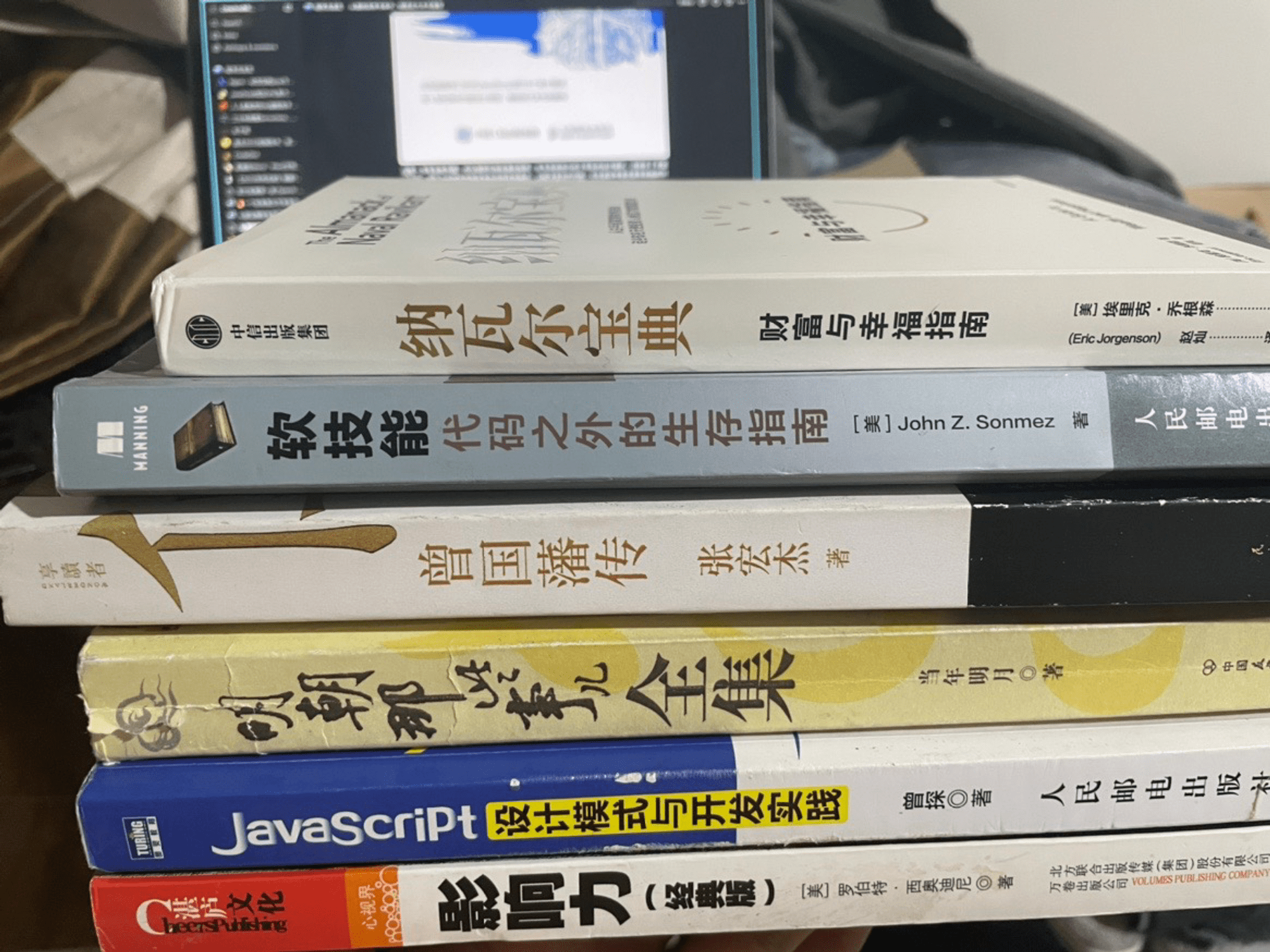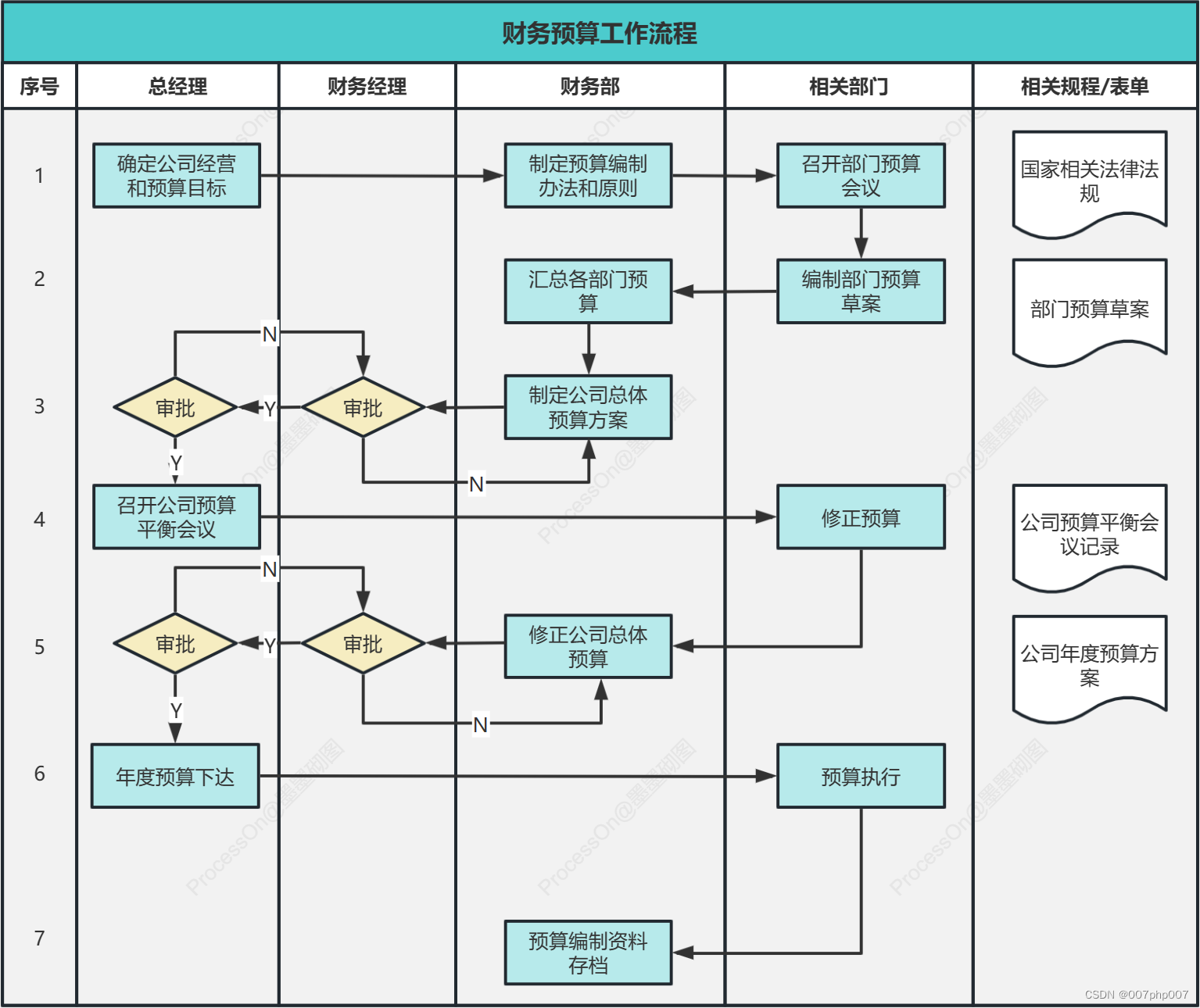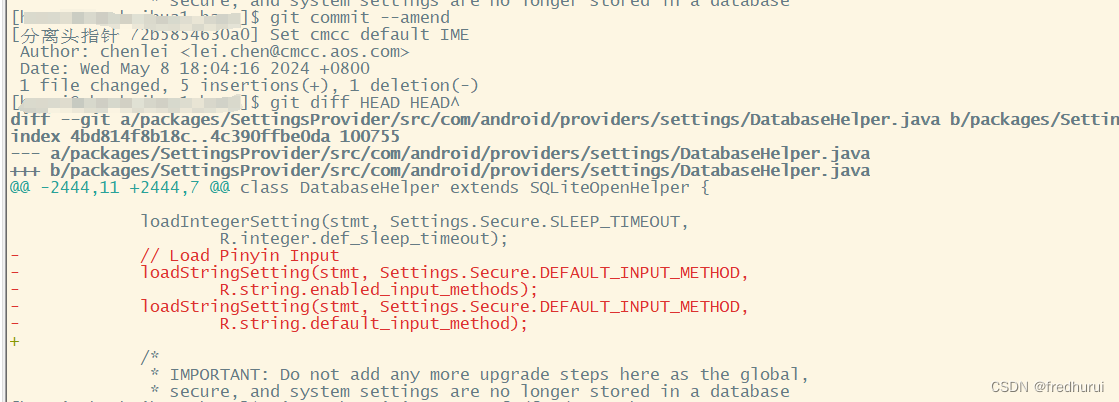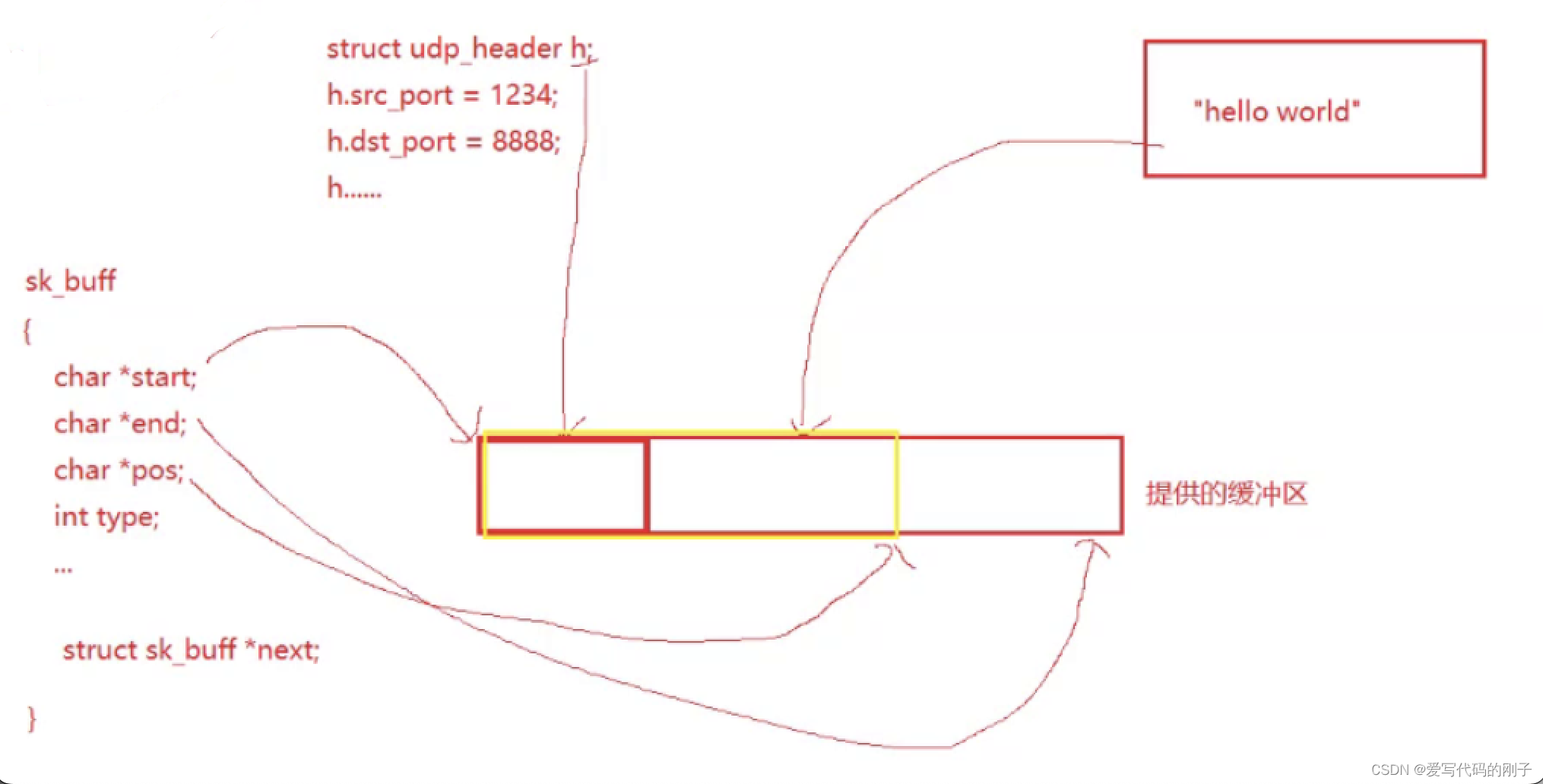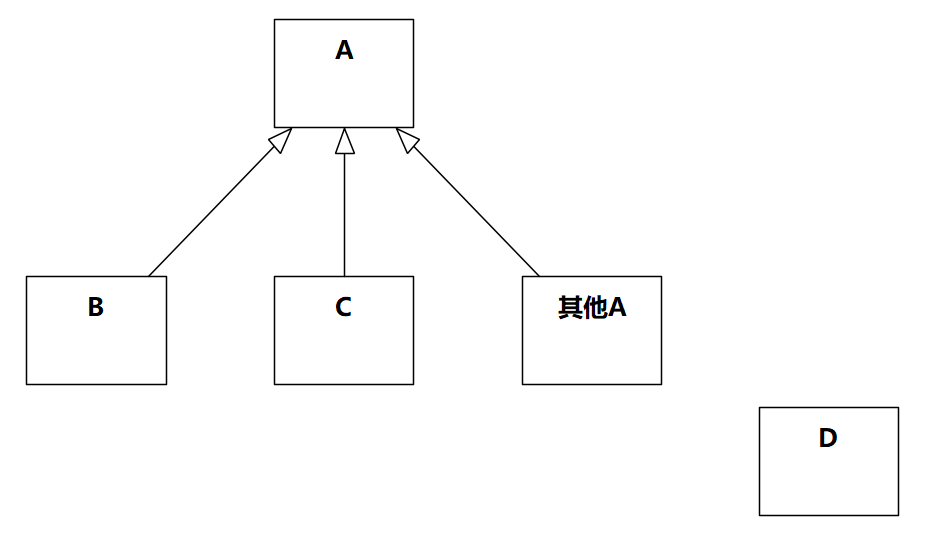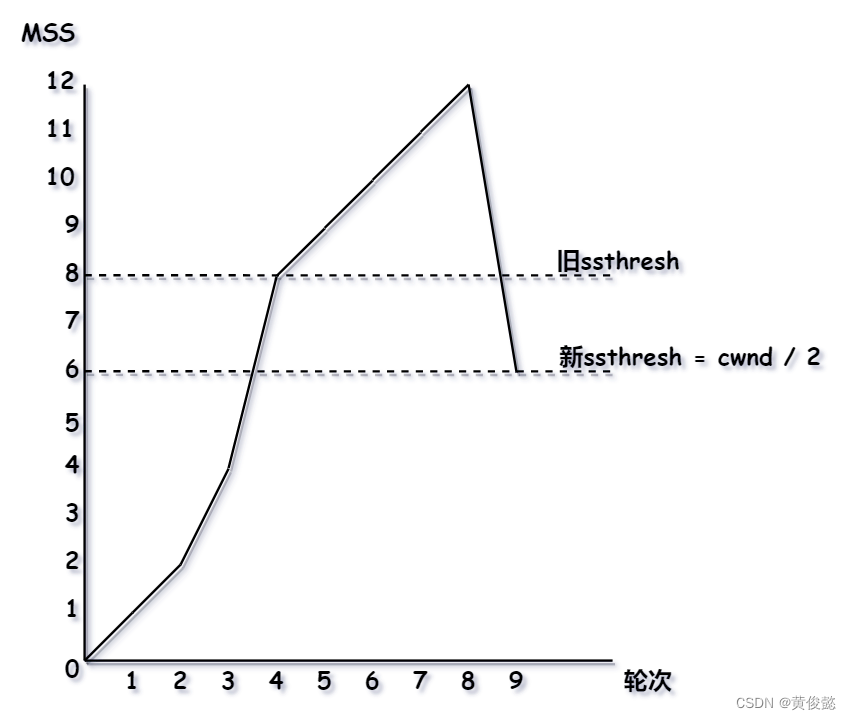Verb Tenses and Passives
Course Certificate
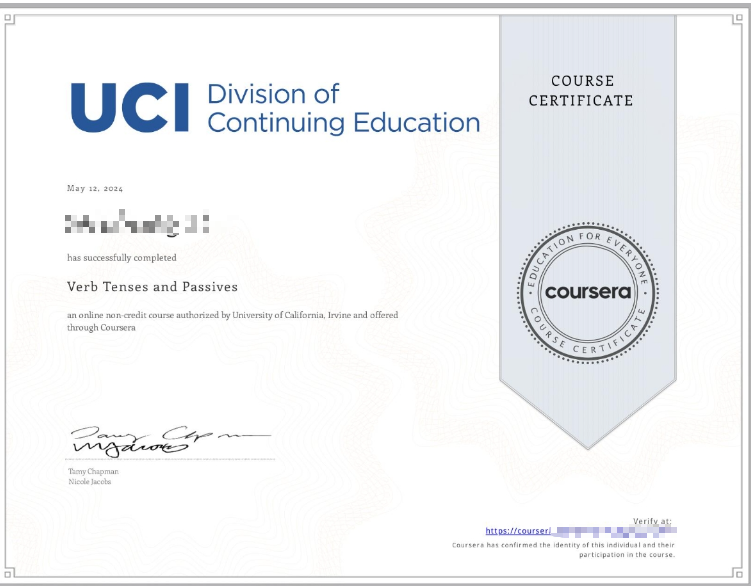
Course Intro
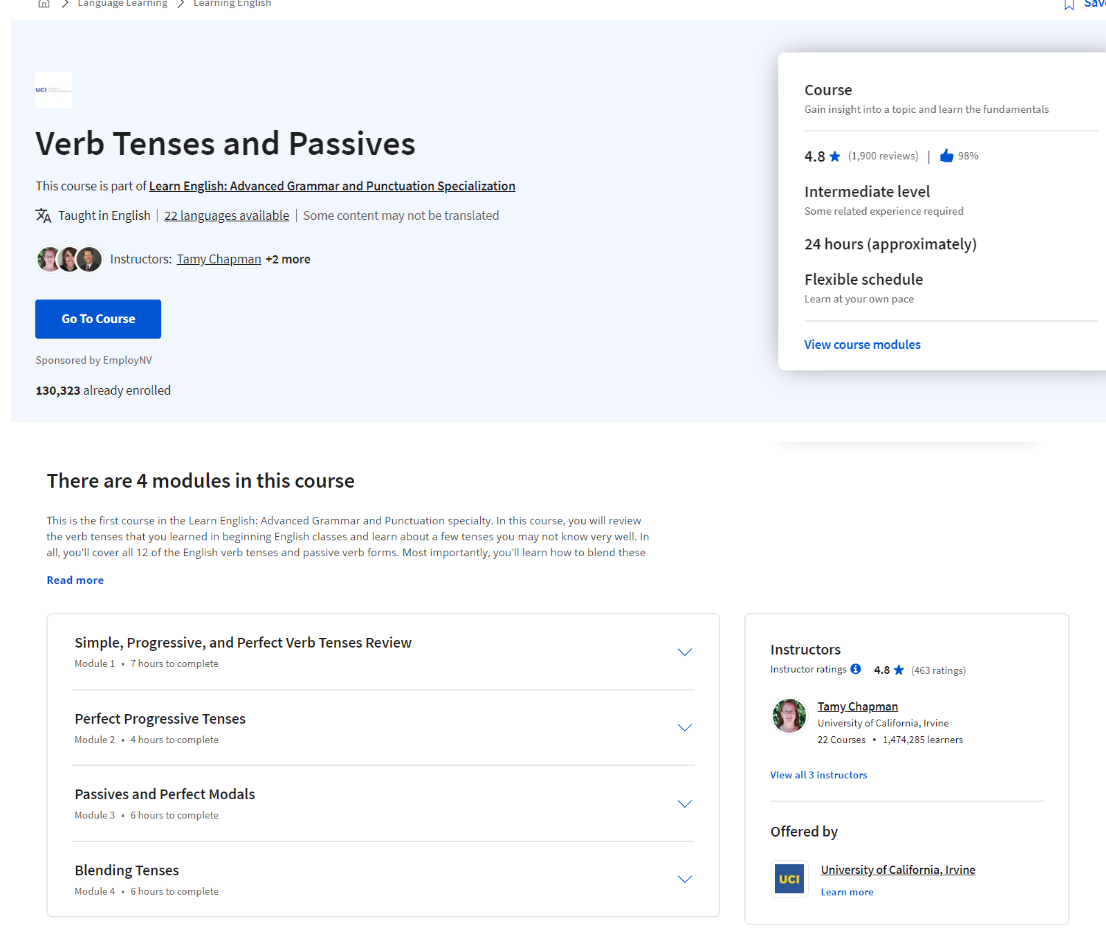
本文是学习 Verb Tenses and Passives 这门课的学习笔记。
文章目录
- Verb Tenses and Passives
- Week 01: Simple, Progressive, and Perfect Verb Tenses Review
- Learning Objectives
- Present Perfect Tense Review Lecture
- Present Perfect Review Practice Quiz
- Present Perfect Practice
- Present Tenses Lecture
- Present Tenses Practice Quiz
- Present Tenses Practice
- Past Tenses Review Lecture
- Past Tenses Practice Quiz
- Past Tenses Practice
- Future Tenses Review Lecture
- Future Tense Review Practice Quiz
- Future Tenses Practice
- Past Perfect and Future Perfect Review Lecture
- Past Perfect and Future Perfect Practice Quiz
- Past Perfect and Future Perfect Practice
- Graded Assignment: Verb Tense Review Assignment
- Graded Quiz
- Week 02: Perfect Progressive Tenses
- Learning Objectives
- Present Perfect Progressive Lecture
- Present Perfect Progressive Practice Quiz
- Present Perfect Progressive Practice
- Past Perfect Progressive Lecture
- Past Perfect Progressive Practice Quiz
- Past Perfect Progressive Practice
- Future Perfect Progressive Lecture
- Future Perfect Progressive Practice Quiz
- Future Perfect Progressive Practice
- Graded Assignment: Perfect Progressive Assignment
- Graded Quiz
- Week 03: Passives and Perfect Modals
- Learning Objectives
- Making Guesses about the Past Lecture
- Making Guesses about the Past Practice Quiz
- Making Guesses about the Past Practice
- Expressing Regret about the Past Lecture
- Expressing Regret Practice Quiz
- Reading: Expressing Regret Practice
- More Modals Part 1 Lecture
- More Modals Part 2 Lecture
- More Modals Practice Quiz
- More Modals Practice
- Passive Verbs Lecture
- Passive Verbs Quiz
- Passive Voice Practice
- Graded Assignment: Modals and Passives Assignment
- Graded Quiz
- Week 04: Blending Tenses
- Learning Objectives
- Future Time Clauses Lecture
- Future Time Clauses Practice Quiz
- Future Time Clauses Practice
- Mixed Tenses Part 1 Lecture
- Mixed Tenses Part 1 Practice Quiz
- Mixed Tenses Part 1 Practice
- Mixed Tenses Part 2 Lecture
- Mixed Tenses Part 2 Practice Quiz
- Mixed Tenses Part 2 Practice
- Warm-up Activity
- Verb Tenses Review Lecture
- Verb Tense Review Practice Quiz
- Graded Assignment: Final Mixed Verb Assignment
- Graded Quiz
- 后记
intransitive verb: 不及物动词
itinerary: 美 [aɪˈtɪnəreri] 计划好的路线;预定行程;
twist my ankle: 扭伤脚踝
bagel:美 [ˈbeɪɡl] 面包圈
alibi:美 [ˈæləbaɪ] 不在现场的证词;借口;托辞
Week 01: Simple, Progressive, and Perfect Verb Tenses Review
In the first week of this course, you will get to know your classmates and review the verb tenses of English that you have probably learned before. It’s always important to review and make sure your foundation is solid before learning new grammar. Use this week to fill in any gaps you have in your understanding of nine verb tenses of English.
Learning Objectives
- • differentiate between simple past and present perfect tenses
- • use present perfect tense correctly
- • correct mistakes with simple present and present progressive
- • explain the uses of simple past and past progressive tenses
- • use simple past and past progressive correctly
- • use several different grammar structures to talk about the future
- • explain the purpose of past perfect and future perfect tenses
- • form the past perfect and future perfect tenses correctly in sentences
Present Perfect Tense Review Lecture
Present perfect tense review. Hi, my name is Jake and today I’ll be teaching you a review
of the present perfect tense. How do we form the present perfect tense? We need two words to form this tense,
the helping verb have and the past participle of the verb. For example, in the sentence
I have eaten breakfast today. Have is the helping verb and eaten is
the past participle of the verb eat. Here are some examples
with different subjects. You have studied this before. They have gone home. When we use the subjects I, you, and
they, we use the helping verb have. Compare this to the third
person singular subject, he. He has eaten breakfast today. We still have the two words
needed to form this tense. But for a singular subject
we must change have to has. She has taken the test. It has rained twice this week. What about forming a negative sentence? I have not heard this song before. Simply insert not after the helping verb. He has not finished his project yet. Or we can use the contraction,
which is the shortened form. It is common to use
the contraction in spoken English.

I have traveled to China and India. I have had very short hair,
even shorter than this. I have seen a famous person. Let’s look at what I just said. I have traveled to China and India. I have had very short hair. I have seen a famous person. There’s a famous person in
the background of this picture. When did these actions happen? We don’t know. There is no specific time. Now, let’s compare these
to the simple past tense. I traveled to China in 2009. I traveled to India last March. I had short hair in high school. I saw a famous person eight years ago. Do you notice a difference between
the sentences on the left and the ones on the right? On the left there is no specific time,
I am just listing my life experiences. On the right however,
I mention a specific time. When a specific time is mentioned, it is
not possible to use the present perfect. You must use the simple past. Notice words like last and ago. These are key words that indicate we
use simple past, not present perfect.
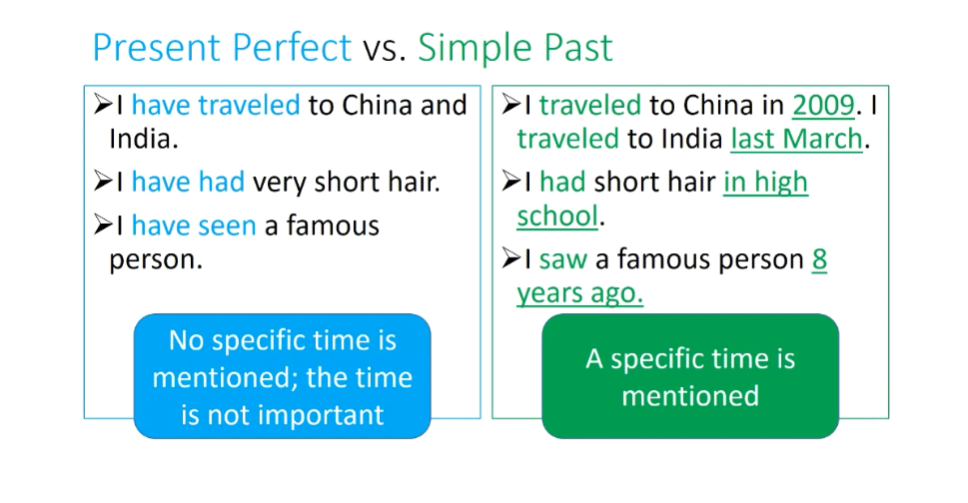
If we use for or since,
we should use present perfect. This is for
an action that hasn’t finished yet. It started in the past and
is still continuing now. For example,
he has worked there for 23 years. She has been on vacation for eight days. I have been in my office for 15 minutes. Notice the word for. We can use for with an amount of time. All of these actions are still continuing. Another key word is since. They have been in Canada since 2013. Use since with a date or
point in time, not an amount of time. I have eaten three apples since
nine o’clock this morning. Or she has studied English
since she was a child. Notice we can use since with a clause. In this case the dependent clause, or the clause that begins with
the word since, is in simple past. The independent clause
uses present perfect.
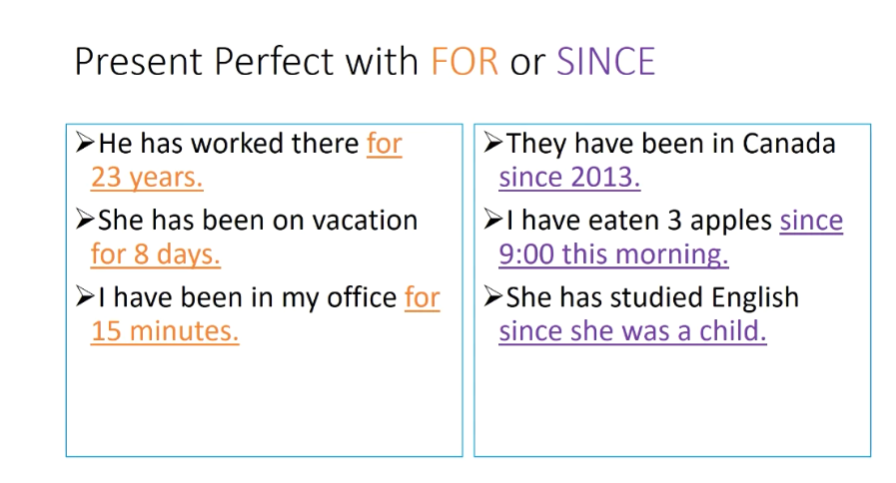
We can also use present perfect
tense with unfinished time periods. For example,
we have taken two tests this month. In this case the month
has not finished yet. I have eaten three apples today. In this case today is not over. And finally I have swum twice so
far this week. Notice the phrase so far. This can be used with
an unfinished period of time. This implies that I will probably
swim again before the week is over.
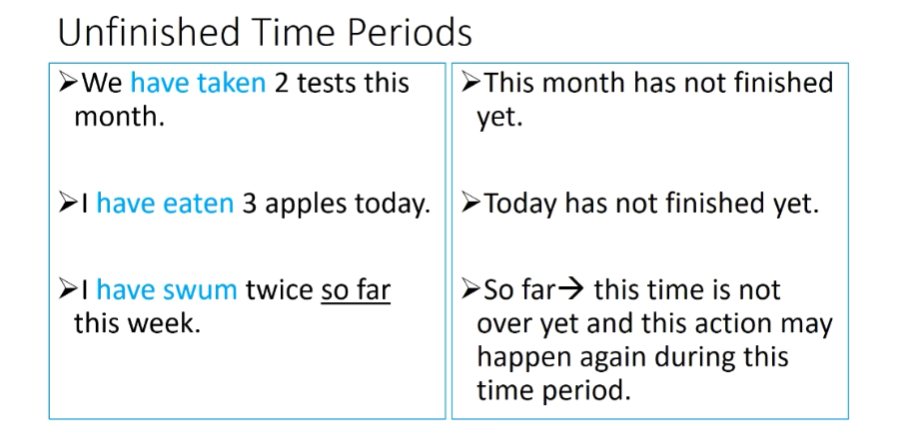
Now let’s learn how to make
questions in present perfect tense. First let’s listen, notice
the questions I ask you in this video. Well now you know a few things about me. You know I’ve traveled out of the country
and you know I’ve swum this week. What about you? Have you traveled out of the country? Have you swum this week? You have already learned how to
form a sentence with this tense. With a subject, and a helping verb,
and a past participle. Now making the question is easy. Move the helping verb to
the place before the subject. In English questions,
a verb comes before the subject. Have you traveled to India? The correct response to this question
is yes, I have or no, I haven’t. This is called a yes, no question because
the only possible answers are yes and no. If we have a third
person singular subject, remember to use has instead of have. For example, has Bob driven a motorcycle? Correct answers are yes,
he has or no, he hasn’t.
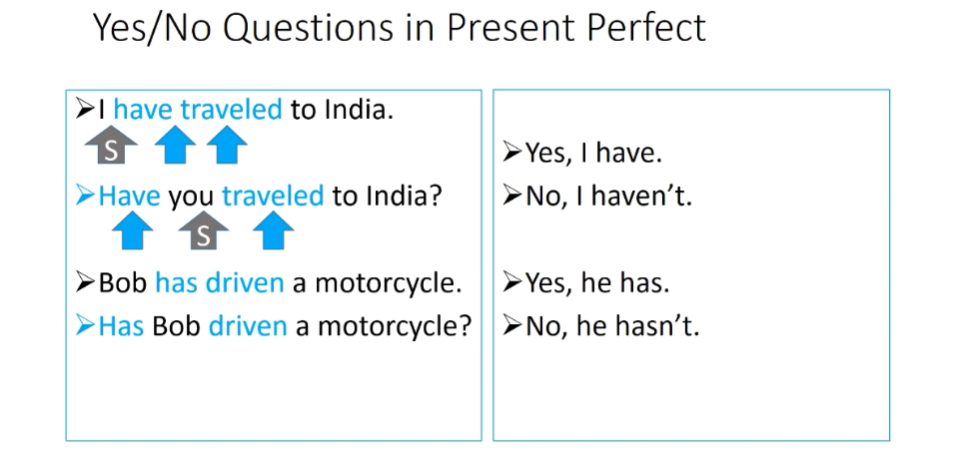
Now let’s look at information questions,
also called WH questions. What has Bob driven? To this question we can answer he has
driven a motorcycle, or a motorcycle. To form a WH question we keep the same
order that we had in our yes, no questions, but
now we had a question word to the front. Here’s another example. Where have you traveled? The answer is I have traveled to India,
or for a shorter answer, to India. So in a WH question
just follow this order. WH word, helping verb,
subject, past participle.
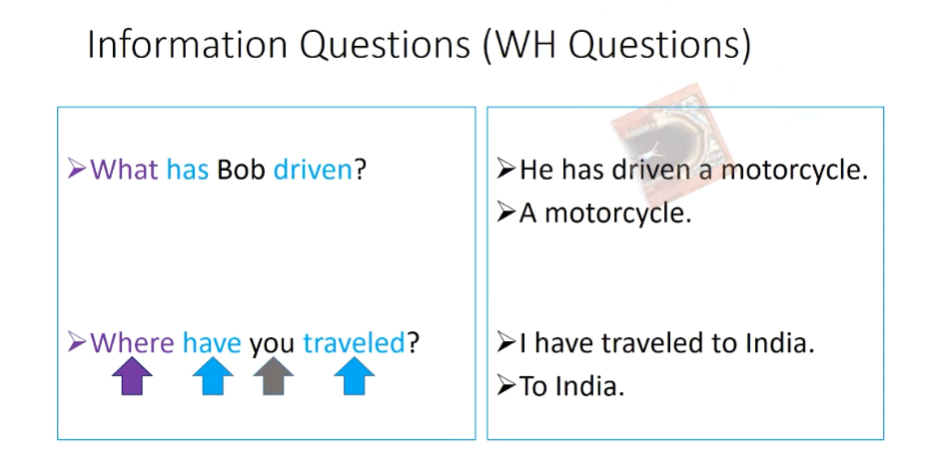
Here’s another example. I have seen that movie three times. Use present perfect with words like once,
twice, or three times. Also I have already seen that movie. Already can be used in affirmative
sentences or questions. Yet and
still are also used with present perfect. I haven’t eaten dinner yet. Have you eaten dinner yet? Yet can be used in negative sentences or
questions. Or I still haven’t gone to the store. Still is used in negative sentences.
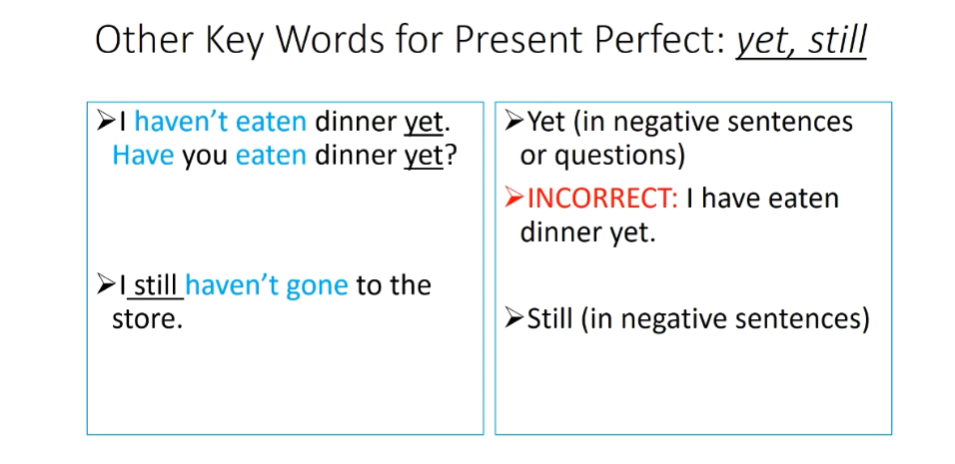
Finally, have you ever met me? I haven’t ever met you. Or I’ve never met you,
and you’ve never met me. Ever and never are common words for
present perfect. Ever means at any time
in your entire life. It can be used in a question or
a negative sentence.
Present Perfect Review Practice Quiz
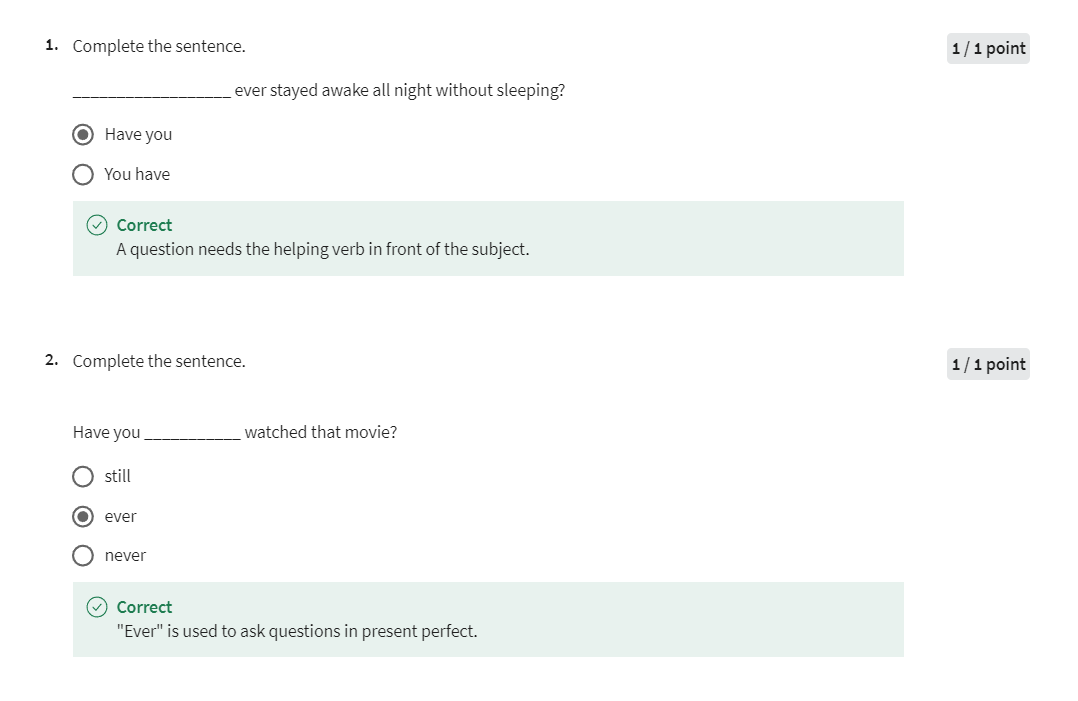
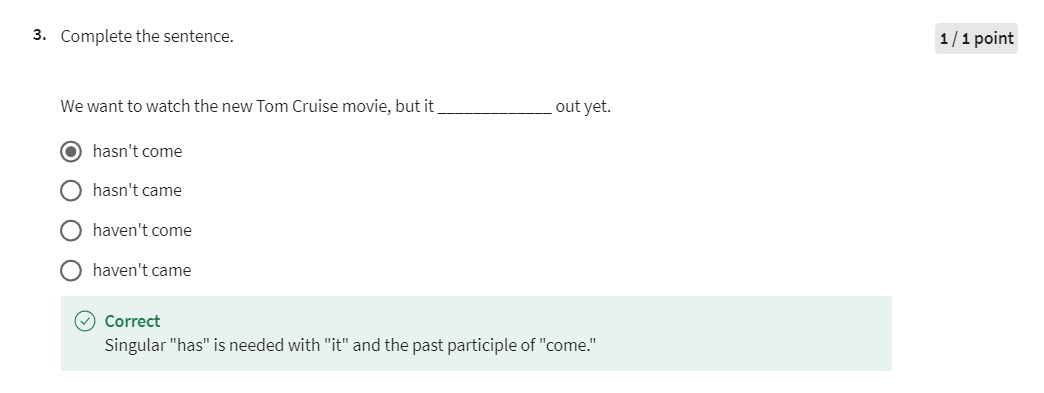
Present Perfect Practice
Practice
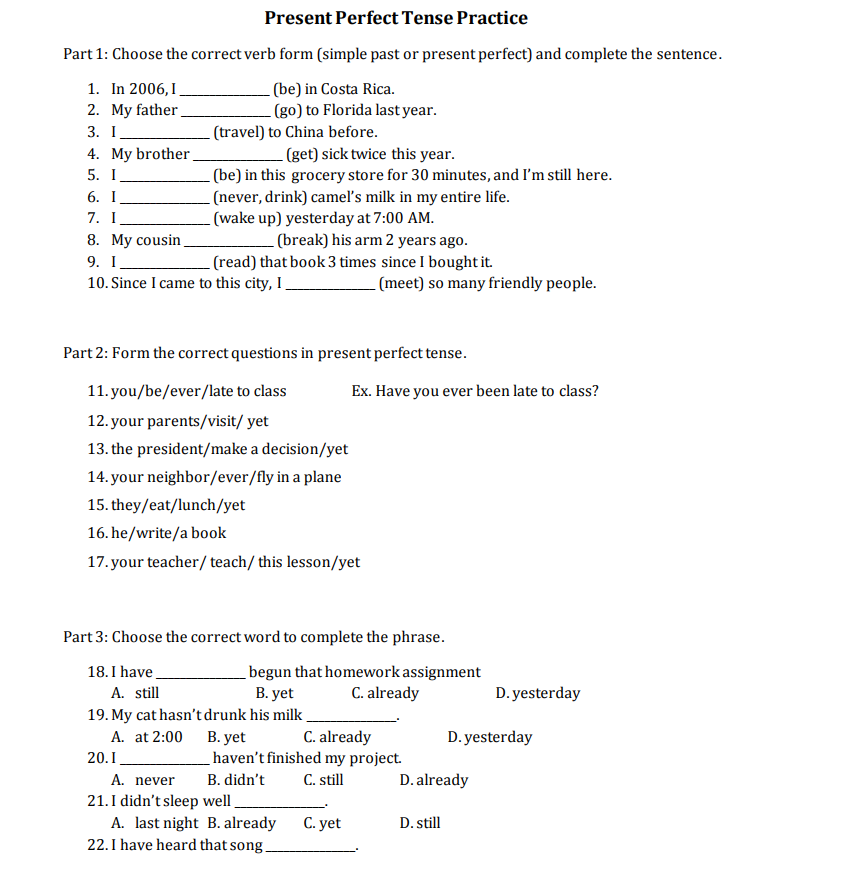
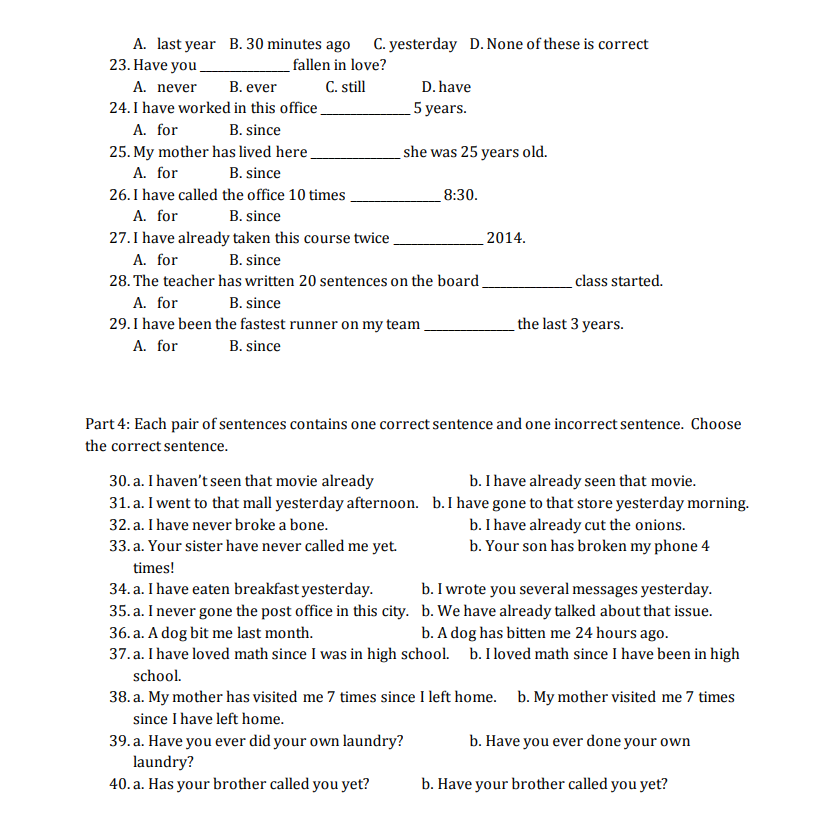
Answer key

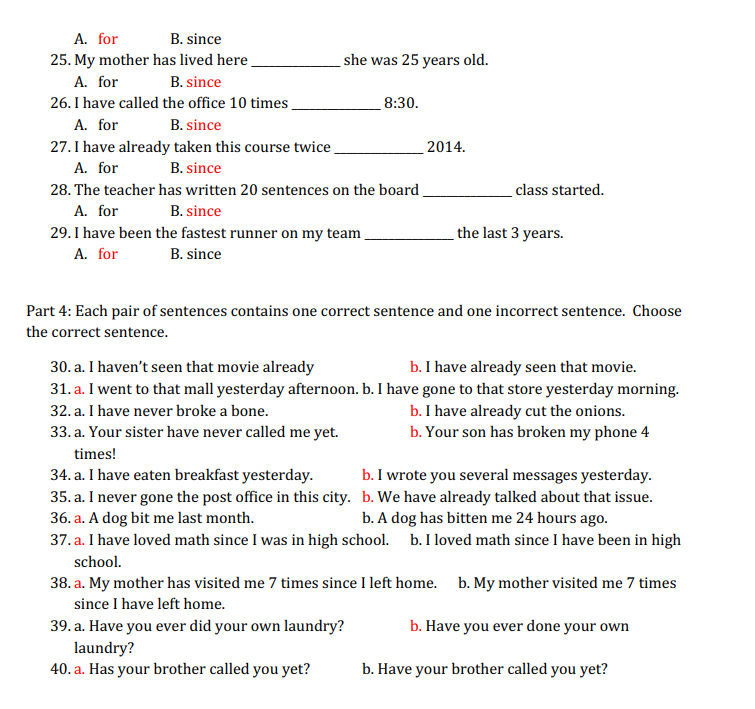
Present Tenses Lecture
Present tense review. Hi, it’s nice to meet you. My name is Emily and
I’m an English teacher. I teach students from all over the world. Right now I’m talking with you. Are you listening carefully? Do you understand me? I hope so,
because we have a lot to talk about. So why don’t we get started? By now, you’re probably very familiar
with present time verbs in English. You know that we use the simple present to
talk about facts or daily habits and that we use the present progressive to talk
about activities in progress right now. In this lesson, we will review
present tense verb forms and uses.
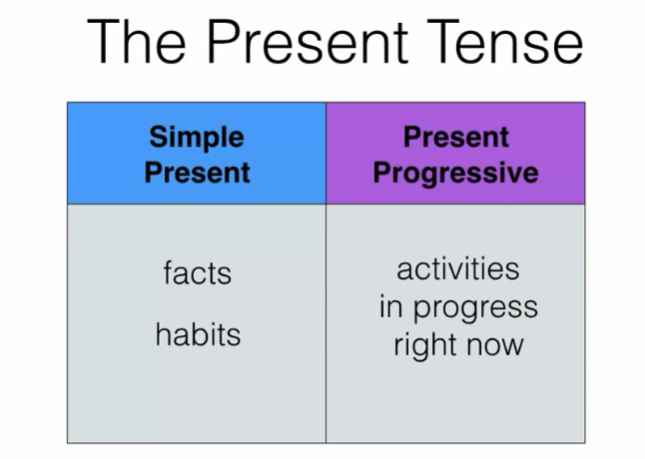
Let’s start with the form
of the simple present. It’s important to remember that
third person singular subjects get an s at the end of the verb. For example, this lesson seems easy. It’s also important to remember
that the BE verb is unique. Remember if I am,
he she it is you they we are. For example I am a teacher. This course is fun. And you are an awesome learner! To make questions in the simple present,
we need the auxiliary verb do and does. For example, do you like grammar? Does this lesson interest you? Of course it does! Who doesn’t love grammar? And finally, to make a negative statement,
we will also use the same auxiliary verb. Doesn’t and don’t are the contraction
forms for does not and do not. For example, I love grammar,
but I don’t like math. [SOUND]
Okay, let’s quickly review
how to form the present progressive. We need the BE verb,
which we just mentioned, as well as a verb with ing,
that would be the main verb. We must have both of these whenever we
want to form the present progressive.
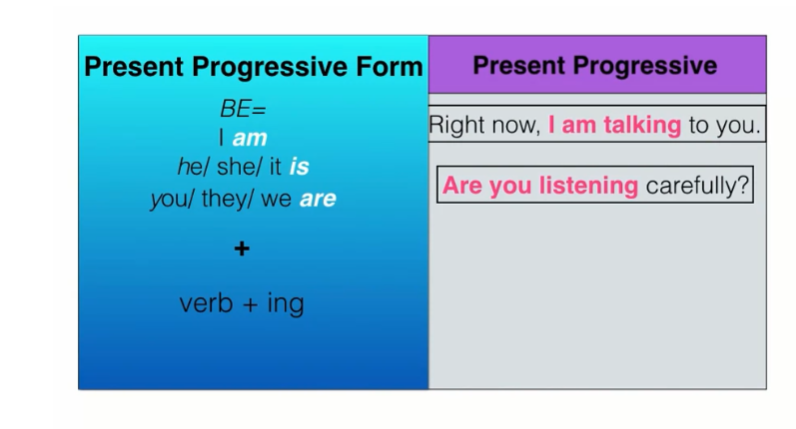
Okay, to make a question in
the present progressive form, we need these same two components. However, we will switch BE and
the subject, so the order’s a little different
from the statement form. For example are you thinking
about how much you love grammar? I know I am. Okay, finally, to make a negative
statement, of course we need nots. For example, you and I are not looking at each other but
I’m still communicating with you. [BLANK AUDIO]
Okay as I already mentioned, we know that we use the simple present
to talk about facts and habits. And the present progressive to talk
about activities in progress right now. Remember when I introduced myself
at the beginning of this video? I used the simple present and
the present progressive. Let’s take another listen
at my introduction so that we can look at why I
used the tenses that I did. Hi, it’s nice to meet you. My name is Emily and
I’m an English teacher. We use the simple present to express
states and unchanging facts. As you can see, we have the BE verb here, which is
a verb of state, not a verb of action. I teach students from all over the world. We also use the simple present to
talk about habits or daily routines. I am not teaching in my classroom
right now, I’m talking to you, I’m making a video. However, I regularly teach
students from all over the world. Right now, I am talking with you. Are you listening carefully? Why did I use the present
progressive here? That’s right, I used it because I’m
talking about an activity in progress, right now, at the moment of speaking. Do you understand me? I hope so. Which tense did I use here? Yep, you know I used the simple present,
because you don’t see I-N-G.
Even though we’re talking about right now,
I did not use the present progressive because understand and hope are verbs of state. Okay, Helen is the student of English and like many students she got a paper
back with a lot of red marks on it. So she has some corrections to make. Do you think you can help
her with her grammar? Let’s see. What’s the problem here? That’s right. We need the present progressive. These days, the world is becoming smaller. What tells us that we’re talking about
right now is the phrase these days.
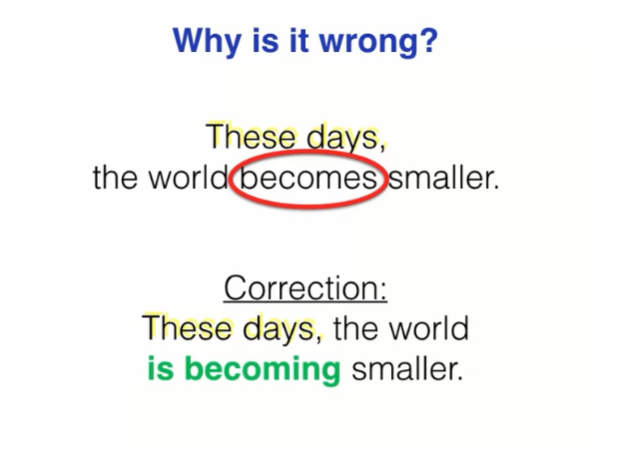
Okay, let’s look at another mistake. Uh-oh, now it’s the opposite problem. We need the simple present. Why? That’s right, because we see each
time which indicates a habit. So we’re going to use the simple present.
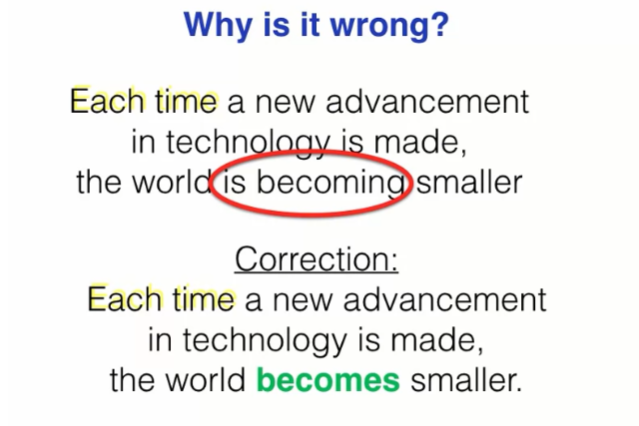
Ooh, this is a really ugly mistake here. What’s the problem? Something is missing. That’s right. We can’t have I-N-G without the be verb. In this case we need are. Nowadays, many schools are trying to
use more technology in their classes. You also see nowadays which tells
us we’re talking about right now or an activity in progress. Another ugly error. What’s the problem here? You guessed it! We cannot use the b verb
if we don’t have I-N-G. In this case,
we just need the simple present. Many students study english
with the help of technology. It’s a fact. Can you find the mistake in this sentence? You’re right, we do not want
the present progressive here. It should be do not see their mistakes. We need the simple present,
because see is a verb of state. All right, good job,
I told you it would be easy. Thank you for reviewing the simple
present and the present progressive. See you next time.
Present Tenses Practice Quiz
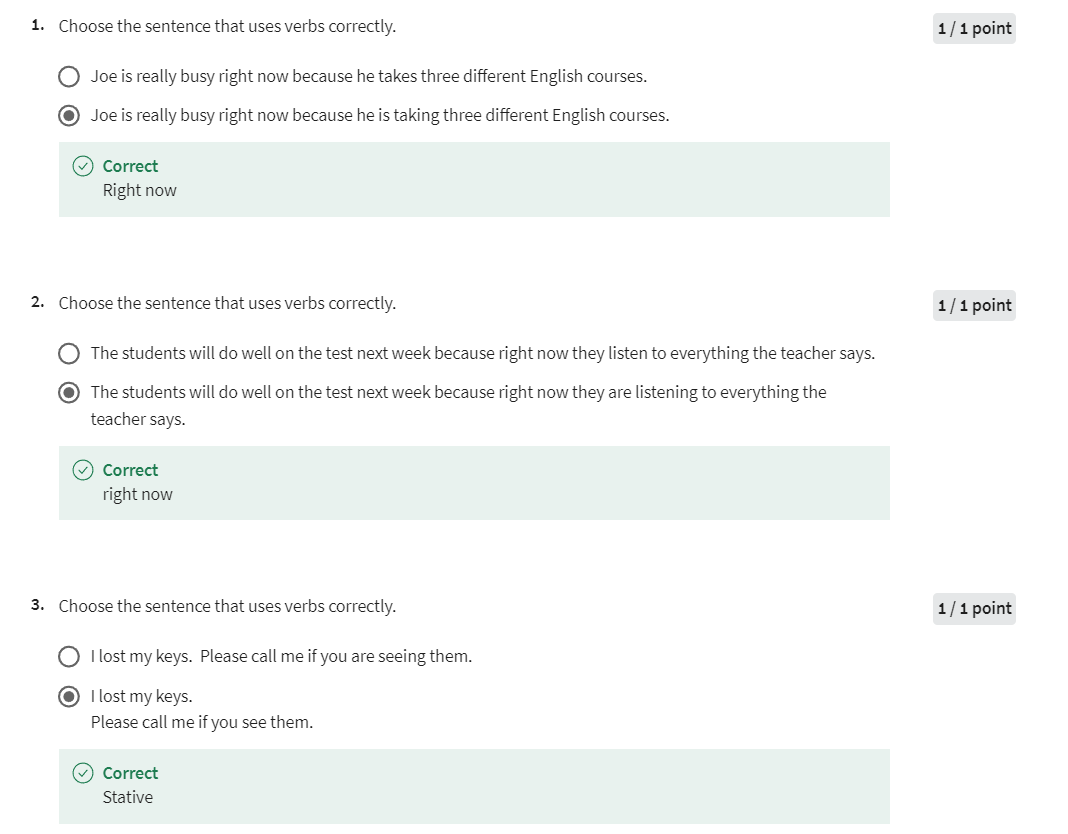
Present Tenses Practice
Practice
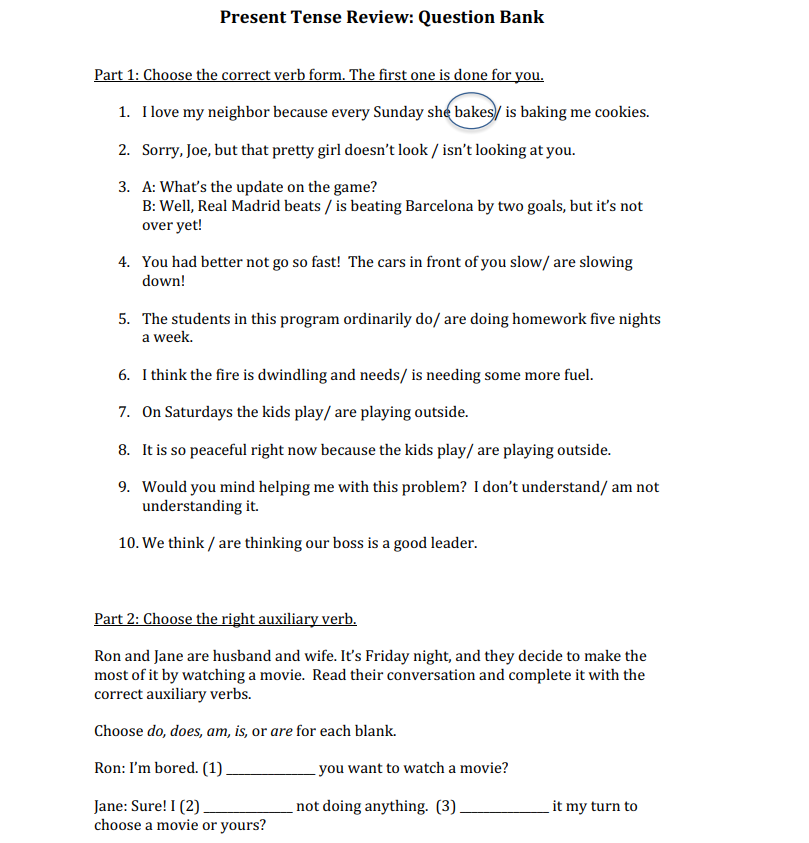
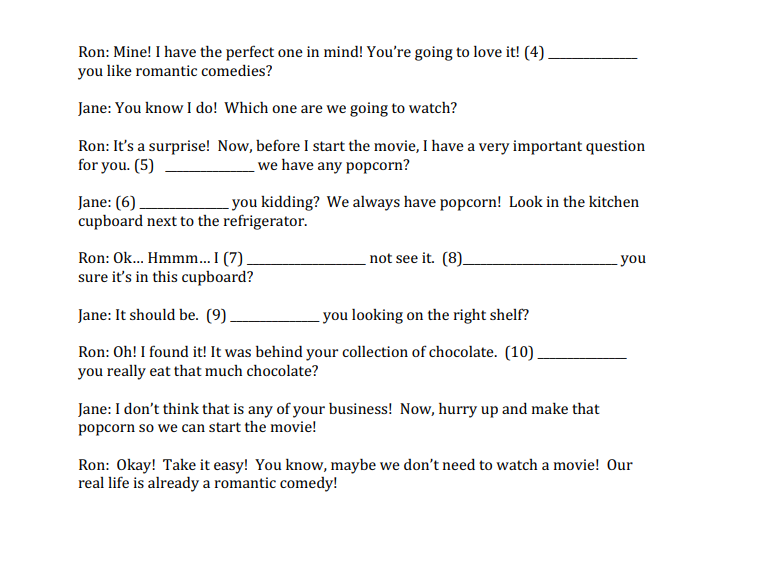
Answer key
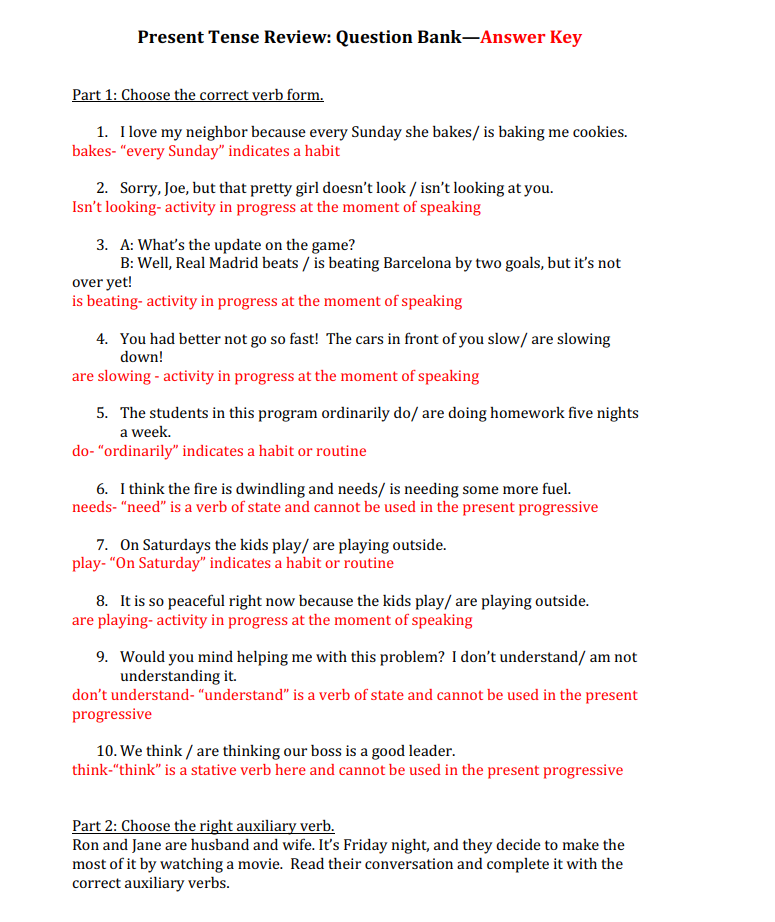
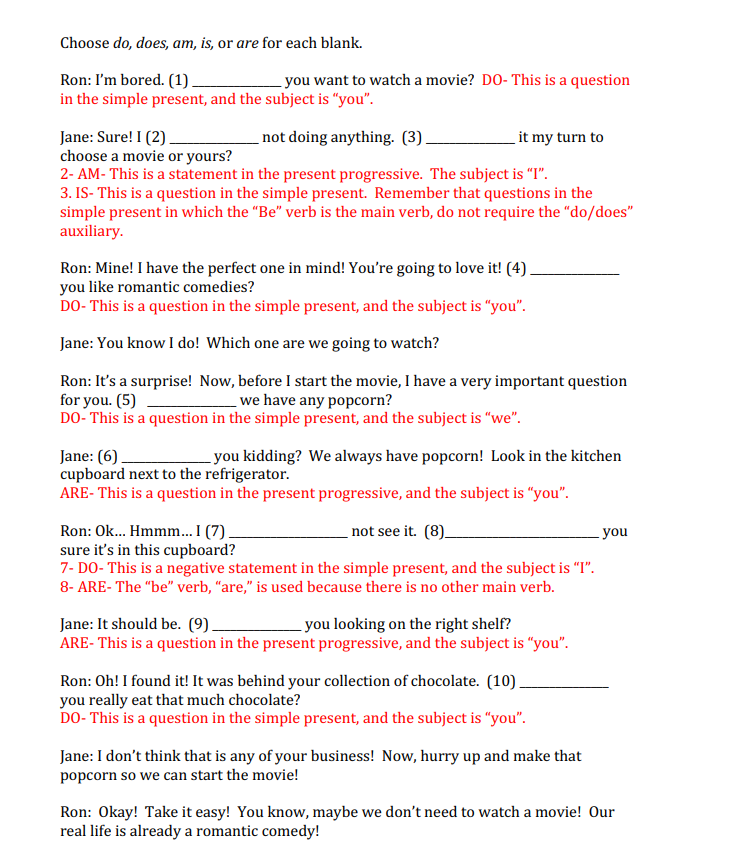
Past Tenses Review Lecture
Past tense review. As you already know,
affirmative statements in the simple past are made by a attaching an -ed to
the simple forms of regular verbs. For example, most days I work for 8 hours,
but yesterday I worked for 12 hours! I arrived at work at 7:00 A.M. and stayed in my office until 7:00 P.M.
Whoo, that was a long day. Of course you have already
learned that there are many irregular verbs in English that do
not follow this conjugation rule. For example,
Julie usually walks to school, but last Friday it rained,
so she rode the bus instead. That day,
she left work early because she was tired. Rode, left, and was are all examples of irregular verbs in the past. If you don’t remember all of
your irregular verb forms, now would be a good time to
pause the video and review them.
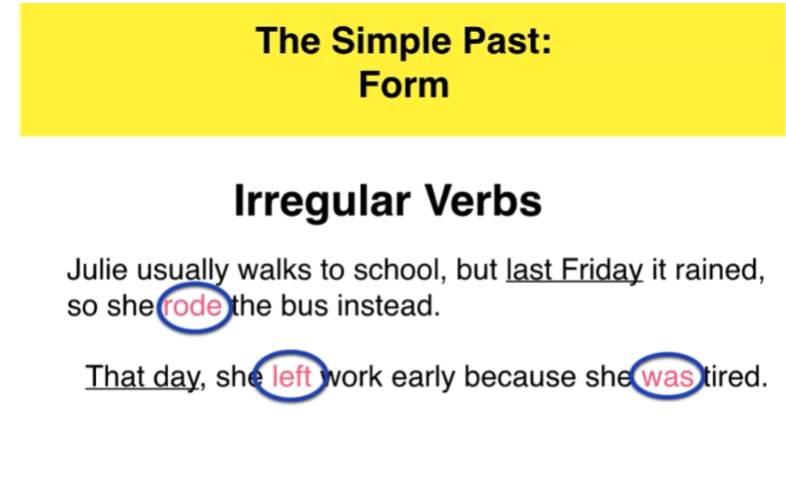
All right, in this example, there is one verb that has
a regular past tense conjugation. Can you find it? Yep. Rained. You know it’s regular
because it has an -ed. To make negative statements and questions
in the simple past, we need the auxiliary verb did or did not, and
the simple form of the main verb. [SOUND]
Did you steal my chocolate? >> No, I didn’t steal your chocolate. >> [LAUGH]
Okay, so why do we use the simple past? Well, we use it to talk about
completed past actions. We can see that they have
a clear beginning and an end. Also we often use this tense with
past time words like yesterday, last year, three minutes ago, etc. And finally, the simple past may be used
to express a sequence of past activity. Let me show you what I mean.
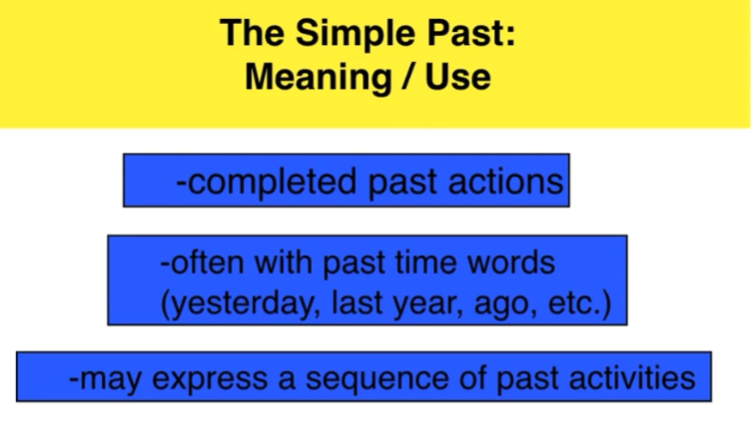
Let’s talk a little bit about my Saturday. It was very busy. In the morning, I read a book. Then I rode my bike. After that, I went for a walk. Then I took a nap. Later, I cooked dinner. Finally, I watched TV. This is a sequence of activities in the
past introduced by expressions of time. This is a very common
use of the simple past.
Another way to talk about past actions
is by using the past progressive. The past progressive is formed
with the past tense conjugations of the verb to be and
a present participle or verb plus ing. For example, when I arrived at
work yesterday, it was raining. When I returned home,
however, the sun was shining. To make a question in the past
progressive, we need a question word, if relevant, was or were, the subject,
and a present participle. For example-
Excuse me, what were you doing at 3 PM? That’s when I was away from my desk and
someone stole my chocolate. >> I didn’t do it. I was working on a report. So I didn’t steal your chocolate.
We use the past progressive to talk
about an activity in progress in the past. We can only use action verbs
with the past progressive. No verbs of state. Just like with other progressive tenses. And the past progressive often
appears with another action either in the simple past or
past progressive.
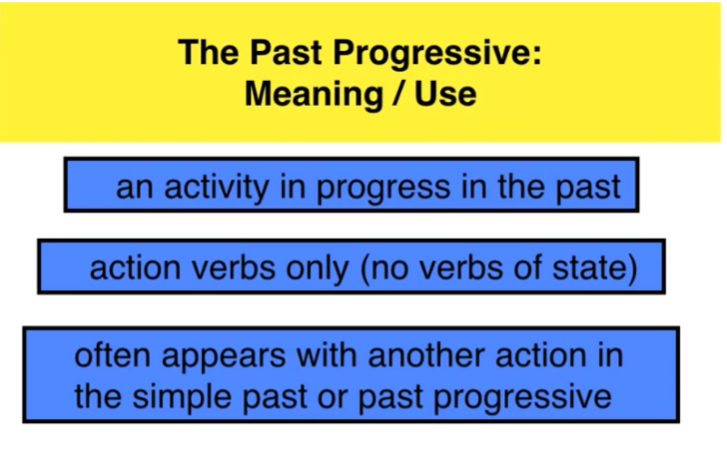
Let’s go back to my busy Saturday
to understand a little bit better. I read, rode my bike, went for a walk,
took a nap, cooked dinner and watched TV. We can see each of these
activities in their entirety. That is we know when they started and when they ended because
we used the simple past. However, what happens if we zoom
in on any of these activities? While I was reading,
I was drinking coffee. This is an example of two activities
in progress at the same time.
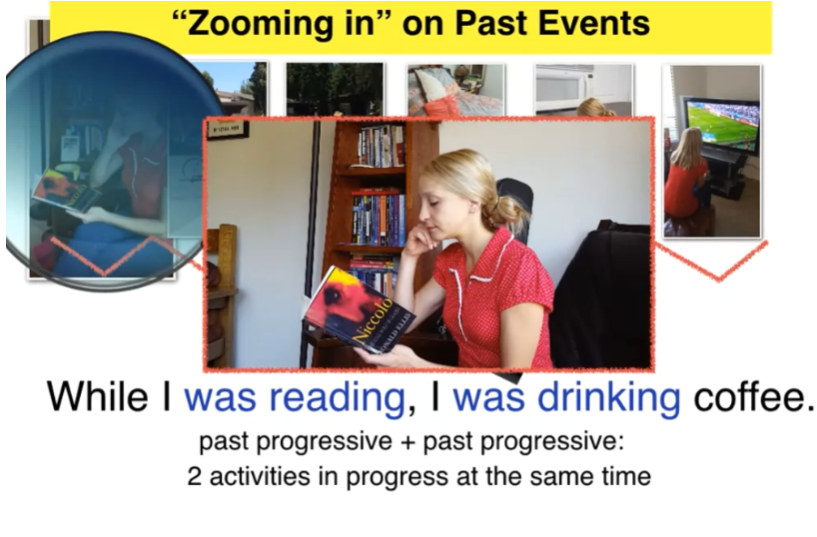
Hey. >> Hey, whoa! >> While I was riding my bike,
someone said hey. This is an example of an ongoing
activity interrupted by another action. And as you can see,
I was dancing while I was walking. Again here we have an example of two
activities in progress at the same time.
Okay, let’s quickly summarize this review. We used both the simple past and the past progressive to talk about
past time events in English. To form the simple past we need an -ed for
regular verbs. But watch out because there are a lot
of irregular conjugations as well. We used the single past to talk
about completed past actions. And this tense is often accompanied
by time words like yesterday. To form the past progressive, we need
was or were, and a present participle. We used the past progressive to
talk about activities in progress. And this tense often appears with
another activity in the past. All right. Did you have fun reviewing
the past tense in English? Were you paying attention while
you were watching the video? I hope so. It’s been fun for me, too. Thank you. See you next time.
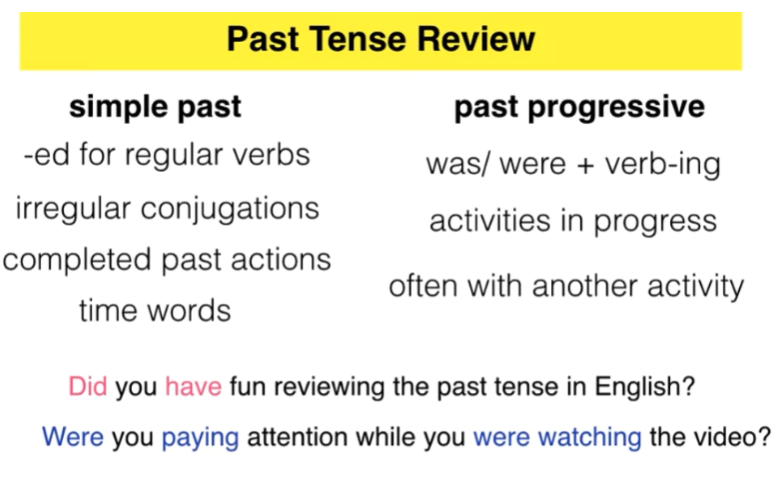
Past Tenses Practice Quiz
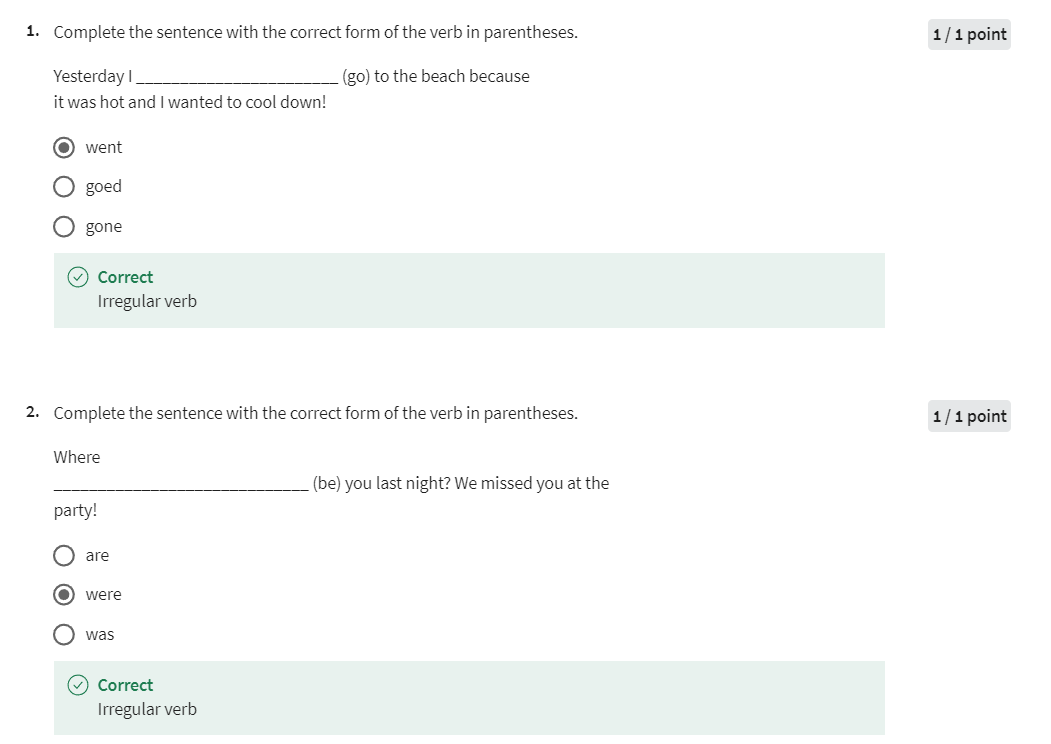
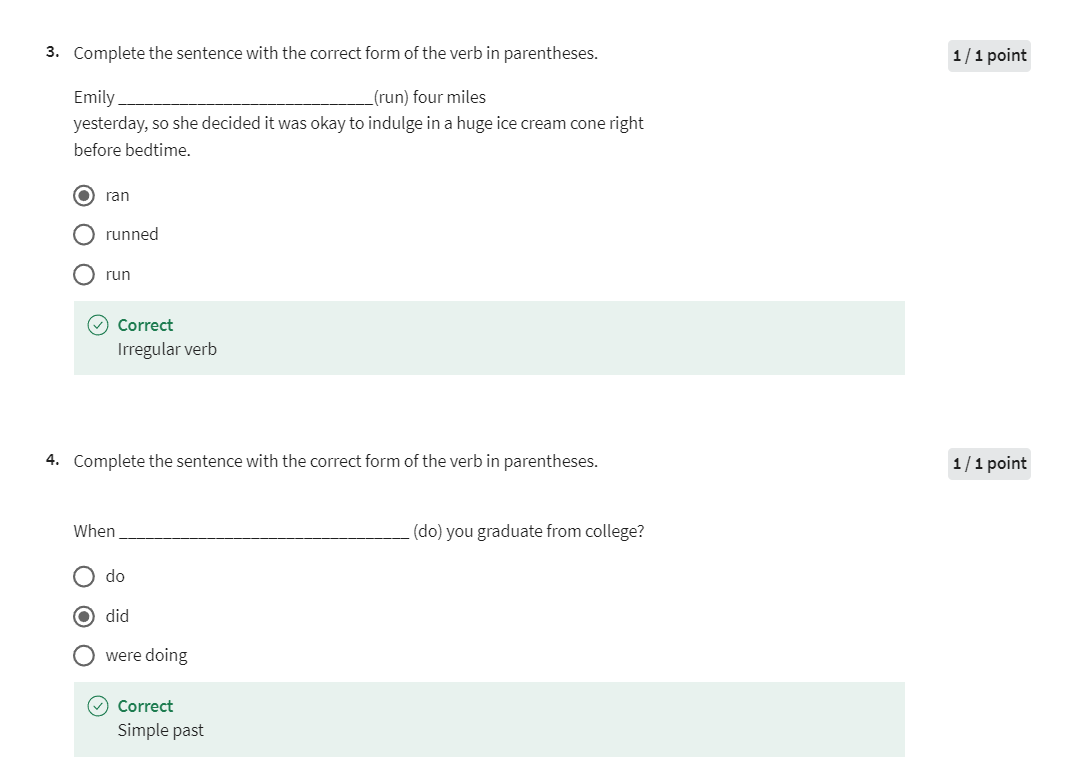
Past Tenses Practice
Practice
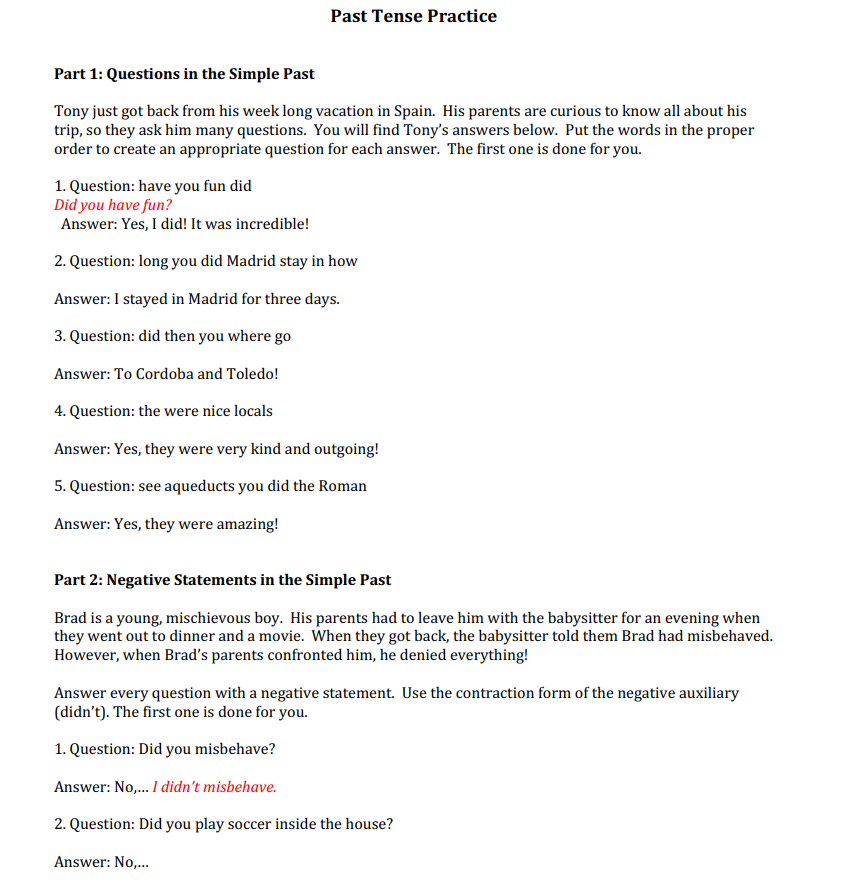
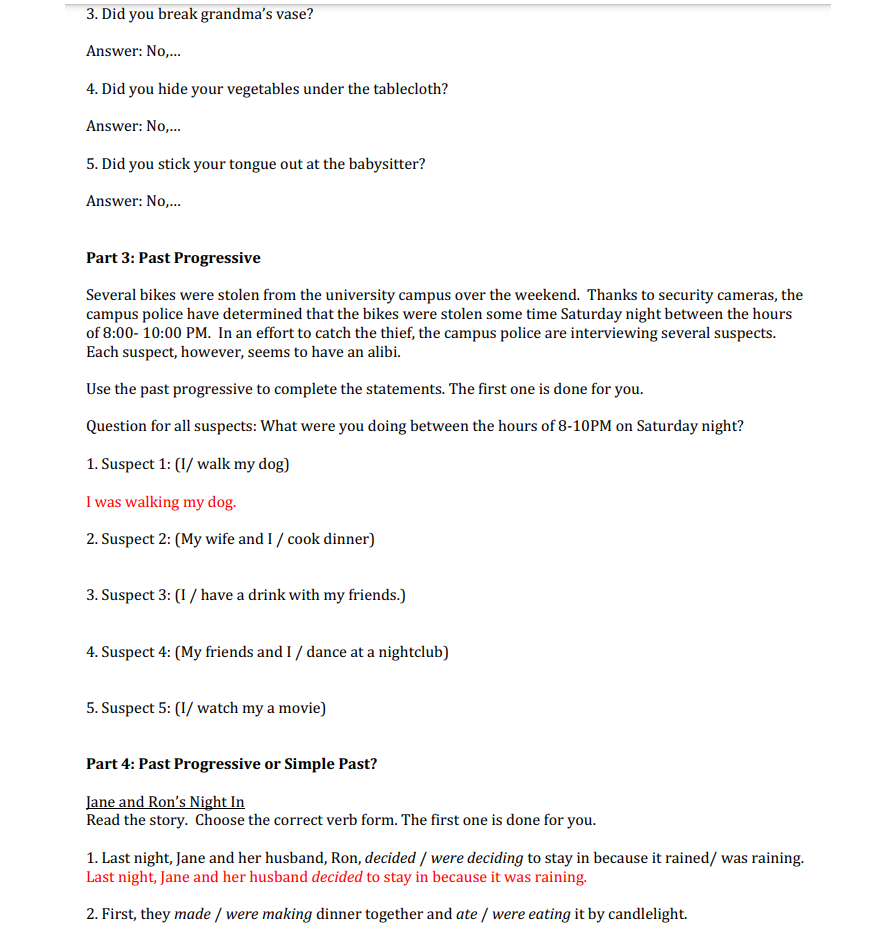
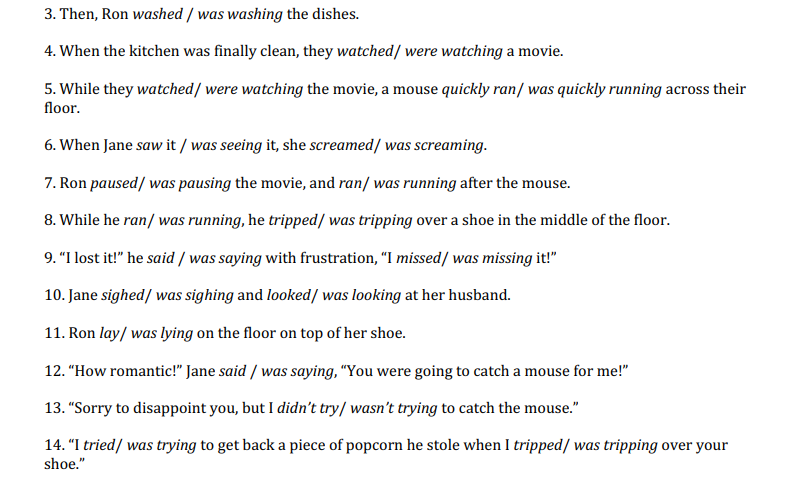
Answer key
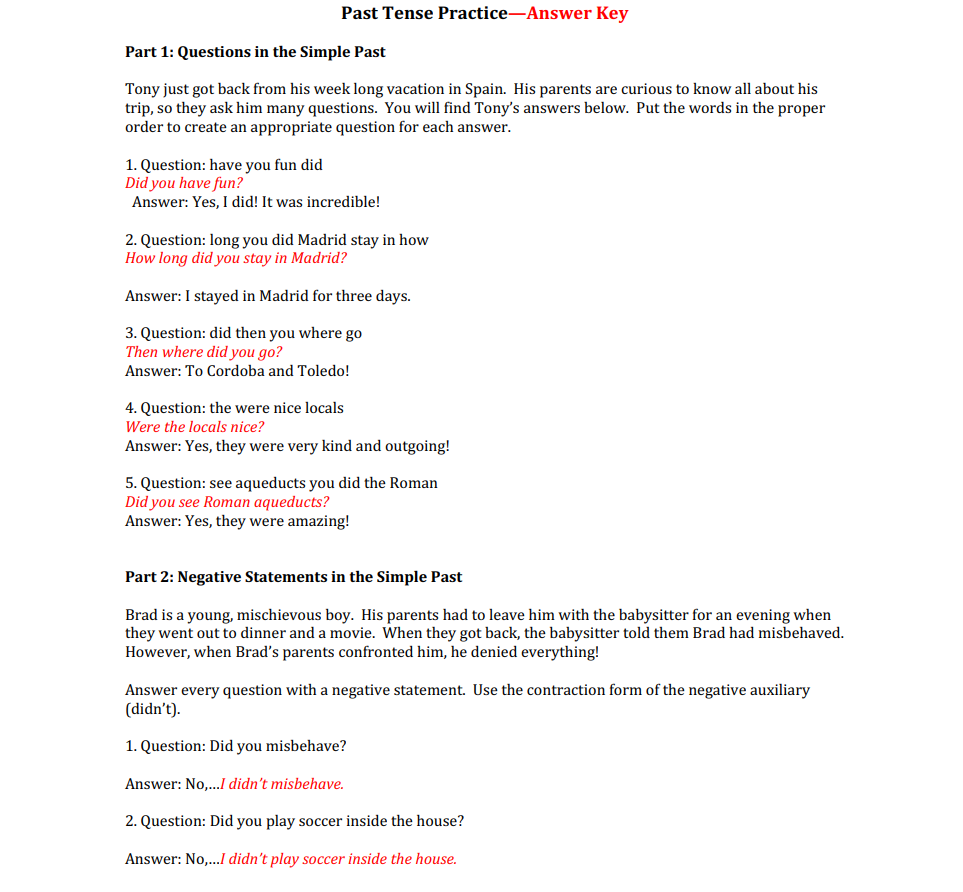
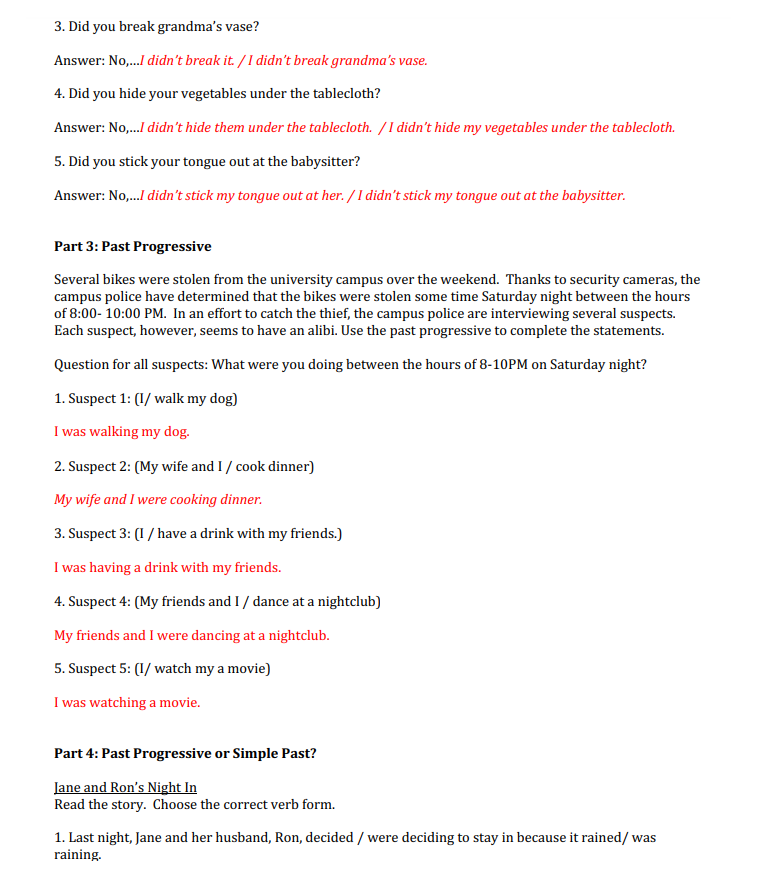
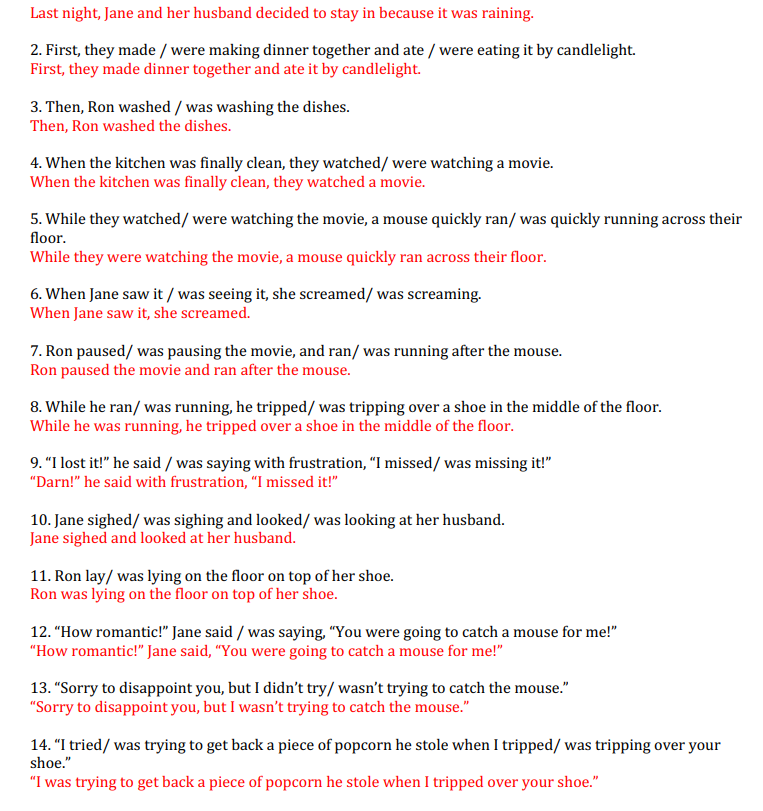
Future Tenses Review Lecture
The future tense. You already know that we use be going
to and will to make predictions. For example,
you are going to love this lesson. You will learn so much.
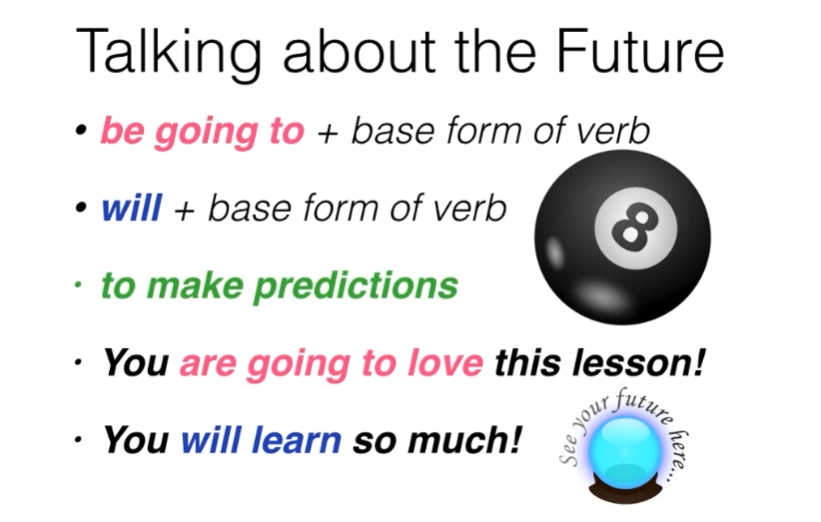
However, will and
be going to can be used differently. Furthermore, there are other verb forms
that we can use to express a future time. Imagine you were bored at
home on a Saturday afternoon. You decide it would be nice to
see a movie later tonight, but you’d rather not go alone. What will your friends say
regarding their plans for tonight which is time in the future? >> I’m bored. I know, I’ll see if someone wants
to go see a movie with me tonight. >> I’m sorry, I can’t. I’m having dinner with a friend tonight,
but thanks. >> I would love to, but
I’ll be flying to New York then. My plane leaves at 7:00 sharp. >> No, thanks,
I’m going to take it easy tonight. >> Yeah, I’ll go see a movie with you. Thanks for asking. Whoo, hoo!
Did you notice all of the different
verb forms we used to talk about the future? Let’s review them together. >> I know, I’ll see if someone wants
to go see a movie with me tonight. I’ll is a contraction for I will. We use will when a decision about the
future is made at the moment of speaking. The speaker wasn’t planning
on seeing the movie, but she decided to do so spontaneously.
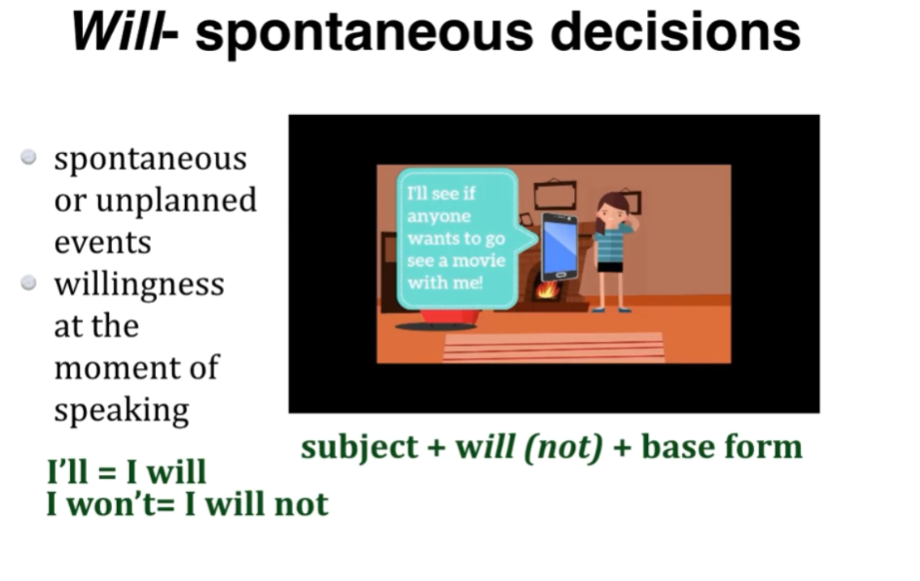
I’m sorry, I can’t. I’m having dinner with a friend tonight. >> What verb tense do you notice here? That’s right,
you see the present progressive. It is also common to use the present
progressive to talk about the future. In this case,
the speaker has already made plans. You will often see this use
of the present progressive to convey future plans with a future
time marker like tonight.
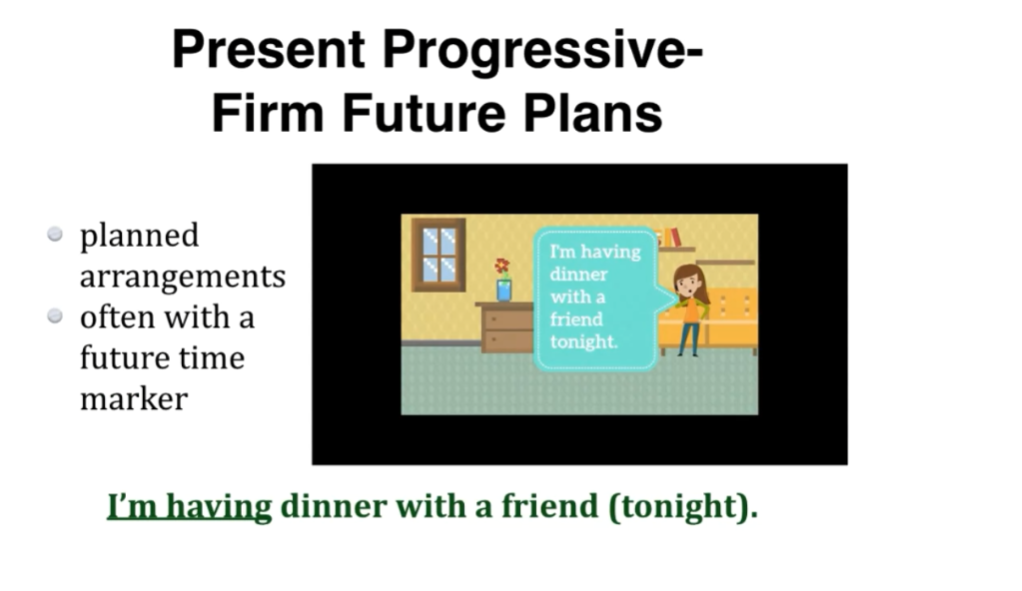
I’ll be flying to New York then. >> This is an example of
the future progressive. We use the future progressive to talk
about an action in the future that will be in progress at a certain time. Remember, no stated verbs with
progressive constructions.
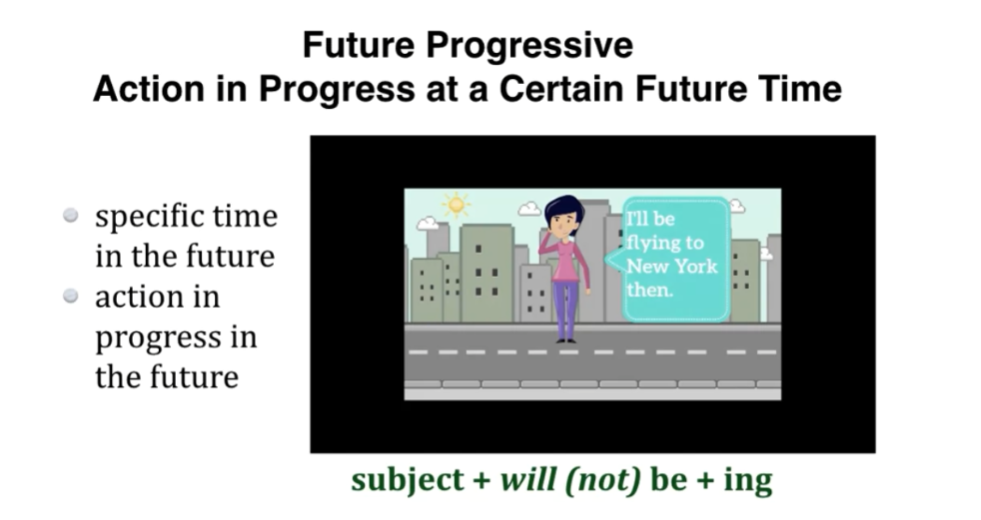
My plane leaves at 7:00 sharp. >> You should recognize this
verb form as the simple present. In this case, it refers to the future. It is common to use the simple present to
refer to the future when talking about schedules or itineraries that
we can’t necessarily control.
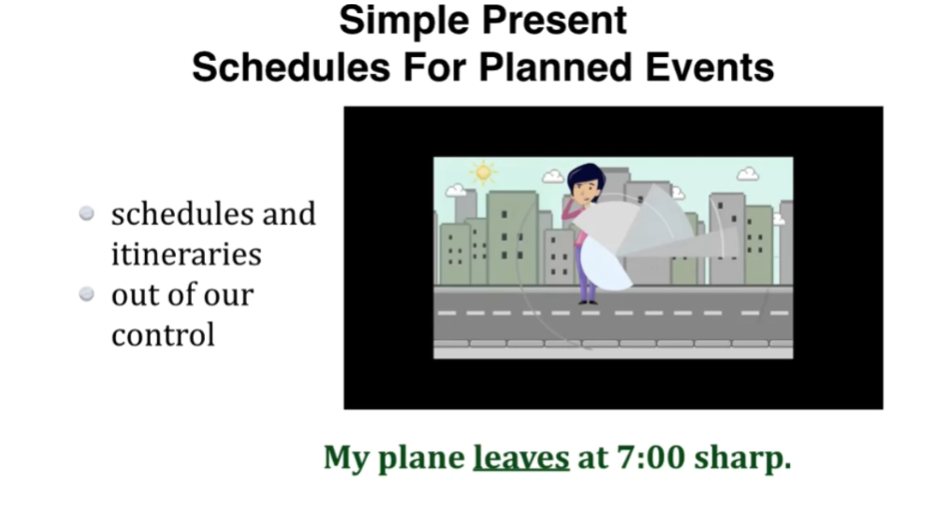
I’m going to take it easy tonight. >> This is a very common way to
express the future which I’m sure you recognize right away. We use be going to to talk
about planned future events. In this case,
the decision was made previously. In spoken English,
be going to sounds like going to.
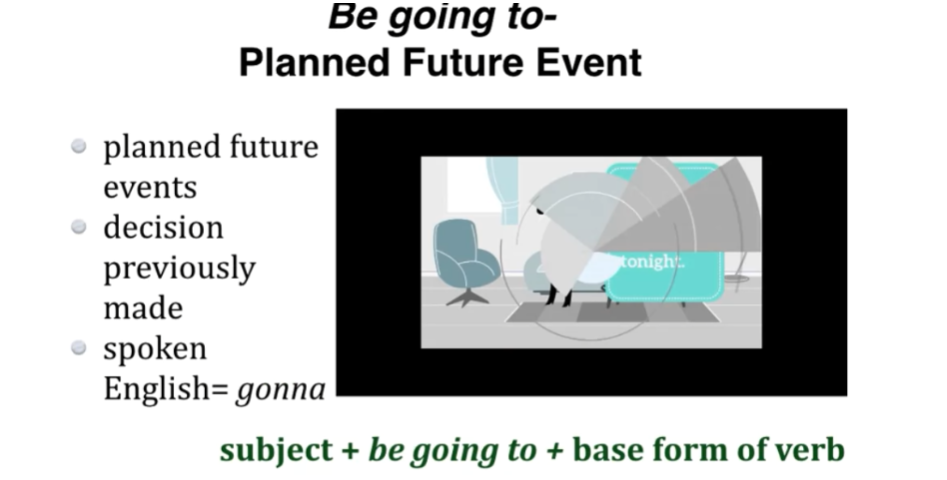
I’ll go see a movie with you. >> Which form is this an example of? You got it, I’ll is I will. Why did the speaker use I’ll or
I will here? Yep, because it was
a spontaneous decision. Okay, let’s review together. All right,
let’s review what we’ve learned. When you want to express
the future in English, you probably think of will and
be going to. And you’re right, these are two
common verb forms we use to express the future in English. However, there are other ways to do so. We can also use the present progressive, the simple present and the future
progressive to talk about the future. When we use will,
we use it to make predictions and for spontaneous decisions made
in the moment of speaking. With be going to,
we also use it to make predictions but in addition, we use it for planned events. With the present progressive,we
can talk about the future if we have definite plans. And this usually is used with
a future time marker like later, tomorrow, this evening. We can also use the simple present
to talk about the future when we’re referring to itineraries and schedules
that are set and that we can’t control. And, finally, we use the future
progressive to talk about future actions in
progress at a given time. Thank you for reviewing with me. Remember to keep looking forward.
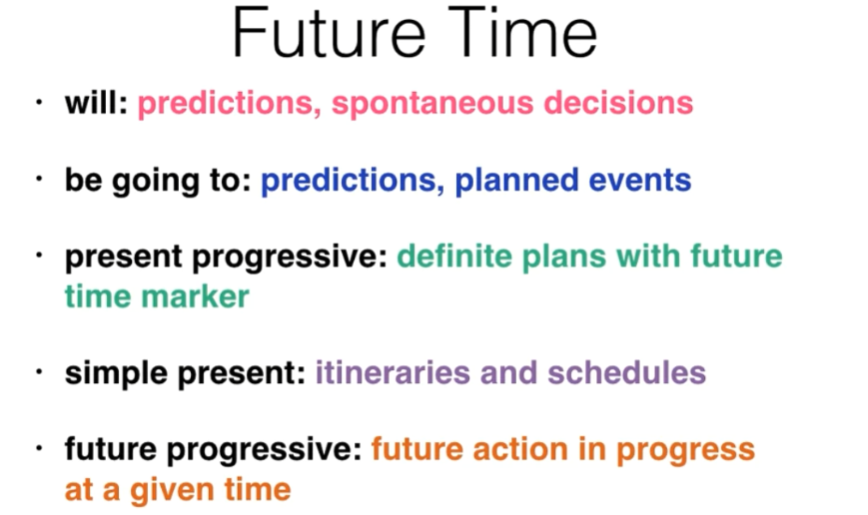
Future Tense Review Practice Quiz
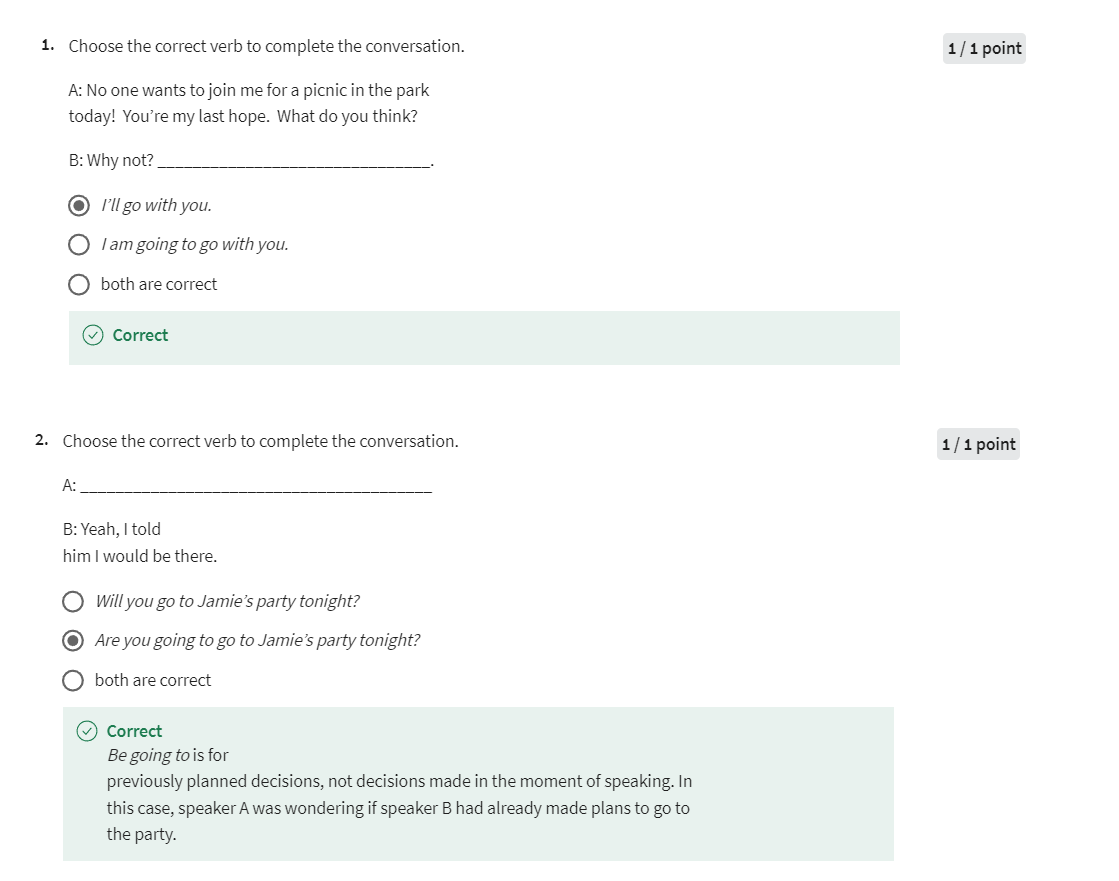
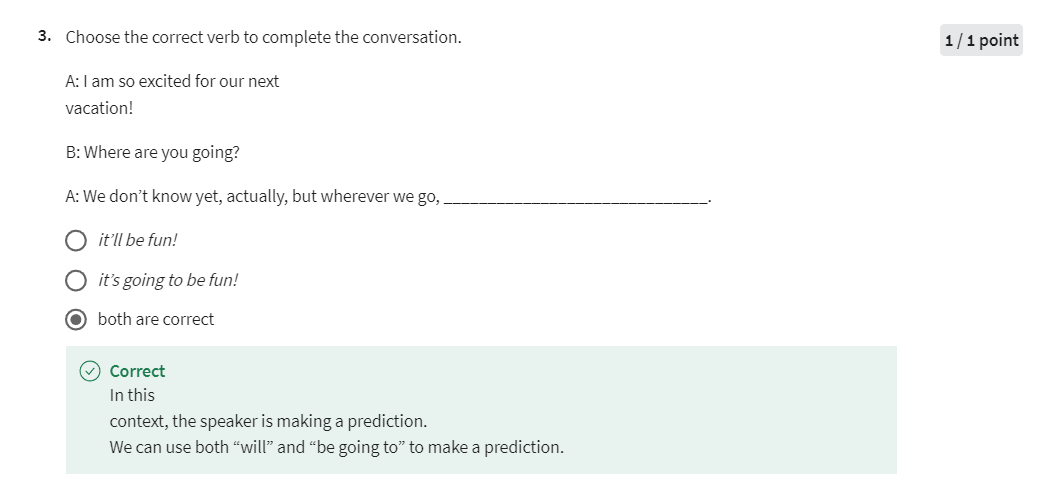
Future Tenses Practice
Practice
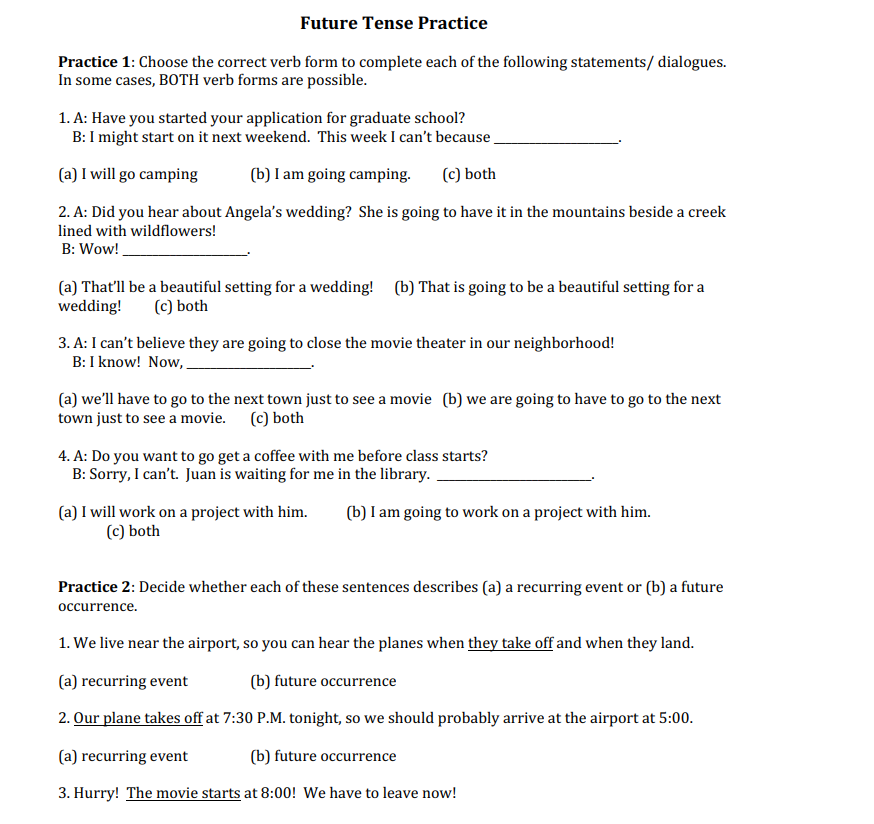
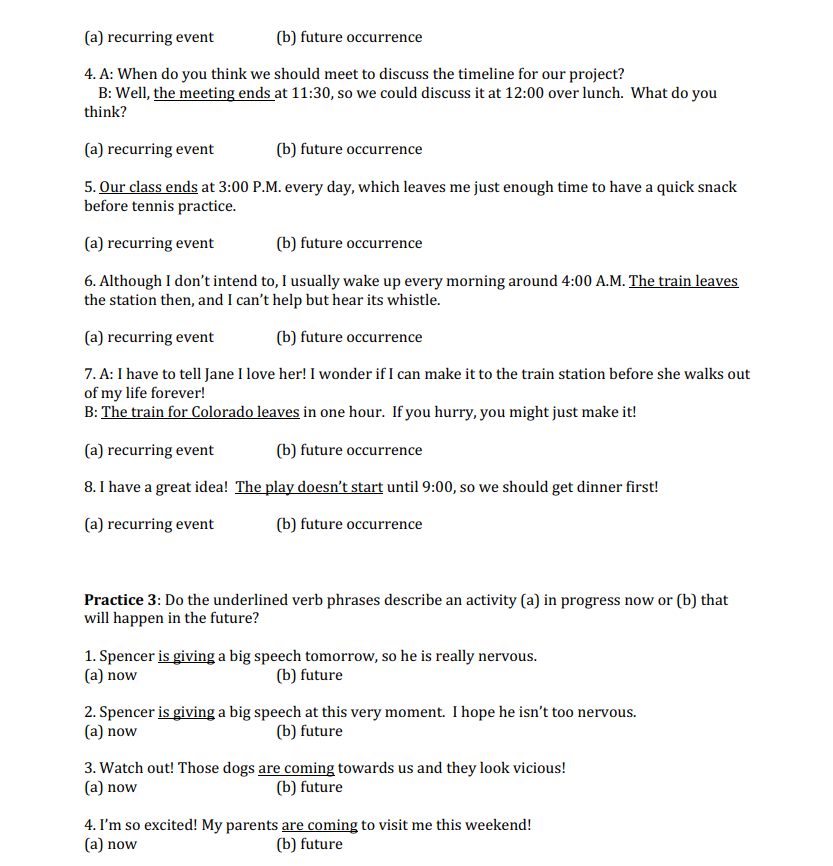
Practice Key
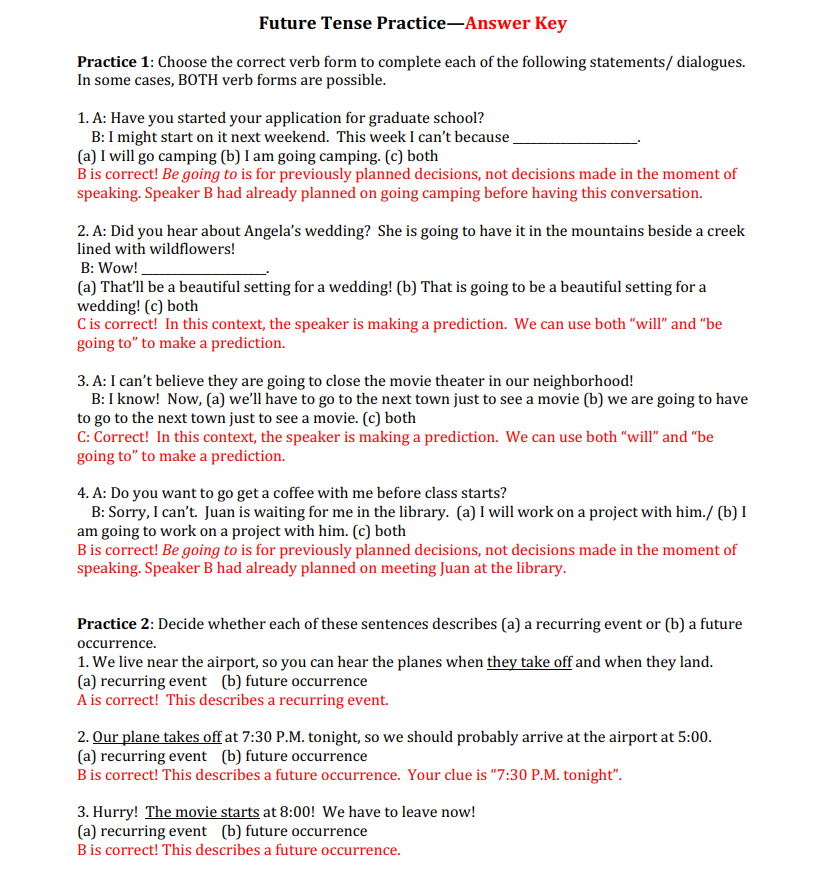
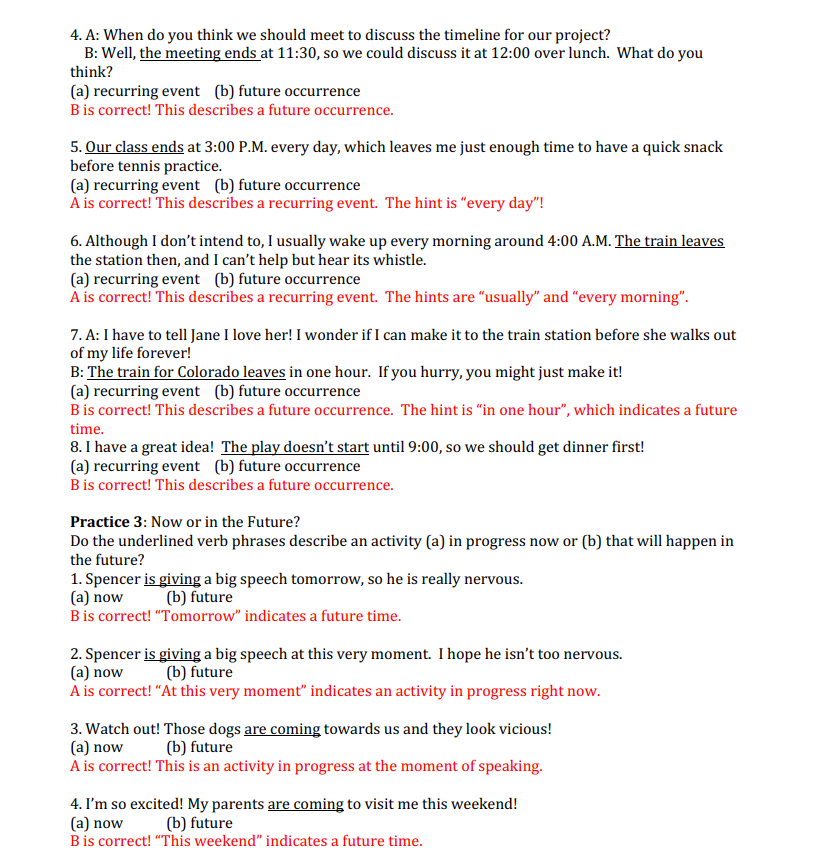
Past Perfect and Future Perfect Review Lecture
Past perfect and future perfect review. Let’s watch a quick video that will
help us talk about these tenses. >> No! What’s this? This is not mine. This is Emily’s, and she’s getting
ready to leave for the airport! I have to give this to
her before she leaves. I’ll never make it in time in these shoes. [SOUND]
No! I’m going to be so late. >> Hurry. No! She’s leaving right now! Where’s Emily? She already left. >> No.
Let’s look at a timeline
of what happened. You saw me run to the office but
when I arrived, Emily was not there. Because she left before I arrived. We have two actions at both started and
finish in the past. One action happened
before the other action. We could say it like this. Emily left. I arrived. But the time order is not clear. To be clear we could say,
Emily left before I arrived, or Emily had already left
by the time I arrived.
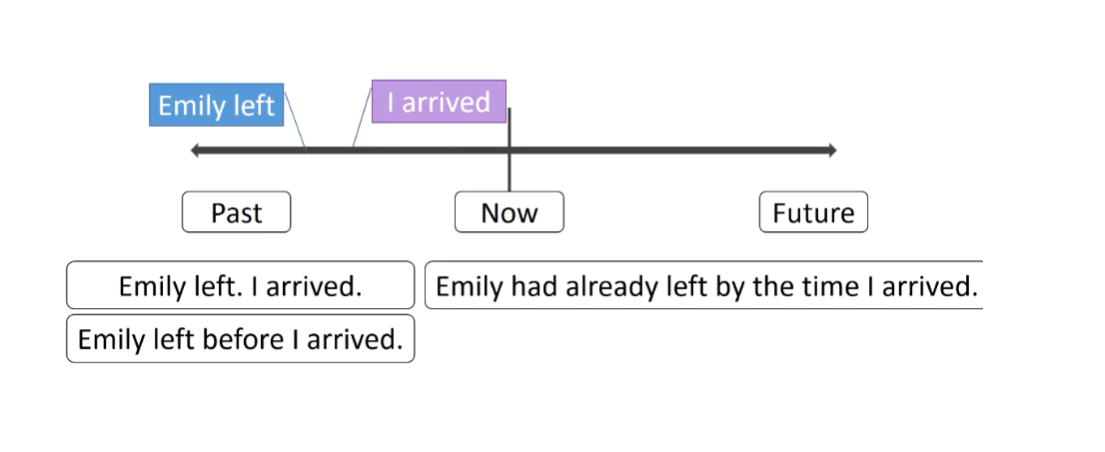
This is the past perfect tense,
Emily had already left. To form this tense, we use the helping verb had and
the past participle of the verb leave. Or we can also say Emily had gone
to the airport before I arrived. We use the helping verb had and
the past participle of go. We use this tense when we have two finished actions that
happened in the past. The verb that is in the past perfect Is
always the action that happened first. This action started and
ended before the second action occurred. Notice that the later action
uses the simple past.
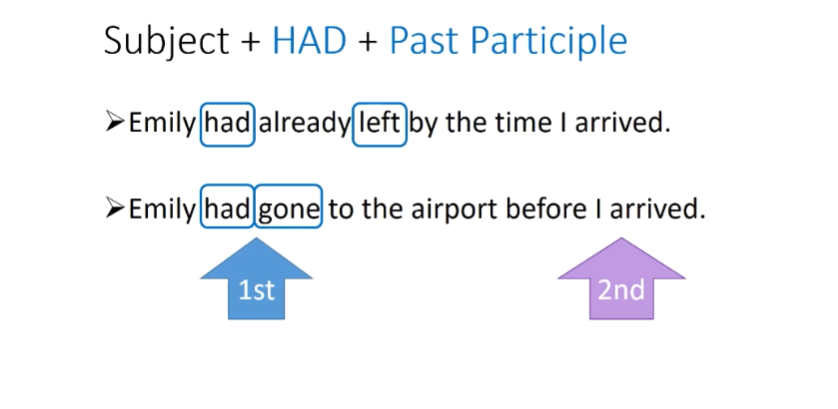
Past perfect must be used with
the action that occurred first. I had changed my shoes
before I got to the office. First, I changed my shoes. It is wrong to say, I changed my shoes
before I had gotten to the office, because the later action
cannot use the past perfect. We can use the word already to emphasize
that one thing happened before another. It is very common to use already but
it is not necessary. Emily had already left
by the time I arrived. By the time,
has the same meaning as before and can be used with the past perfect. Emily had already left before I arrived,
has the same meaning. If you use, by the time, you should use
simple past in the dependent clause. And used past perfect in
the independent clause. Or the clause without, by the time. We can use this tense without
either of these words. I had changed my shoes
before I got to the office. But, if you want to use already, just
insert it between the helping verb and the past participle of the main verb.

We know the order of these events. Emily had already left
by the time I arrived. We can also say,
Emily had been in her car for about 15 minutes by the time I arrived. If we want to compare the time
between this two events. We can use the preposition for
and an amount of time. We can also use since. Emily had been in her car since 11:45,
but I arrived at 12:00.
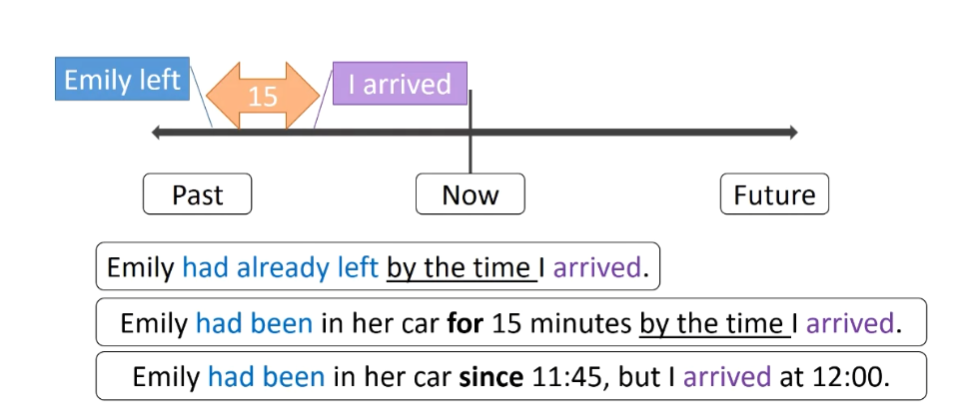
Okay, let’s see what will happen next. >> No, she’s on her way to the airport. By the time she gets to the airport,
her phone will have died. >> By the time she gets to the airport,
her phone will have already died. Both of these actions
will occur in the future. Will have died, gets there. But we cannot say, will get,
because we can’t use future tense in a time clause with words
like before or by the time. The action that will happen first is die,
the second action is get. You may know this as
the future perfect tense. To form this tense, use will,
have, and the past participle.
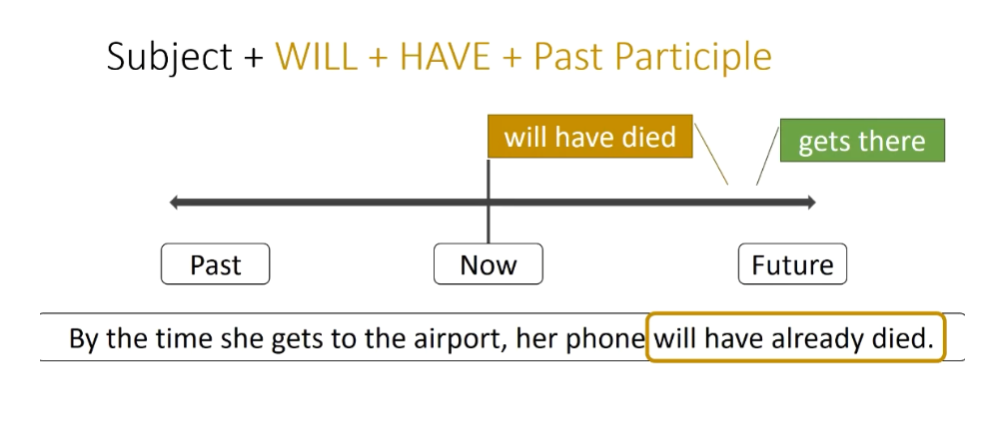
We use future perfect tense when there
are two actions that will both occur in the future. Future perfect is used with
the action that will happen first. This action will finish before
the second action occurs. It is common to use by the time
before the second action. Remember by the time means before. We can also say the same
sentence like this. Her phone will have already died by
the time she gets to the airport. What will poor Emily do?
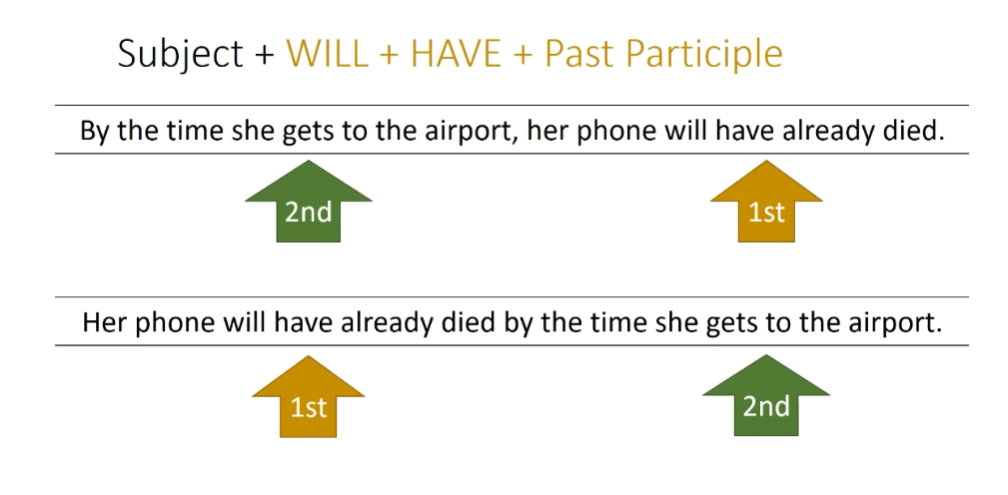
What? My charger? Well I can’t come back now. By the time I drive there,
my plane will have already left. By the time she drives back to the office,
the plane will have already left. Which action will happen first? Her plane will leave first,
before she drives back. Notice the same rules apply for, by the
time, and already, as in the past perfect. By the time goes before the second action,
and already goes between the helping verb and
the past participle. Our next assembly will not be able to
use your phone because I was too slow. Thanks for listening.
Past Perfect and Future Perfect Practice Quiz
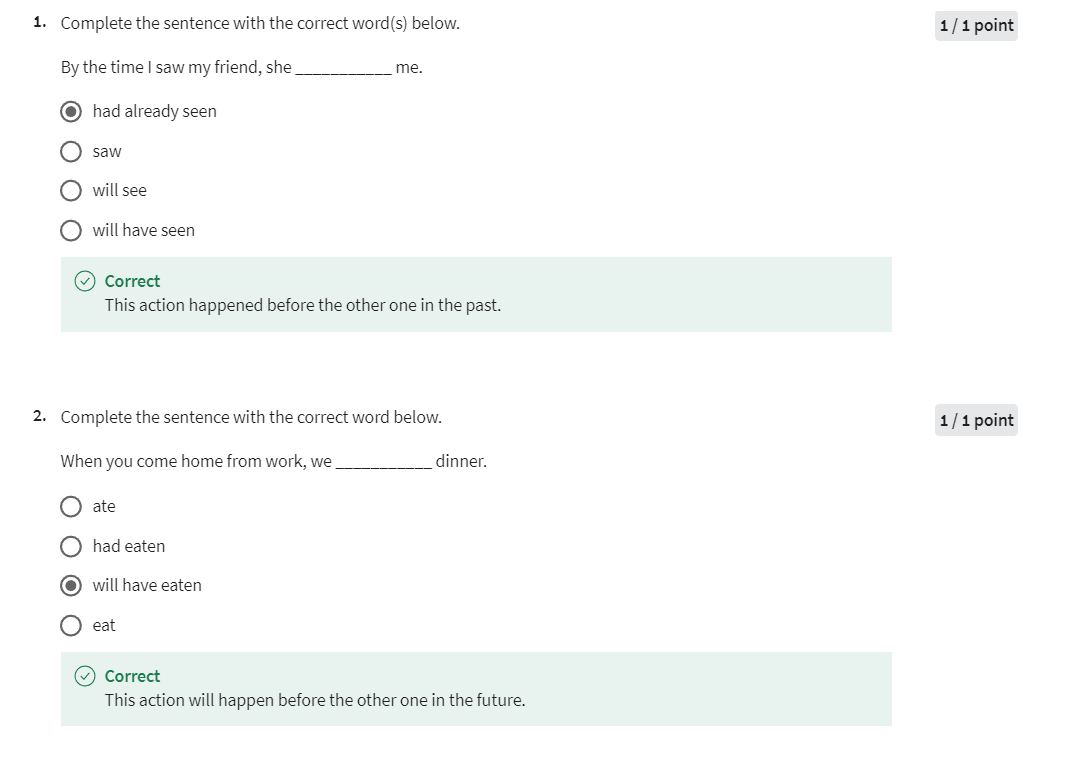
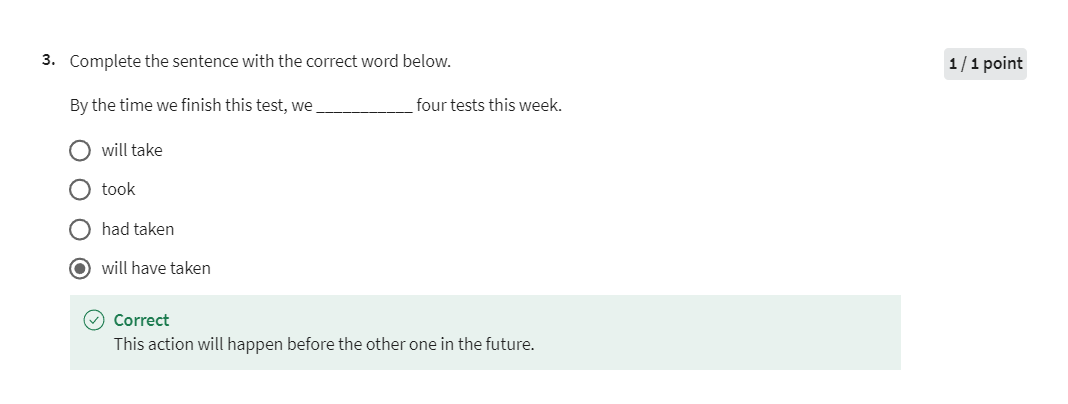
Past Perfect and Future Perfect Practice
Practice
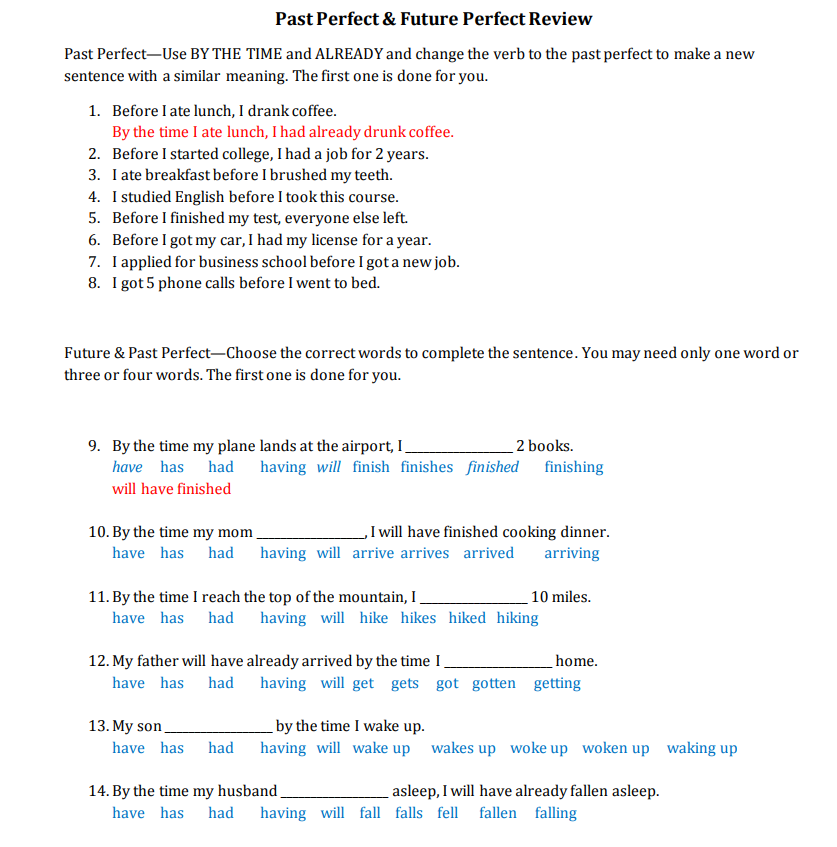
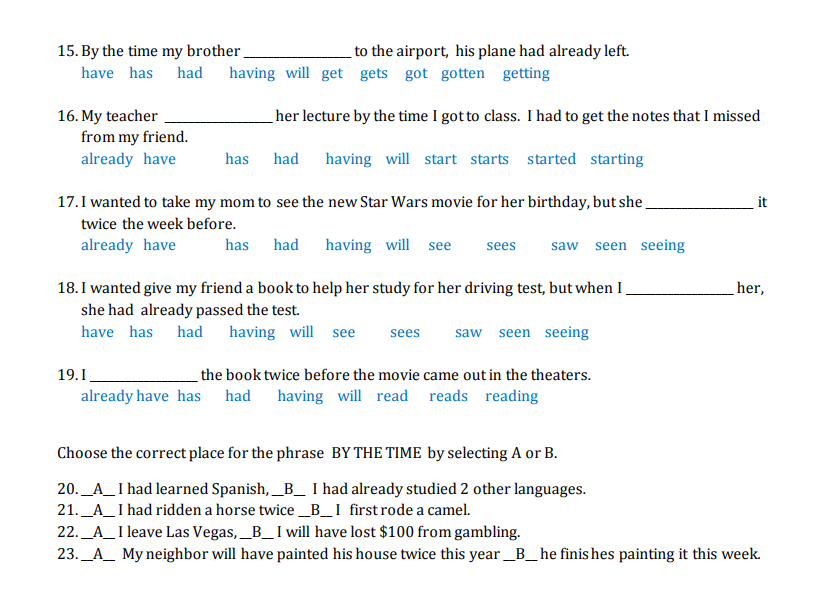
Practice key
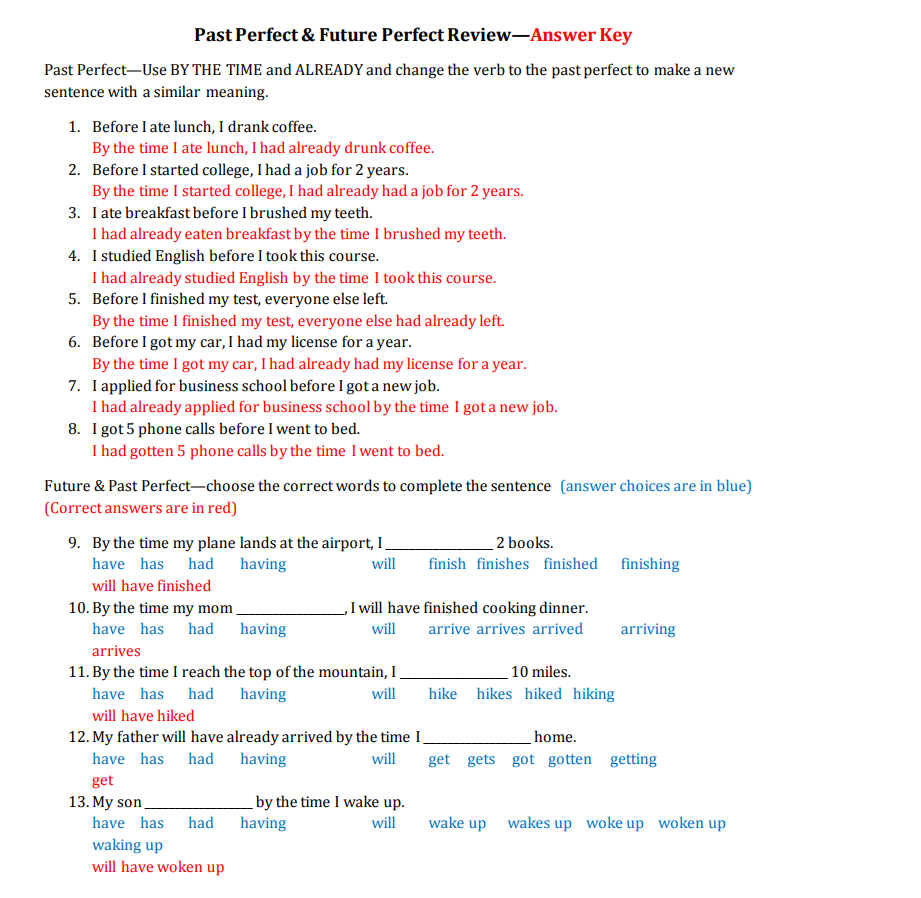
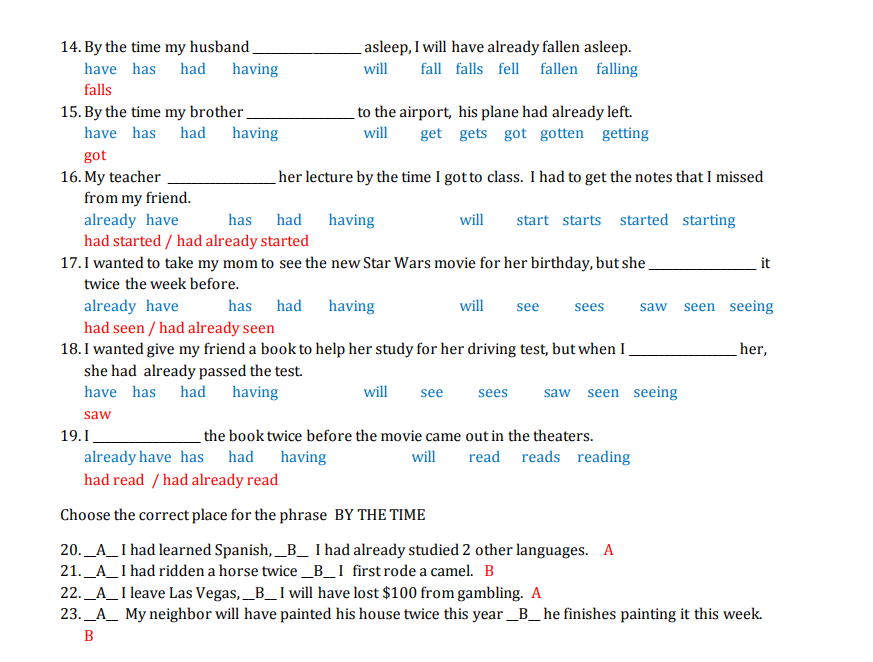
Graded Assignment: Verb Tense Review Assignment
You will get a chance to demonstrate your ability to use verb tenses correctly. You will choose one pair of topics below to write a paragraph or two on that use present, past, and future tenses correctly. You will need to be creative so that you can use a variety of verb tenses. You must include at least 10 verbs in correct form and use at least five different tenses correctly. You will type the paragraph here for grading. I**talicize your verbs.
Pairs of Topics
- a pet you have now and a pet you had when you were younger
- your hobbies now and your hobbies when you were younger
- your job now and the job you hope to have in the future
- your lifestyle now and your lifestyle in the future
- the weather in your home town 3 months ago and 3 months from now
My try
When I was younger, I had a pet cat named Whiskers. She was a playful and mischievous kitten, always getting into trouble around the house. I loved spending time with her, playing with her toys, and cuddling up with her at night. However, she passed away several years ago, and I have since adopted a new pet, a dog named Buddy. He brings so much joy into my life with his boundless energy and unconditional love. We go for walks together every day, and I enjoy teaching him new tricks. In the future, I hope to have another pet, perhaps a rescue cat or a pair of guinea pigs. I imagine creating a loving and caring home for them, just like I did for Whiskers and Buddy.
Graded Quiz

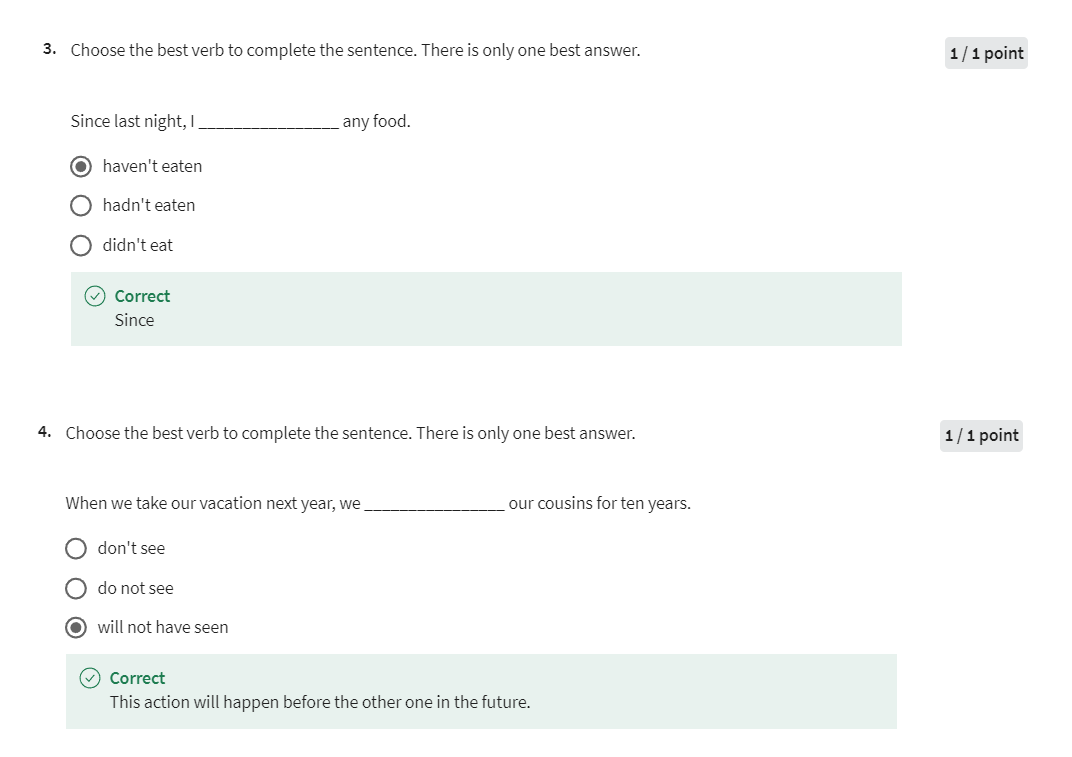
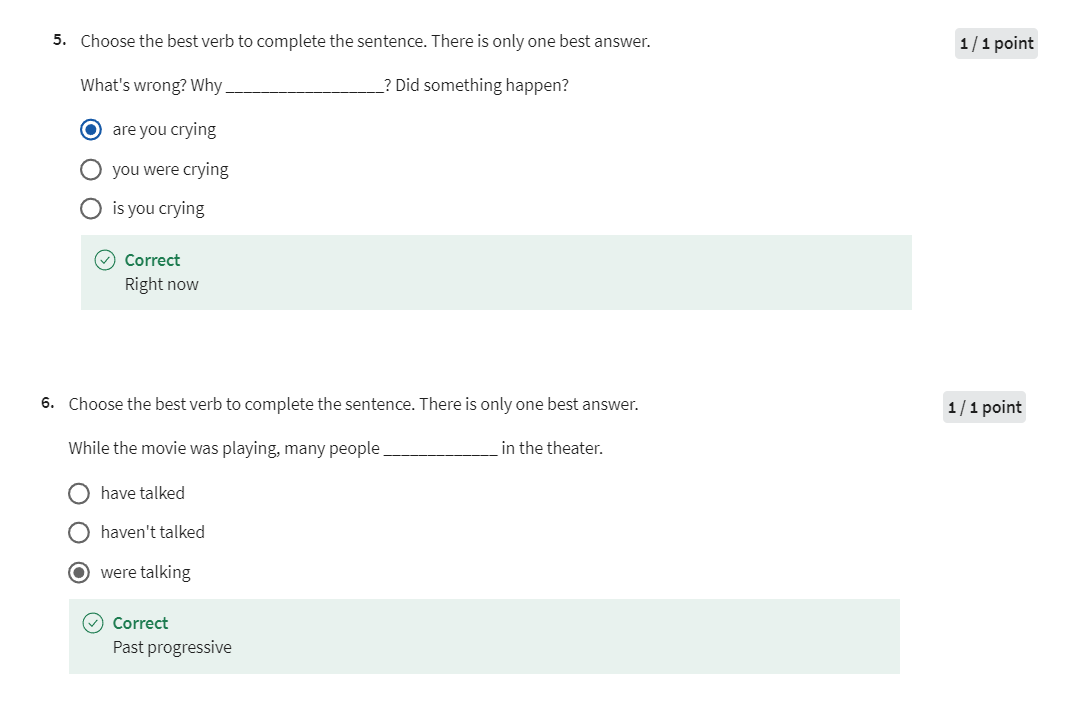
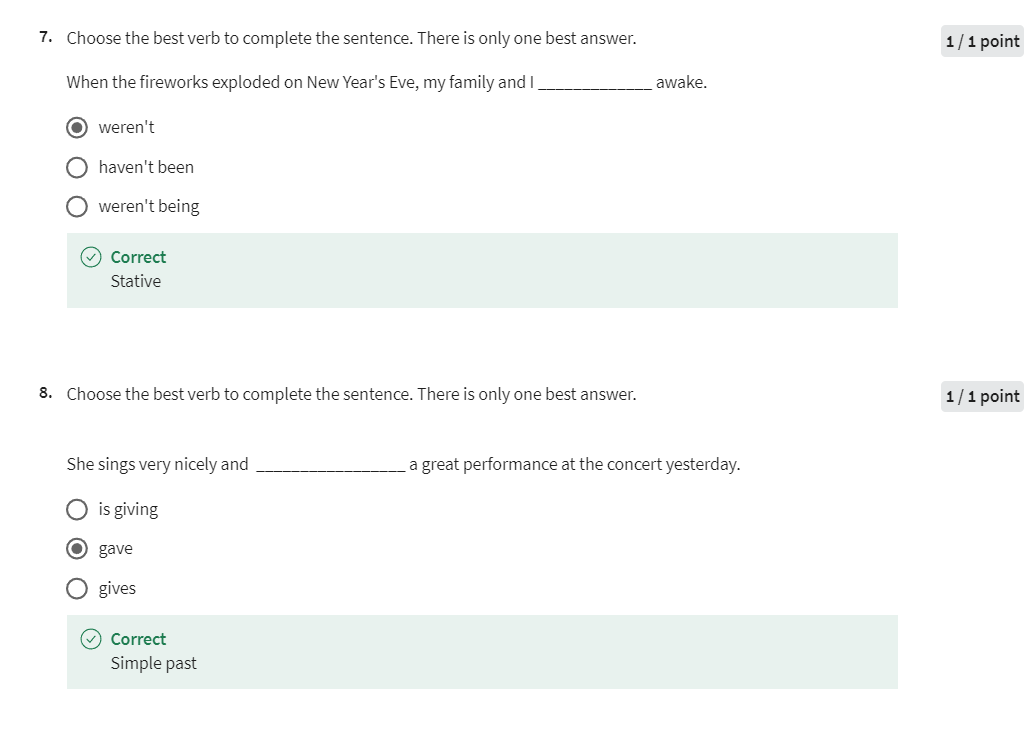
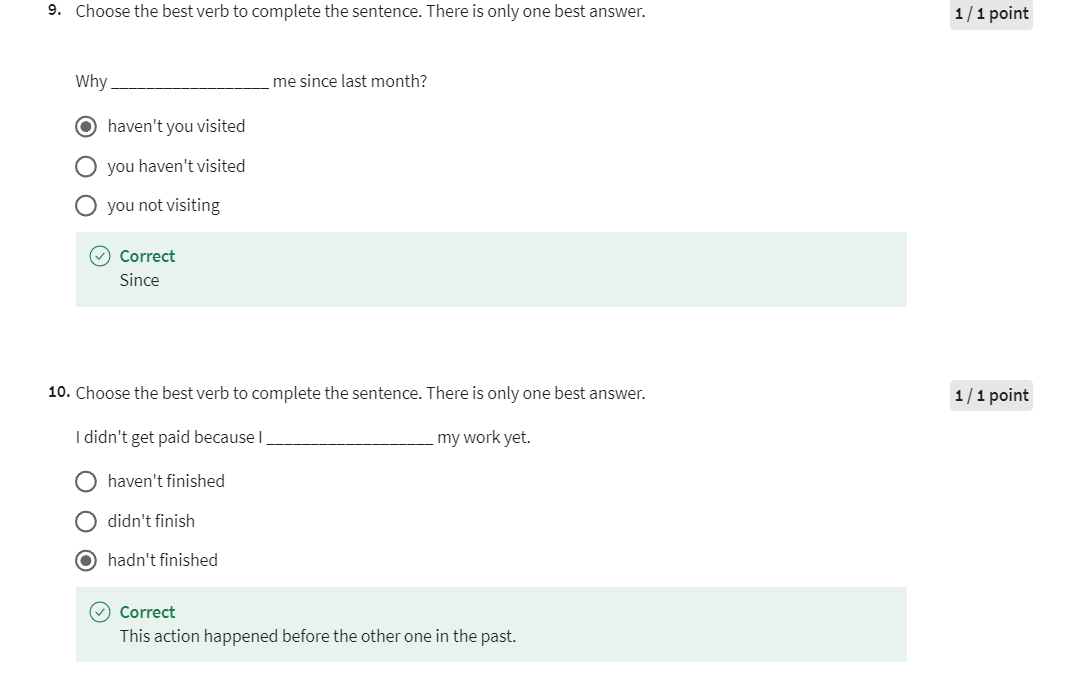
Week 02: Perfect Progressive Tenses
This week, you’ll learn about the final three verb tenses in English. Then you will be familiar with all 12 English verb tenses. These will combine the perfect tenses with the progressive tenses. Because you already know those tenses, learning these new ones should be fairly easy.
Learning Objectives
- • explain how the present perfect progressive tense is formed
- • use present perfect progressive when appropriate
- • explain how to form the past perfect progressive tense
- • explain when to use the past perfect progressive
- • use the past perfect progressive when appropriate
- • explain how to form the future perfect progressive tense
- • use the future perfect progressive correctly
Present Perfect Progressive Lecture
The present perfect progressive. You already know that we form the present
perfect progressive with have, or has, been, and a present participle,
or verb with ing. To make a negative statement, we simply
put not between have or has and been. To form a question, we are going to
switch the subject and the helping verb so it would become, have you been
studying a lot of grammar lately?
In this lesson, I’d like to discuss three main uses
of the present perfect progressive. I’ll show you three quick videos
to help me explain these uses. Let’s check out the first video,
which explains the first use. Here we go. I’ve been running for twenty minutes. Twenty minutes to go. Let’s do this! >> This example illustrates the first
use of the present perfect progressive. Which is to talk about the duration
of an activity in progress right now that started in the past. I started running twenty minutes ago. I am still running now. I have been running for twenty minutes. We can also use since with this use. It’s important to remember
that with this use since and four the action is still taking place.
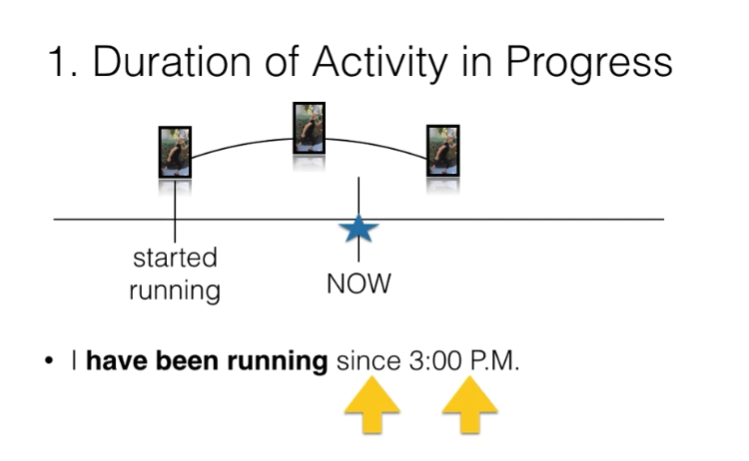
Let’s take a look at another short
video that will show us the second use of this tense. [SOUND] Hello, I’m actually yeah, can I call you right back? Because I’m, I’ve been running and
I’m really out of breath. A second use of the present progressive
is to talk about inactivity that started in the past but
just ended at the moment of speaking. Unlike the first use that we talked about
in which the activity is still going. I have been running,
that’s why I’m really out of breath. I just stopped with this use the evidence of the activity is visible just
take a look a these pictures. It is obvious That I have
just finished running.
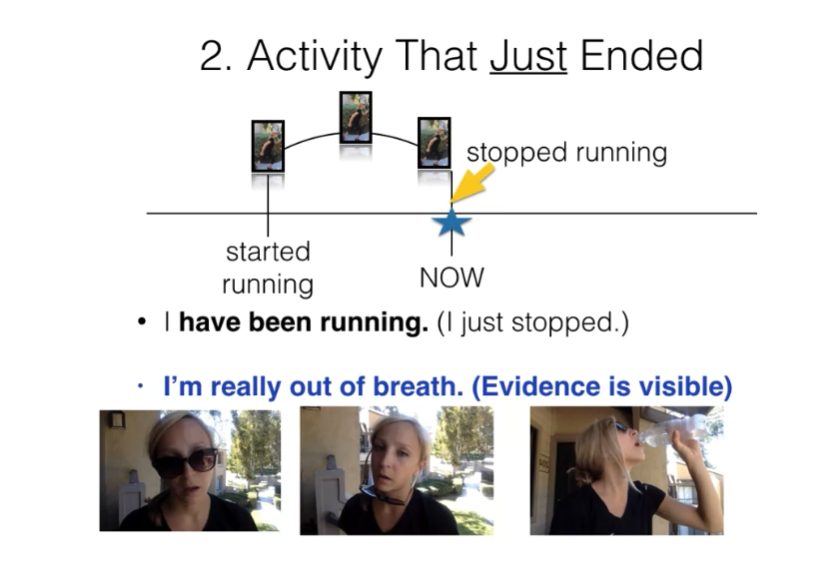
Okay let’s check out the third
video which explains the third use. >> Hey, I’ve been meaning to tell you. You look really fit these days,
Thank you, I’ve been running a lot lately. Okay this last video shows us the third
use of the present perfect progressive. Which is to talk about a recent habit. Clearly I’m not running right now. You saw me I’m wearing normal clothes,
right? But I have been running a lot lately. In fact, I ran on Monday, Tuesday,
Wednesday, Thursday, and Friday. Even though I’m not running right at this
moment, I can use the present perfect progressive to say that I have
been running a lot lately, or recently you may even hear these days.
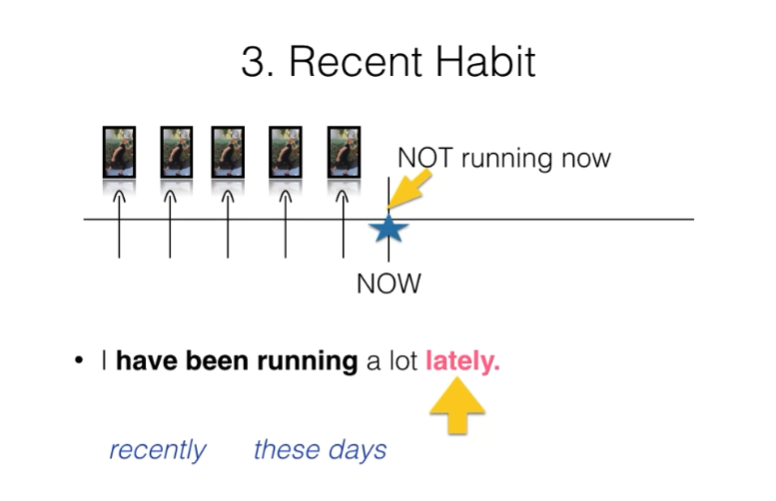
All right, let’s quickly summarize the reasons that we use
the present perfect progressive. The first use is to talk about
the duration of an activity in progress using since or for. For example, you’ve been watching
this video for six minutes. I’m sure you’re getting a little tired. The second use is to talk
about an ongoing activity that has just ended in
the moment of speaking. For example, after this video
I will probably say I’ve been explaining grammar and my head hurts so
now I can go relax and be lazy. And the final reason that we use
the present perfect progressive is to talk about a recent habit. We can also use recently and
lately with this use. For example, you’ve been learning
a lot of new grammar lately
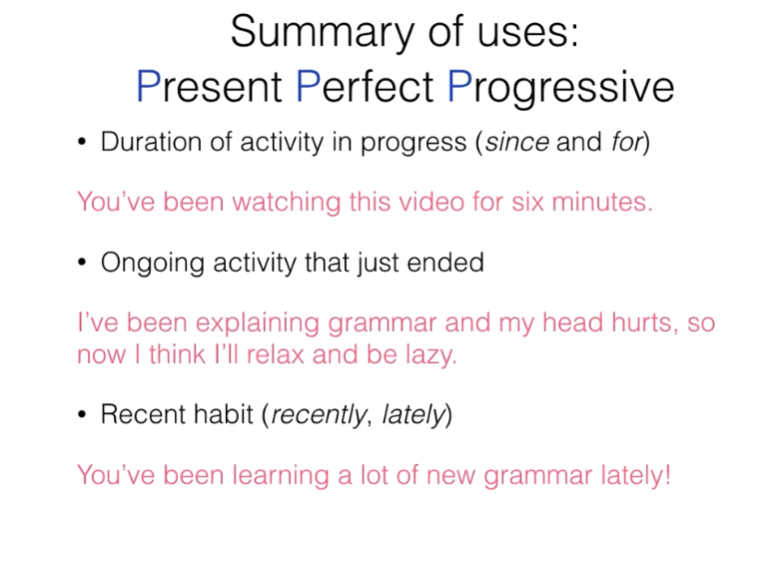
careful, remember you should not use
stative verbs in any progressive tense. When they express a state. Sometimes a stated verb
can express an action. And then it’s okay. But if it’s expressing a state
do not use it with ing. For example I have been knowing you for
three years. No, please don’t say this. You could just say,
I have known you for three years. And that sounds great.
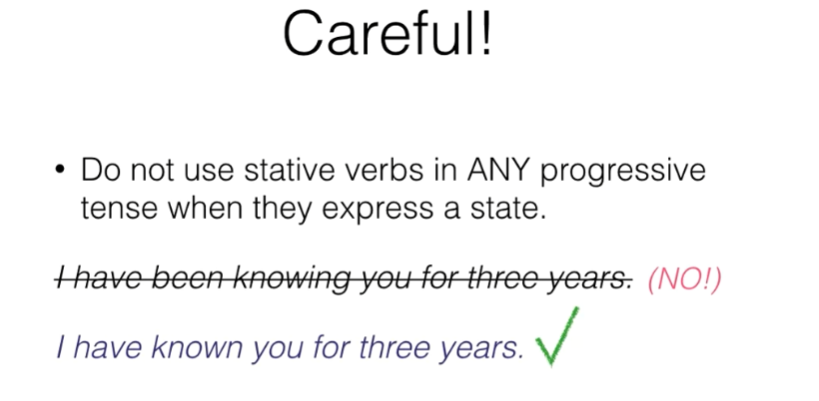
There are other verbs with
non-continuous meanings that are not necessarily stative verbs. It could be tricky to try to use these
verbs in the present perfect progressive. These are verbs like drop,
lose, miss the bus, and find. There are others, of course,
but these are some examples. With these types of verbs,
we don’t necessarily express an ongoing activity or
a continuous activity. We can however express an activity
that is repeated over time. Let’s take a look at
an example to see what I mean Imagine Jake says, you’re late,
where have you been? I can’t say I have just
been missing the bus. That’s not correct because
when one misses the bus, it’s an action that happens
immediately and then it’s over. It’s not ongoing. So, we could express this with
the present prefect or the simple past. I can say, I have just missed the bus or
I just missed the bus.
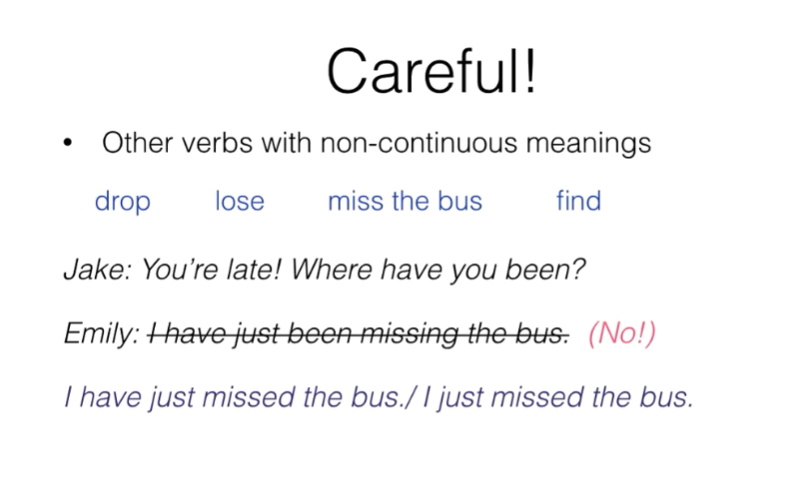
However, there are ways
in which we can use these types of verbs in the present
perfect progressive. For example, my boss is unhappy because I have been missing the bus lately and
have been arriving late to work. This is a grammatically correct sentence, because now we are expressing
a recent habit. Remember that third use of
the present perfect progressive. It’s okay to use this types of
verbs with that use, using lately. Or recently. Okay, I’ve been teaching you
the present perfect progressive. But our time is up now. So thank you for listening. See you next time.
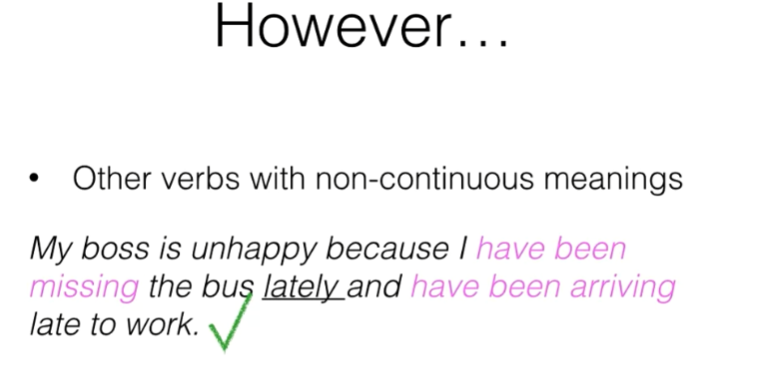
Present Perfect Progressive Practice Quiz
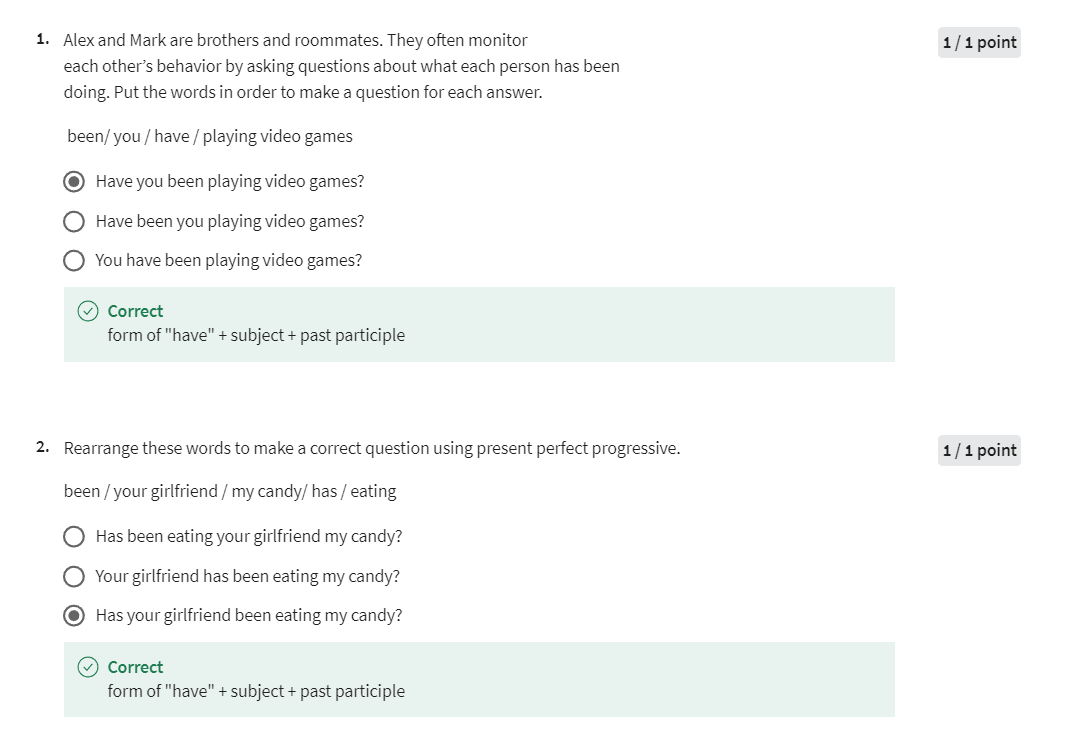
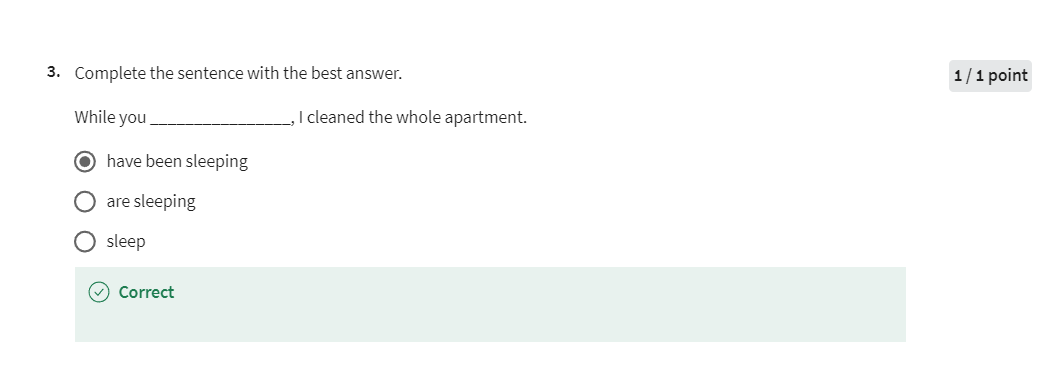
Present Perfect Progressive Practice
Practice
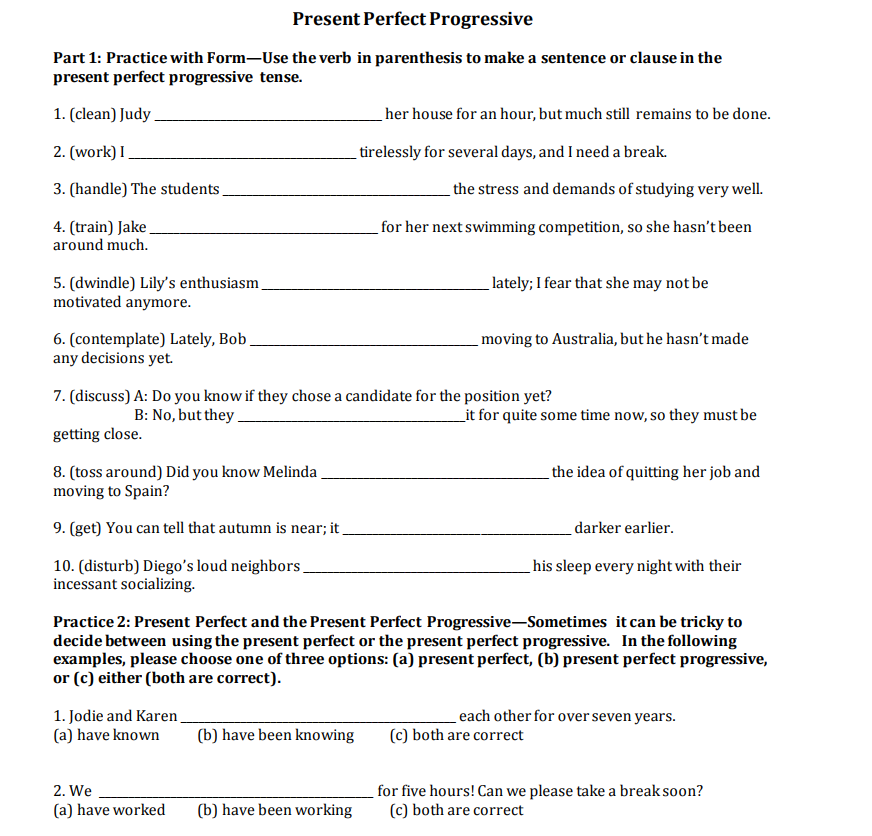
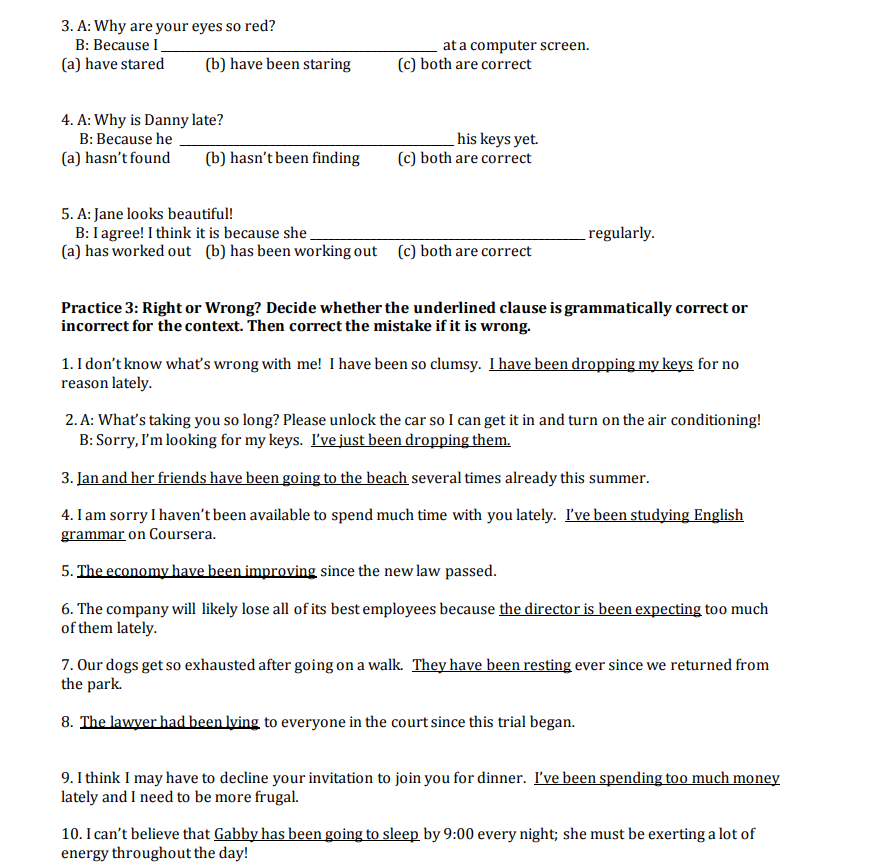
Answer key
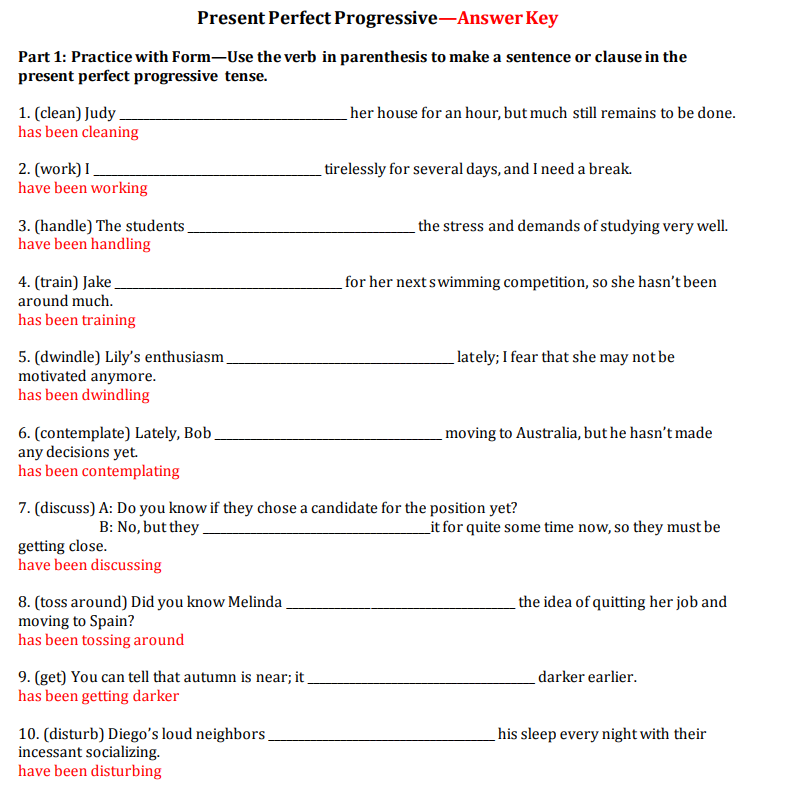
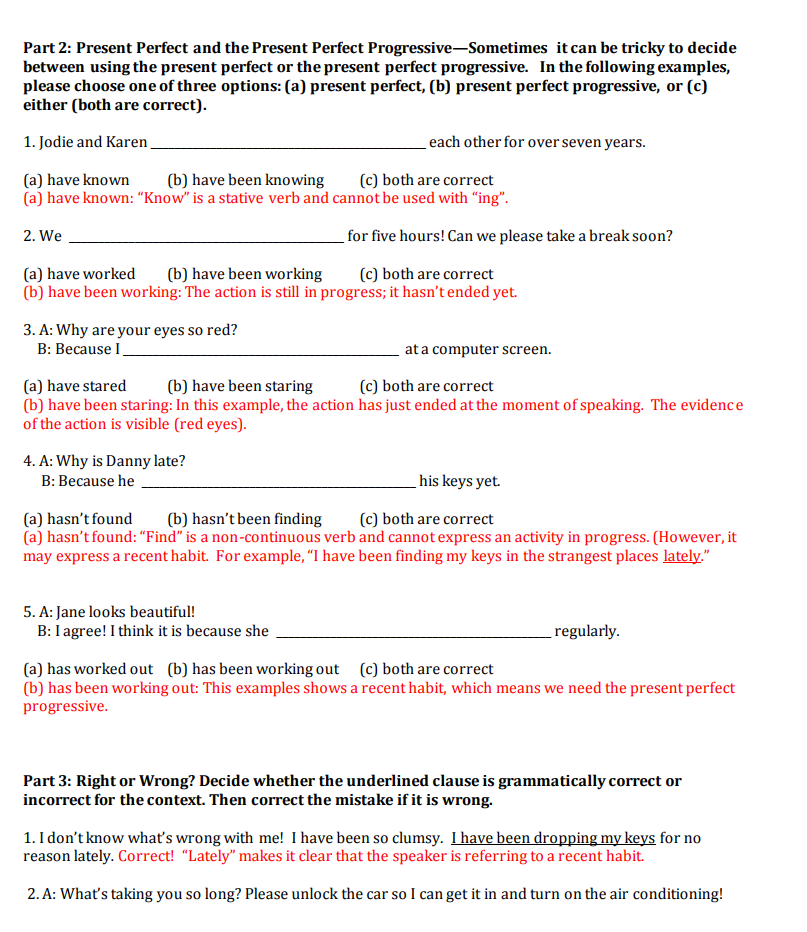

Past Perfect Progressive Lecture
Past Perfect Progressive. >> Hey, Emily. >> Hey. >> I have some pictures on my phone. I need you to help me choose
a good picture for my Instagram. You need to choose a photo that
will get me a lot of Likes. >> Yeah, of course. >> So, first, look at this one. What do you think of this one? Ugh, you can’t use this picture. Right?
Why is your hair all wet. >> Well I had been swimming
right before I took this photo. Okay how about this one? >> No.
Jake you look terrible here. >> Well I had been
exercising right before. Okay how about this one? >> [LAUGH]
Jake, you look awful. You look exhausted here. >> I had been working all day
before I took this picture. Now, no one will ever
like any of my photos.
I had taken some pictures
before I came to the office. This is past perfect which we use for two
actions that both happened in the past. One action happened
before the other action. For the first action, we use past perfect,
had, and the past participle. The second action uses the simple past.
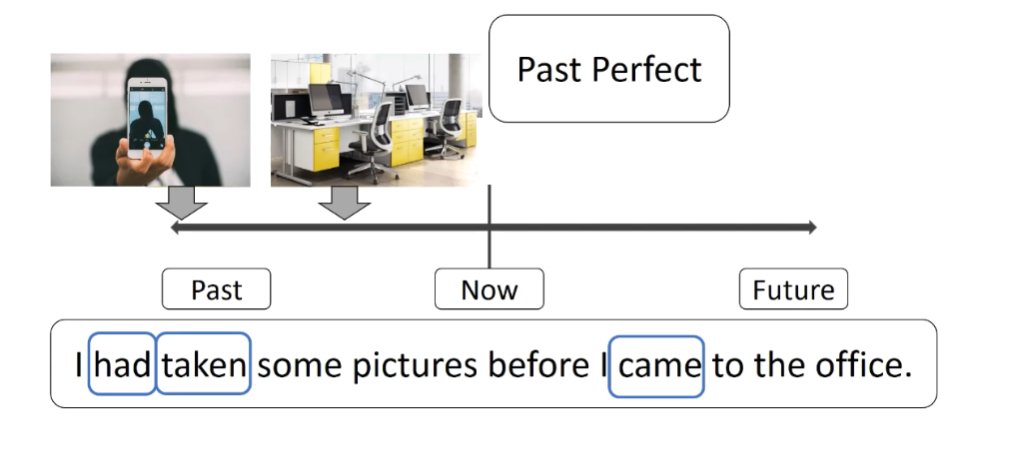
But here’s what I said in the video. I had been swimming before
I took the picture. Notice we have had and the past
participle of be and the ing verb. This is the past perfect progressive.
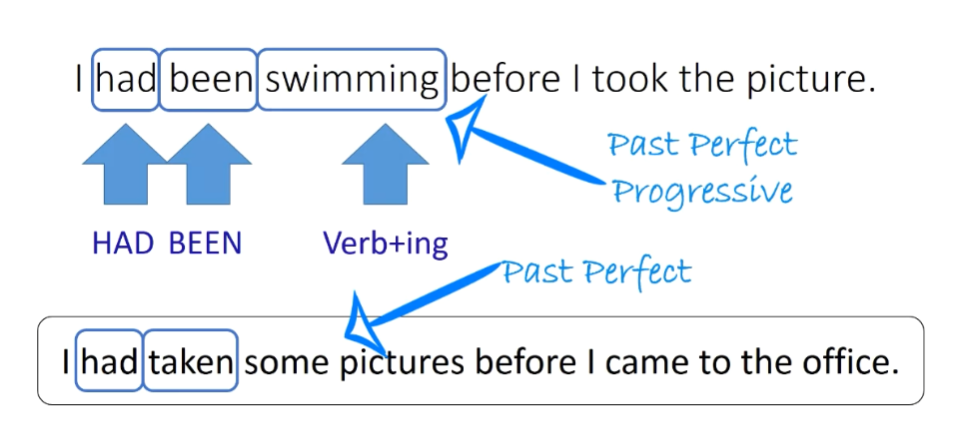
Here is my timeline. We’re just going to focus on the past and
right now. Last week, I took a picture. In the video, which is now,
we are talking about the photo. What happened right
before I took the photo? I have been swimming. The action of swimming happened
immediately before I took the picture. We can use this tense to show
that something was in progress immediately before another
action in the past. In addition, the action of swimming was
a continuous action that was happening for a long period of time
before I took the picture. This tense shows duration. In fact, I had been swimming for 45
minutes right before I took the picture.
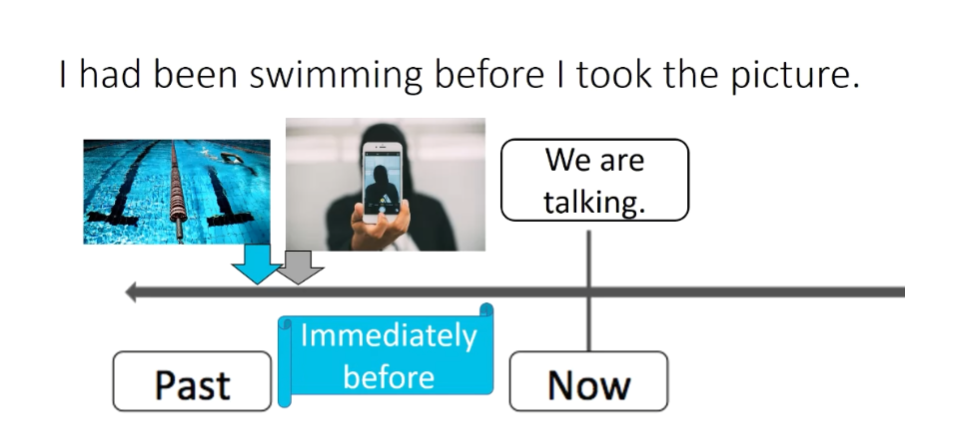
What had I been doing
before I took this photo? See if you can answer the question
using the verb work out. You had been working out. I had been working out
before I took the picture. This action happened immediately
before another action in the past. In the video, I also told you I had been
working all day before I took the picture. Notice the phrase, all day. I can use this tense to show that
something had been in progress for a long time before another
event in the past.
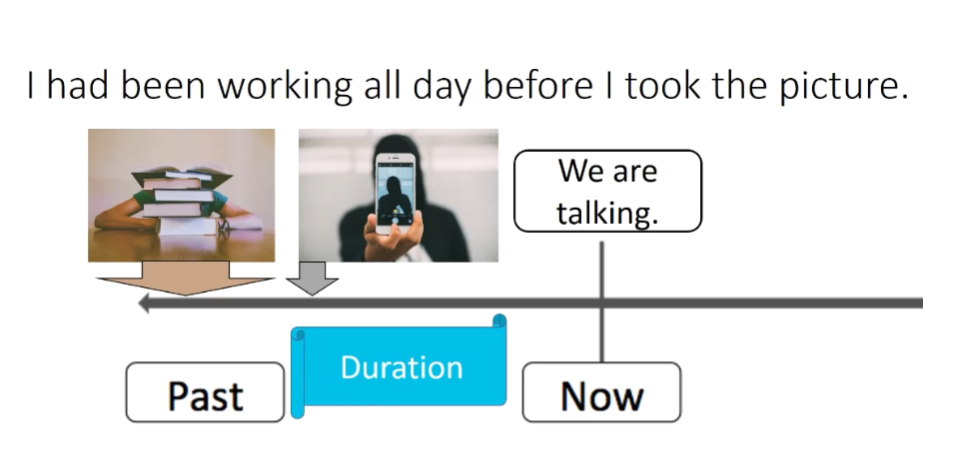
To make a negative sentence,
insert not between had and been. I hadn’t been relaxing
before I took the picture. Look at two more verbs that
both happened in the past. I liked the photos,
then Emily looked at them. But it is wrong to say, I had been liking
the photos before Emily looked at them. That is because like is a non-action or
non-progressive verb. Like belongs to group of verbs in English
that cannot take the progressive tense. For this verb we would
say I had liked photos.
Here’s another example,
the ground was wet. It had been raining before I got home. Notice the subject here is it. We still use had, do not change had. The verb is the same for
every subject in this tense. We can also say, it had been raining for
three hours before I got home. Like in the past perfect,
it is common to use for, especially since we are showing duration. Or it had been raining since 6:00.

Remember, we use the progressive tense for
continuous actions like rain. It is incorrect to say, My mother
had been arriving before I got home. Because arrive is not a continuous action. For non-continuous verbs,
just use past perfect. We can also use this tense to talk about
something that happened continuously over a long period of time. I had been studying English for
six years by the time I graduated.
Finally, to form a question, simply switch
the position of the subject and had. Had it been raining before you got home? And, if you want to make
an information question, just add a W-H word to the front. What had you been doing
before you took this picture?
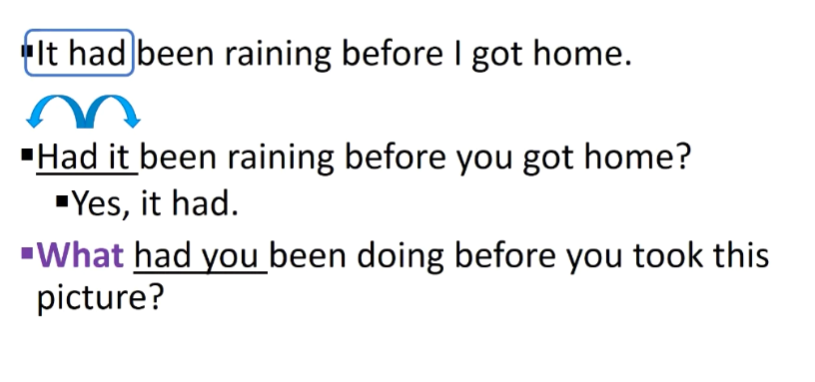
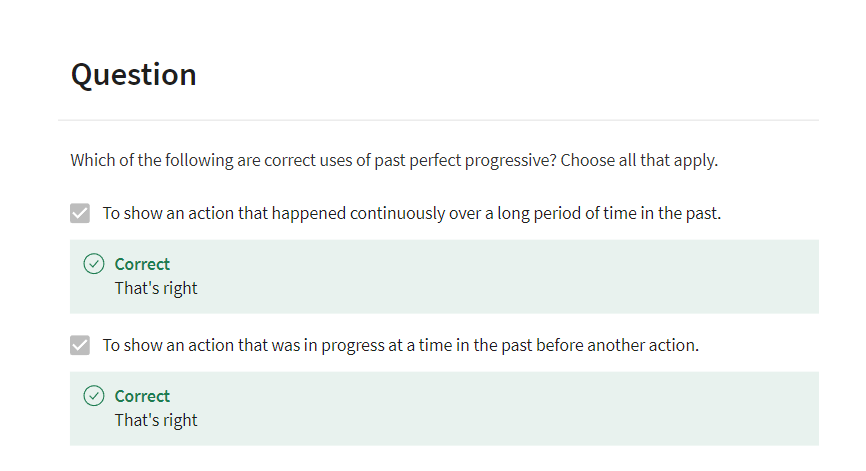
Past Perfect Progressive Practice Quiz
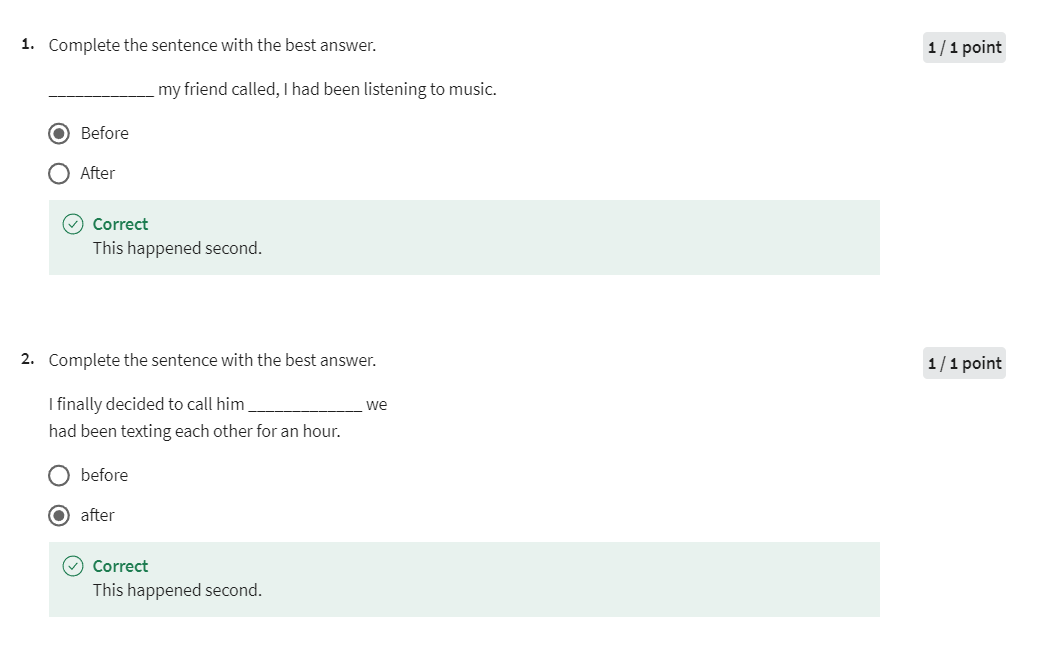

Past Perfect Progressive Practice
Practice
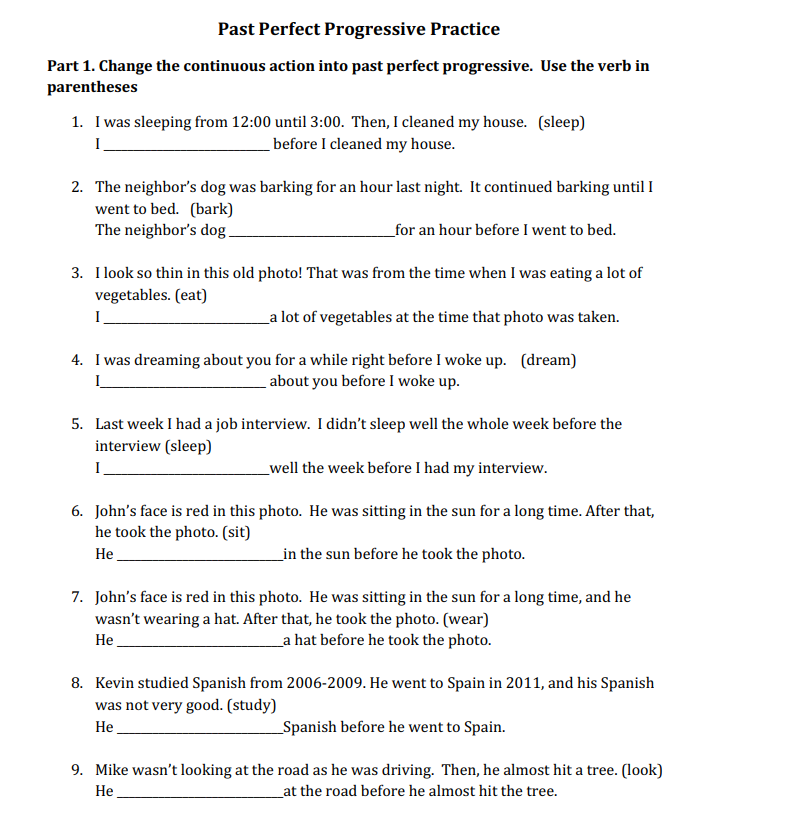

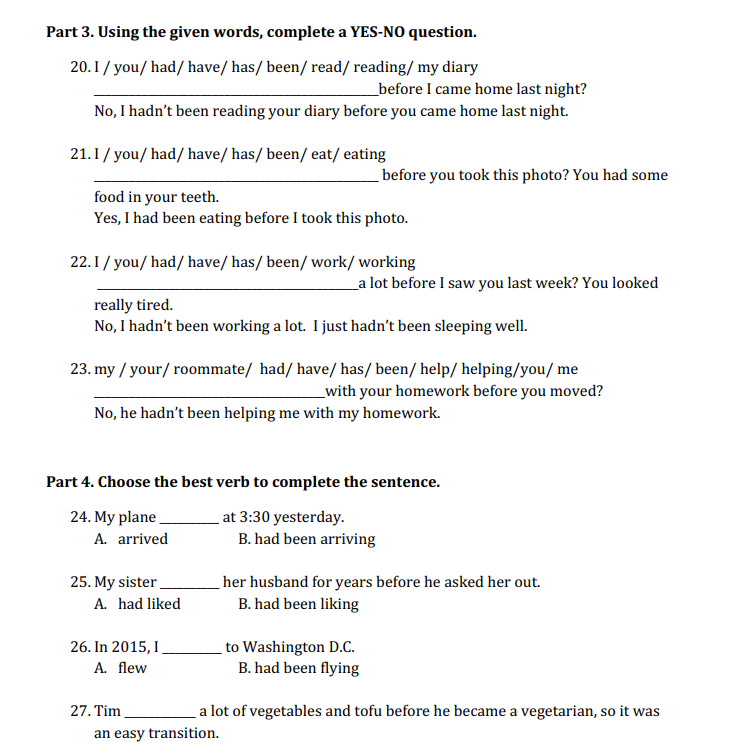
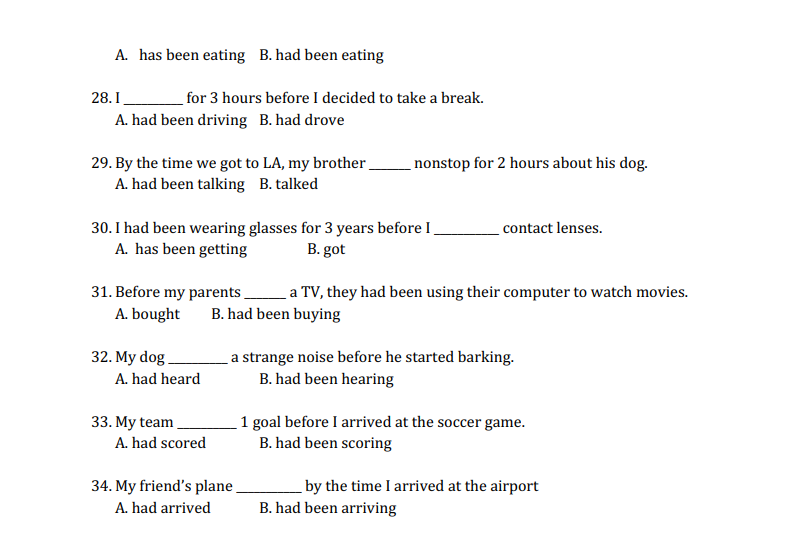
Answer key
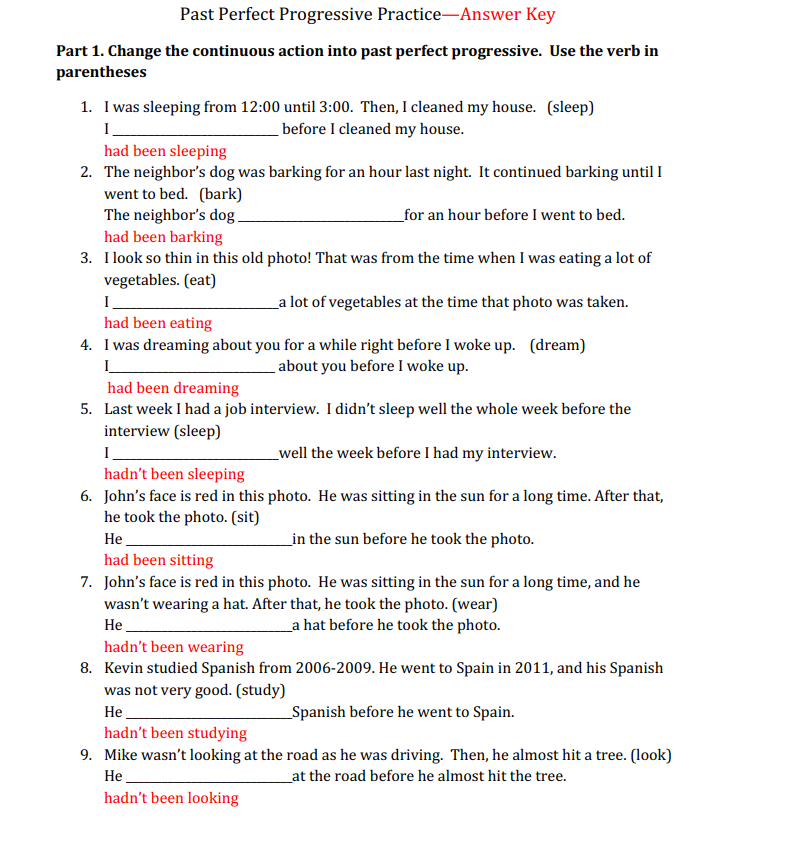
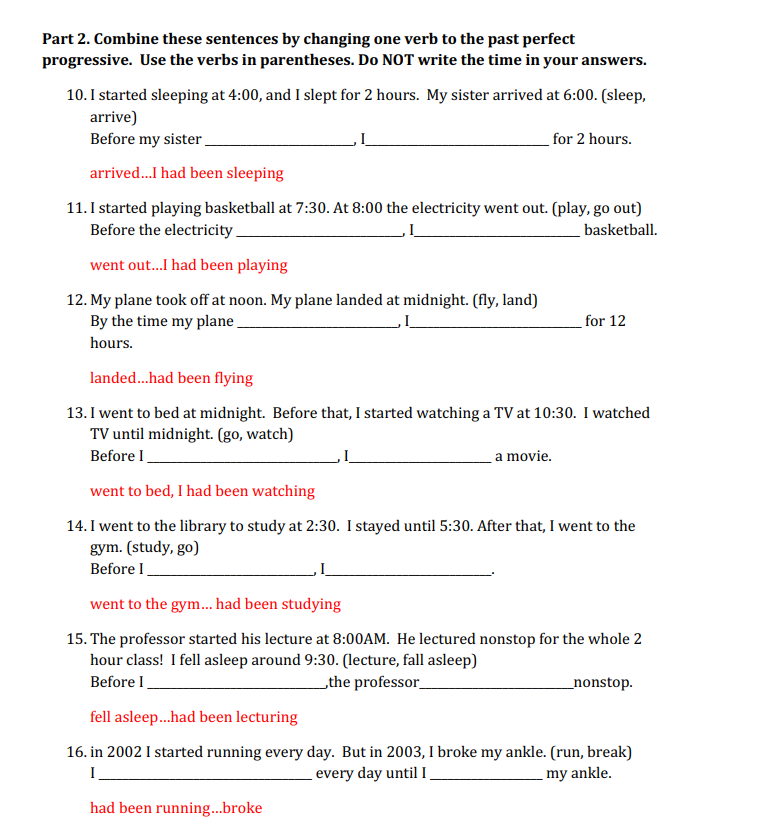
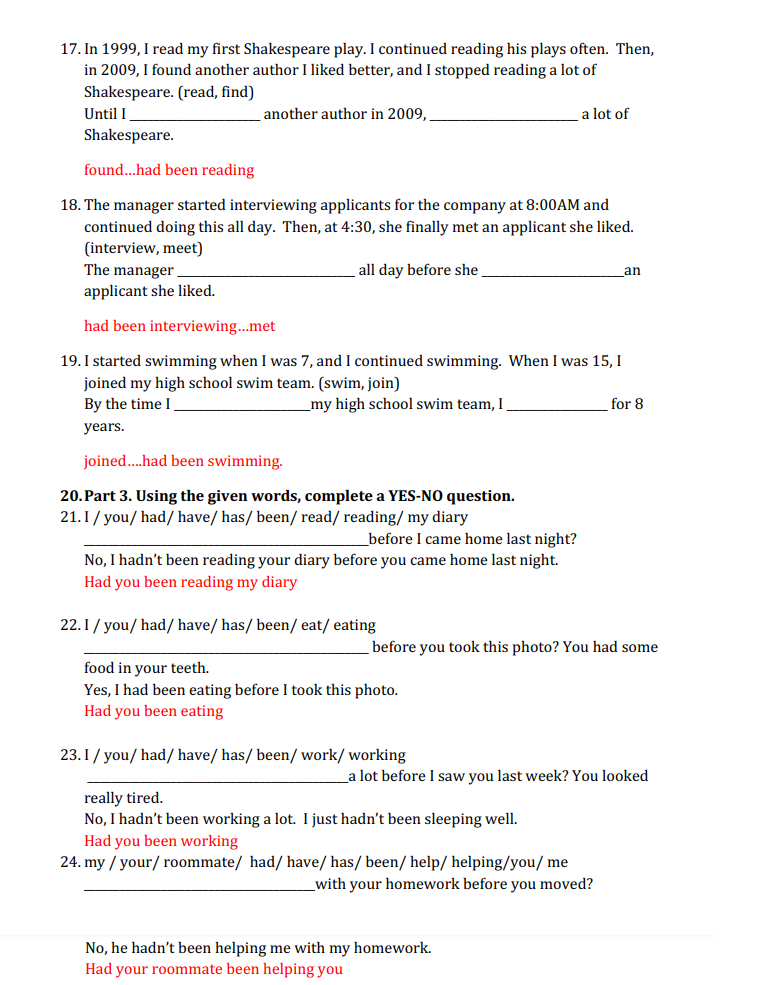
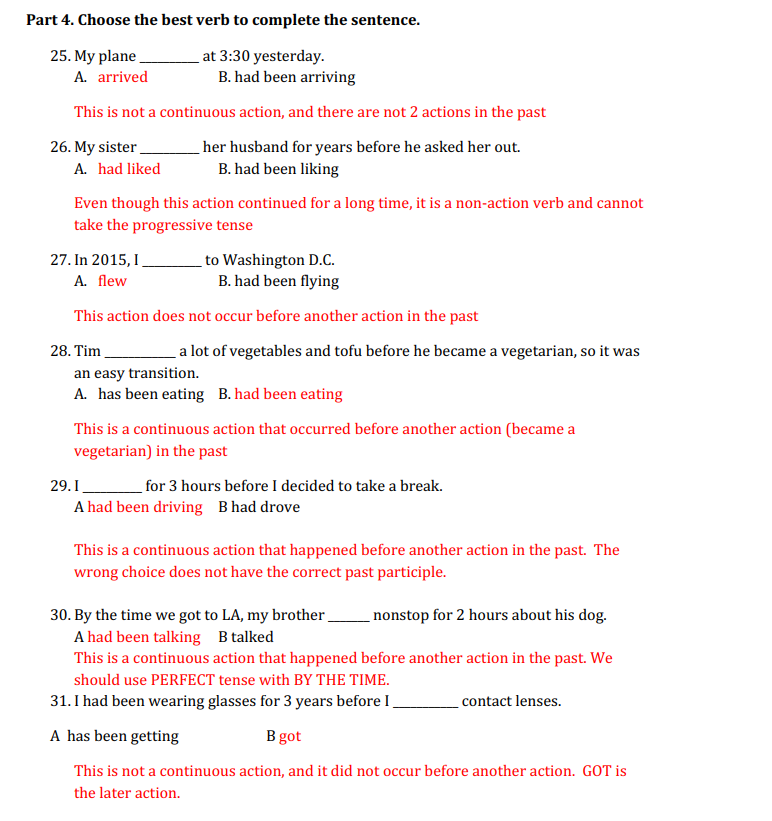
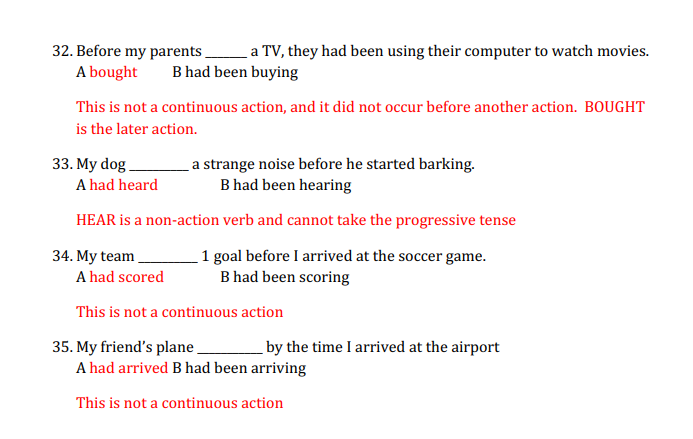
Future Perfect Progressive Lecture
A future perfect progressive. Emily and Jake decided to spend
the day at the beach and it turned out to be a pretty interesting day because
they met twin brothers, Marco and Polo. The four of them got to talking and
realized that they actually had a lot in common, so they made plans to go
on a double date next Saturday. Watch as Emily and Jake discuss
their plans for the future date. Notice the verb tense in the sentences
that appear at the bottom of the screen during the video. >> Yeah. >> I’m so happy tomorrow is Saturday and
it’s our big double date. >> Double date. >> Yeah, so I think we need to make a plan
about what we want to do because we want to appear organized,
so we’re going to dinner. After dinner, what do you want to do? >> Maybe we could go to a movie? >> No, bad idea, bad idea because
we will have been sitting for a couple of hours already so
it’s better to do something active maybe. >> Why don’t we go for a walk then? >> Walk, walk is good, yeah, okay. So we’ll go for a walk. It’ll be nice, romantic, and then [LAUGH]
after the walk, maybe rollerblading? >> No, I don’t like that idea because we
will have already been on our feet for too long. We will have been walking for
20 minutes before that. >> Good point, and sometimes some
people are lazier than other people, if you know what I mean? >> Some people. >> Yeah, okay, so then what we’ll
do is just maybe sit on a bench and look at the stars. >> Yeah, I like that idea. >> Yeah, okay, and then after that, what? What else? What could we do? >> We’ll just have some more fun. >> More fun? >> Yeah. >> No, no. That’s enough fun. We’ll have been having fun all day. >> Okay, have it your way. >> All right. >> No fun.
All right,
those sentences that you saw at the bottom below the video were examples of
the future perfect progressive. To form the future perfect progressive,
we need will, have, been and a present participle or
verb plus ing. To make a negative statement we
simply add not between will and have. Of course it’s very common to
use the contraction form won’t.
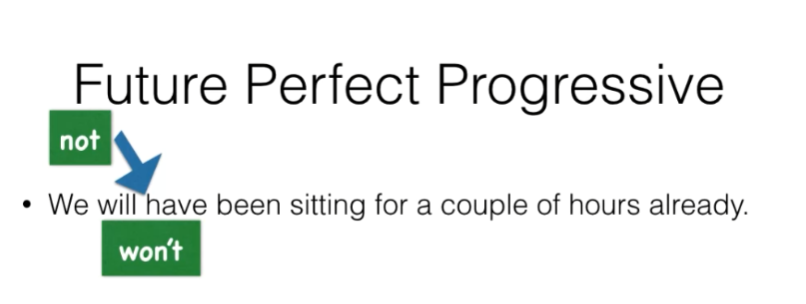
将来完成进行时是英语中的一种时态,用于表达将来某个时间点之前正在进行的动作或状态。它由 “will have been + 现在分词” 构成。通常用于描述将来某个时间点之前已经开始并将继续持续的动作或状态。这个时态常用于预测未来发生的事情,强调在未来某一特定时间点之前会持续多久的动作或状态。
比如:
- By next year, I will have been working at this company for ten years.(到明年,我将已经在这家公司工作了十年。)
- By the time you arrive, I will have been waiting for an hour.(等你到达时,我将已经等待了一个小时。)
这种时态的使用场景相对较少,多用于正式文体或者需要强调时间先后顺序的情况下。
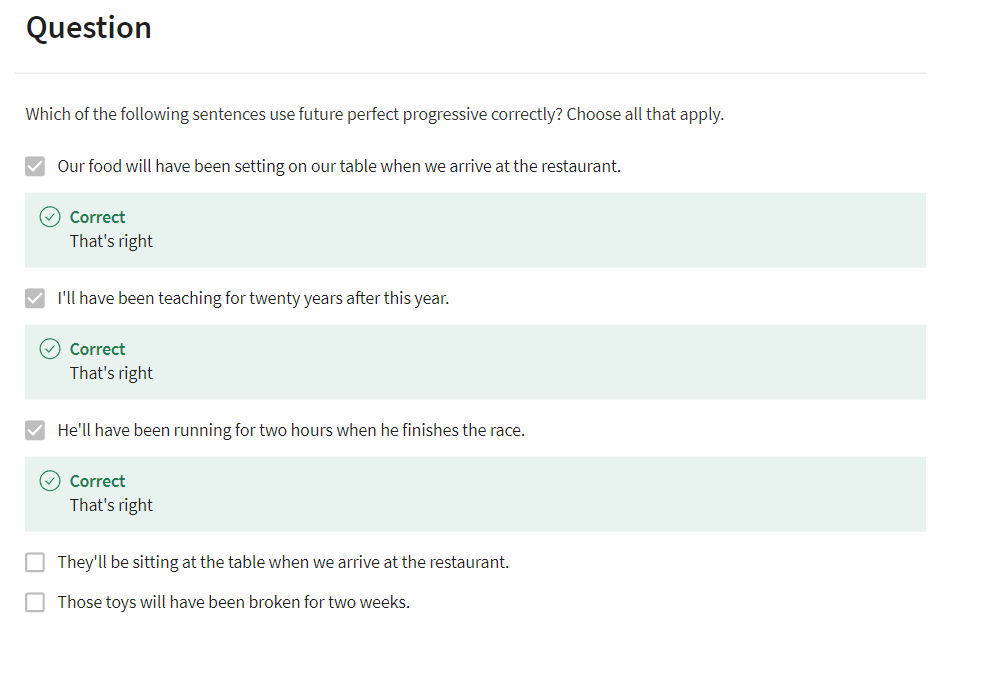
To form a question, the subject, we, in this case, and will, switch places. So it’ll become will we have been
sitting for a couple of hours already?
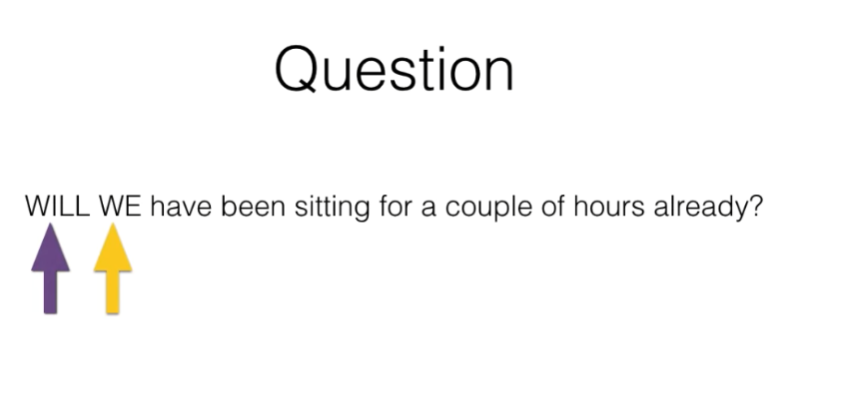
There is one specific reason we use
the the future perfect progressive. And that is to describe
a progressive activity in the future that comes before another future
activity or point in time. We shouldn’t go rollerblading. We will have been walking for
20 minutes by then. By then is a point in time in the future. Of course,
different durations of time could be expressed, like for
two hours, or all day. Any unit of time could go there. It is important to point out that
by then is a prepositional phrase. With the future perfect progressive, there
will always be another point of reference in the future, either stated or implied. We could also use a specific time
in the future, like 11 o’clock.
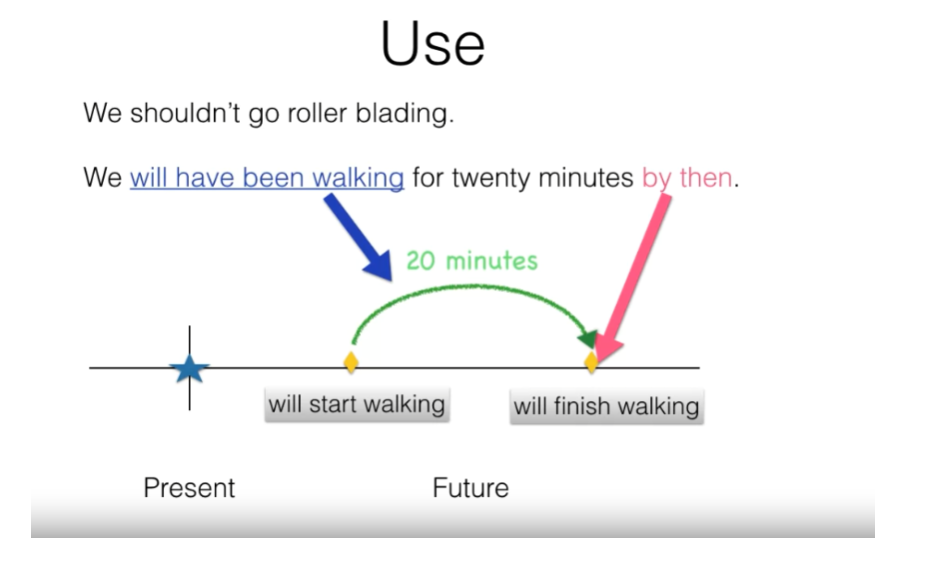
Let’s look at another example. Emily and
Jake will have been socializing for several hours by the time
they finish their date. In this example, the point of
reference in the future is represented as a dependent clause,
by the time they finish their date. Notice the verb tense in
the dependent clause. It expresses a future time but
it appears in the simple present. This is a common pattern you will see
with the future present progressive.
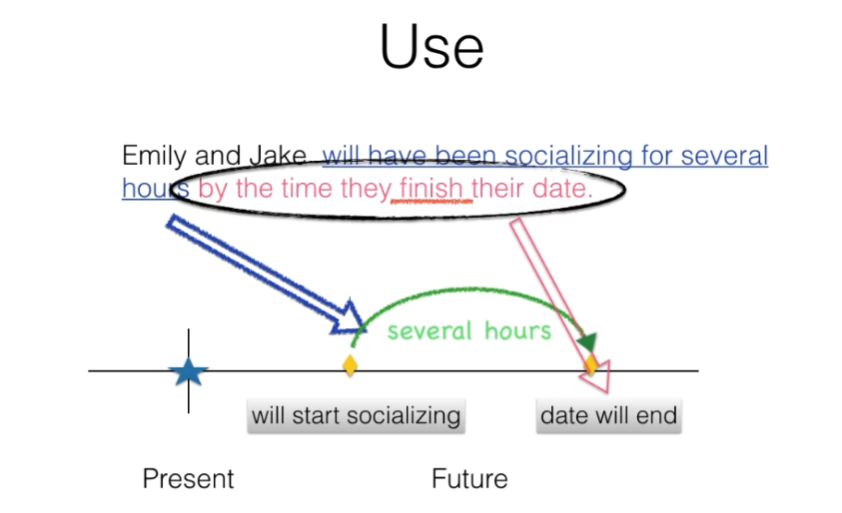
Okay, well, it looks like Emily and
Marco really liked each other, and now they’ve been spending
a lot of time together. Listen to a couple
conversations between them and see if you can identify the future
perfect progressive when you hear it. Here we go. >> So I was thinking after dinner
with my family on Friday night we could go catch a movie or something. >> Well,
I think I’m going to be pretty tired. We will have been talking
with your very charming and very talkative family for
quite some time then. >> Suit yourself.
Did you catch it? Can you complete the sentence with
the correct phrase in the future perfect progressive? >> That’s right, we will have been
talking with your very charming and very talkative family for
quite some time then.
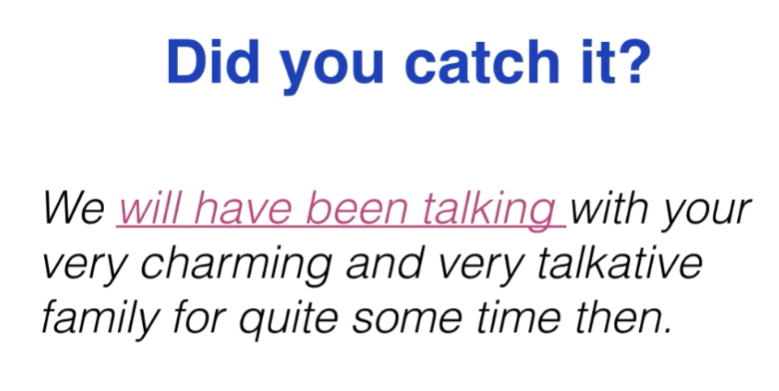
All right, let’s try one more. >> So do you think we could
be engaged by the holidays? Well, we will have only been going out a few months, so probably not. >> Did you catch it? Can you put the words in order to make the
sentence you heard in the future perfect progressive? That’s right. We will only have been going out for
a few months. All right,
that’s all the time we have for today. But I’ll just leave you with this thought. When this video is over, you will have
been practicing this verb tense for several minutes. I’m sure you will be tired. Thanks for listening.
Future Perfect Progressive Practice Quiz
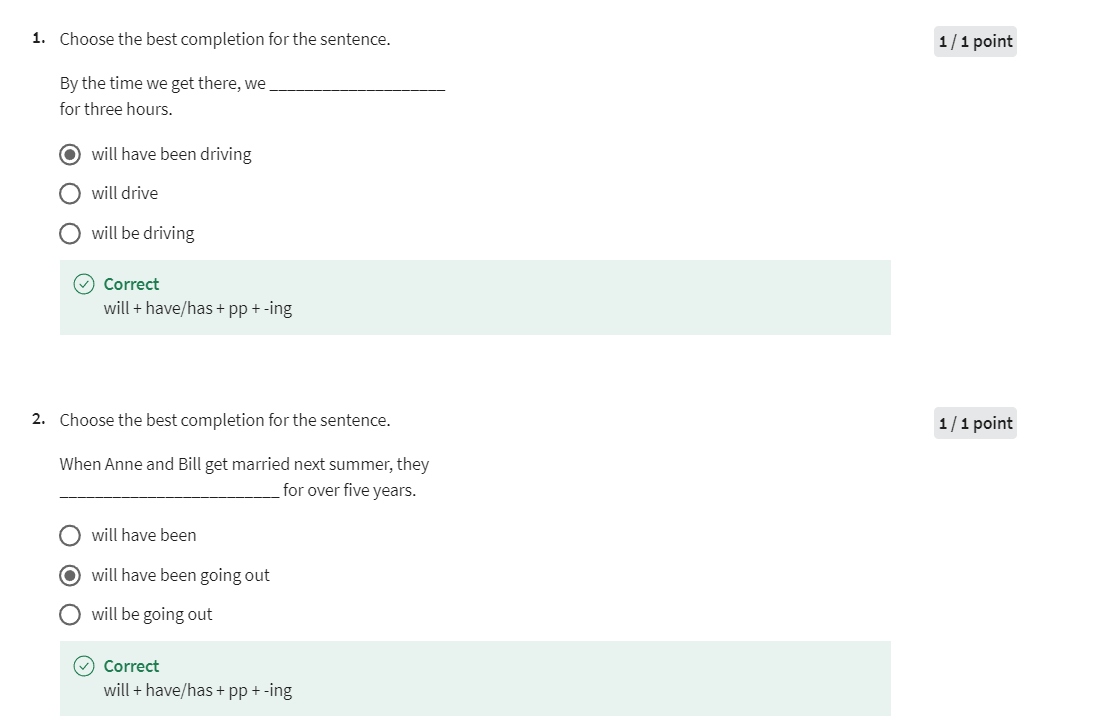
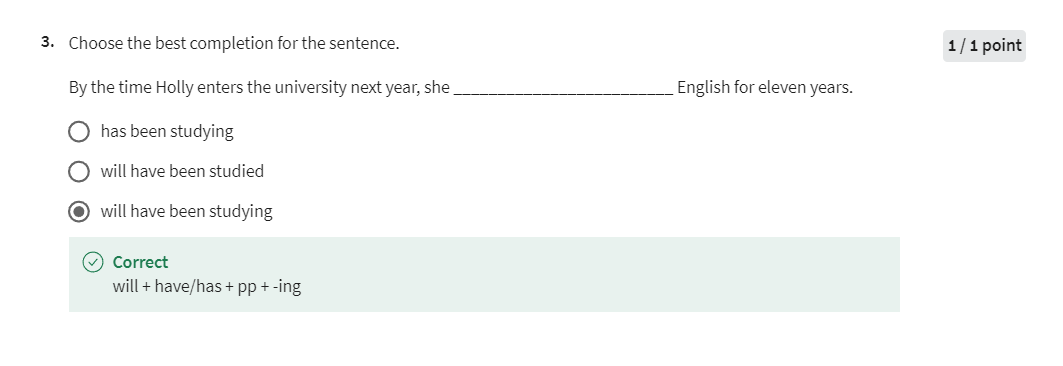
Future Perfect Progressive Practice
Practice
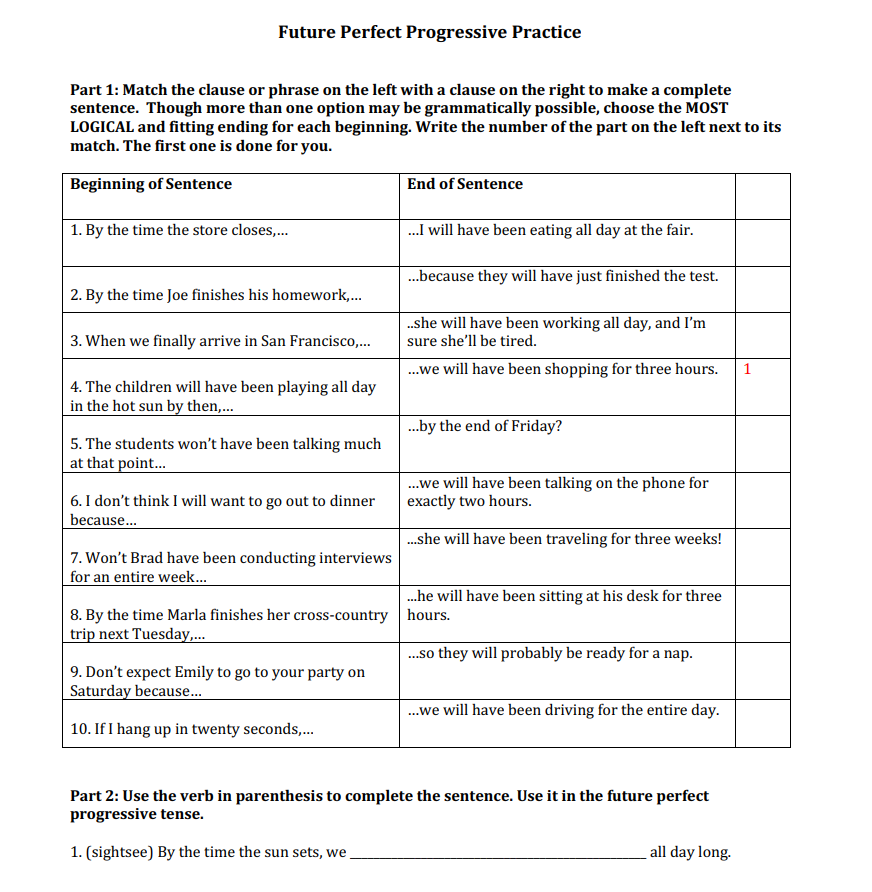

Answer key
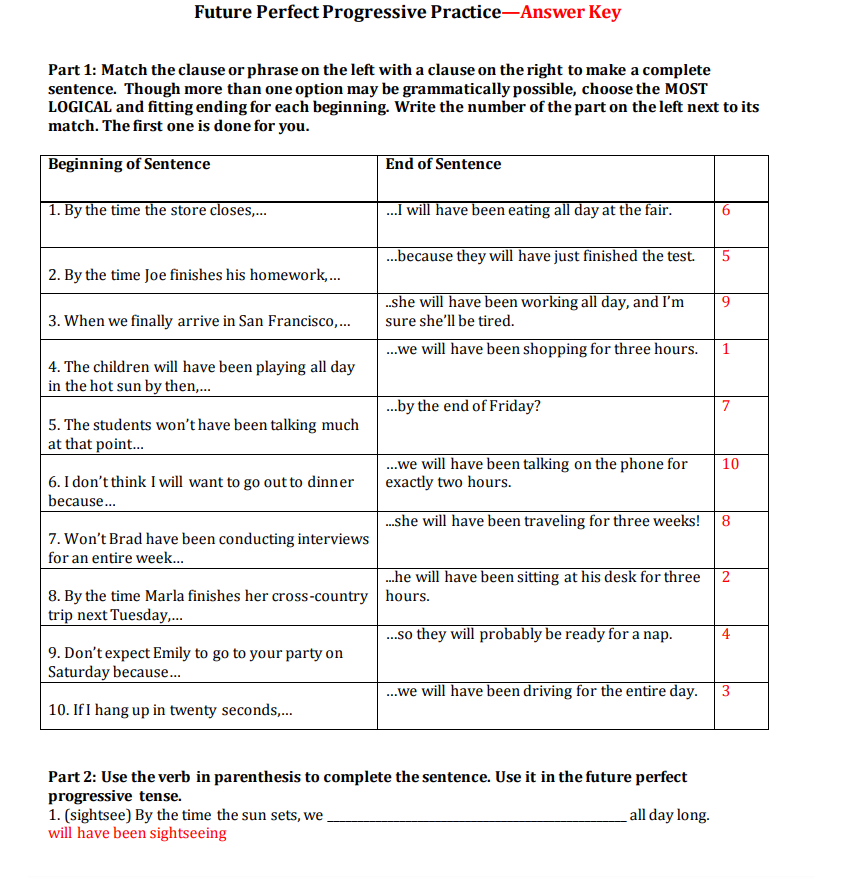
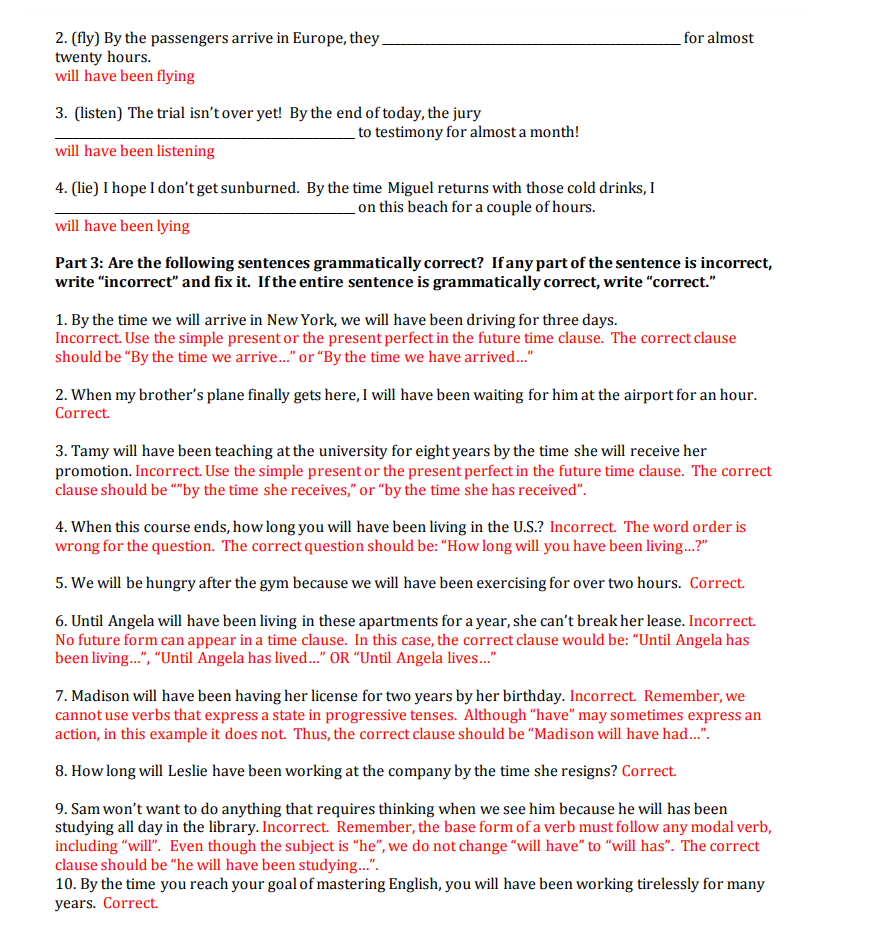
Graded Assignment: Perfect Progressive Assignment
You will get a chance to demonstrate your ability to use the perfect progressive tenses correctly. You will choose one topic below to write a conversation on that uses all three perfect progressive tenses correctly. You will need to be creative so that you can use a all of the tenses. You must include at least 10 perfect progressive verbs in correct form and in the correct situation. You also must use all three perfect progressive tenses. You will type the conversation here for grading. I**talicize your 10 verbs so they are easy to see.
Topics:
a boyfriend and girlfriend having an argument
a teacher and student talking about grammar
two friends talking about their weekend plans
two basketball fans talking about the game they are watching
Your conversation should look like this:
boyfriend: I have been looking for you for an hour.
girlfriend: Well, I have been waiting for you where I told you I would be.
boyfriend: …continue until you have 10 present perfect progressive verbs.
My try
Here’s a conversation between a teacher and a student talking about grammar using all three perfect progressive tenses:
Teacher: I have been explaining the perfect progressive tenses to you for the past week.
Student: Yes, I have been trying to understand them, but I still feel confused.
Teacher: I had been preparing for this lesson for a long time, hoping it would be clear to you.
Student: I had been studying the material before class, but it didn’t seem to help much.
Teacher: By the end of today, you will have been working on this for over an hour.
Student: I will have been thinking about this for days by the time the test comes around.
Teacher: I have been emphasizing the importance of practice. Have you been practicing regularly?
Student: I have been practicing every day, but I still make mistakes.
Teacher: I had been expecting you to grasp the concept by now.
Student: I had been hoping to master it by today, but I still need more time.
Teacher: By the end of the semester, you will have been studying English grammar for months.
Student: I will have been working hard to improve, and I hope it shows in my grades.
Graded Quiz
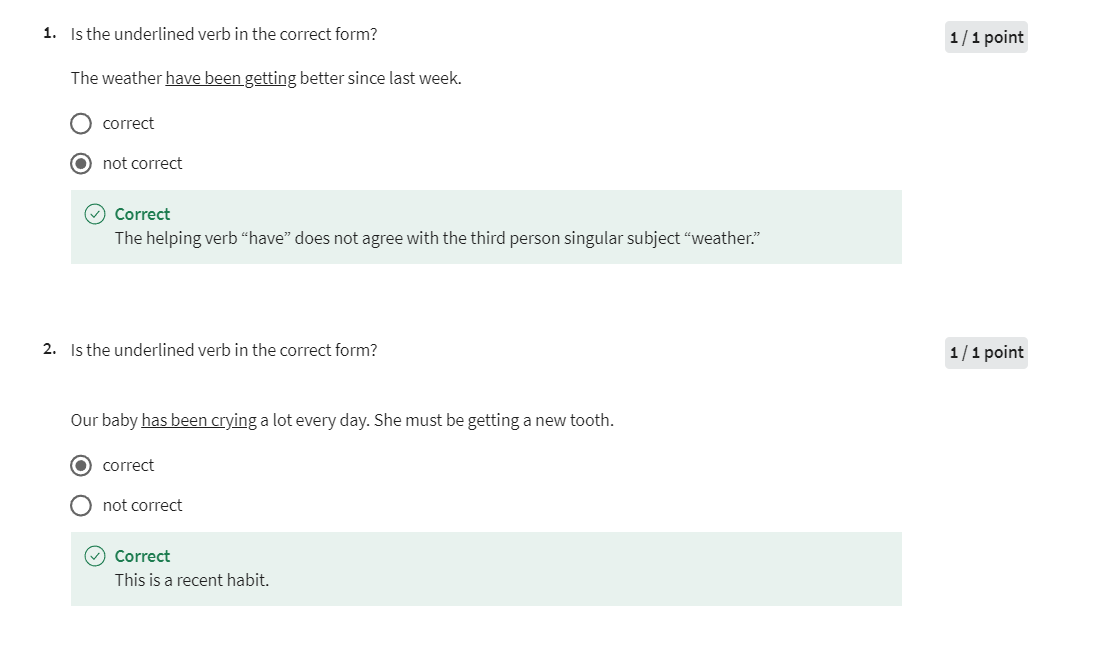
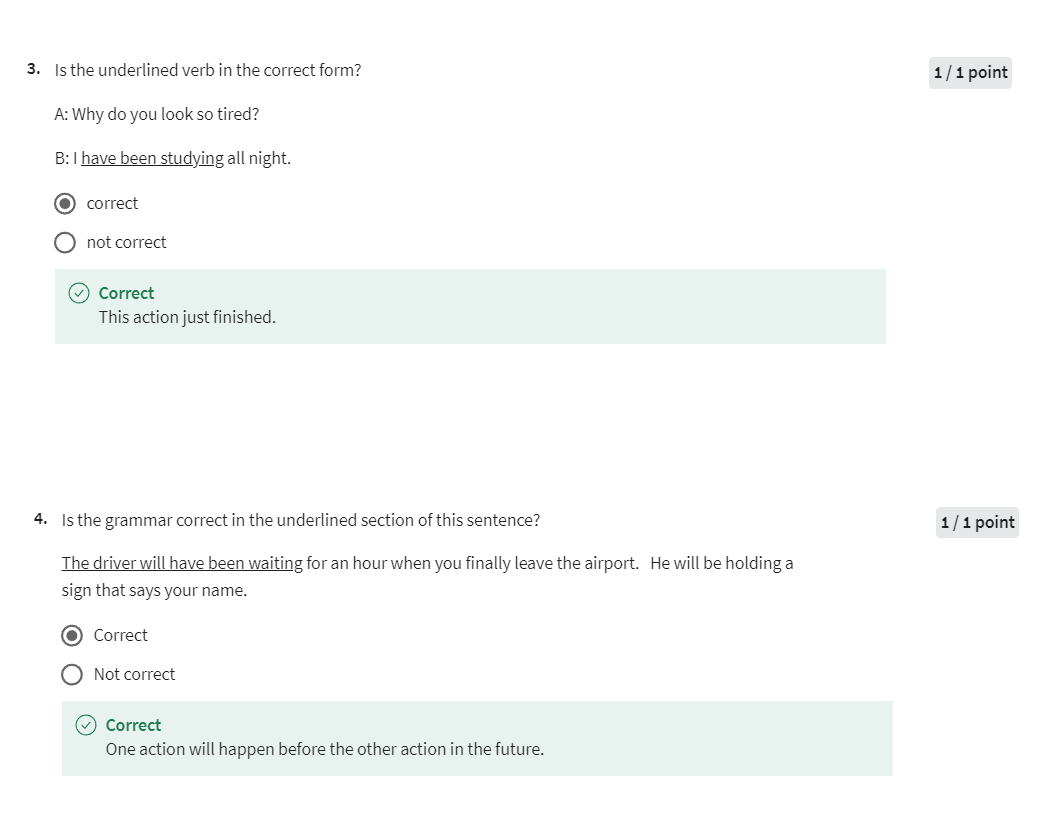
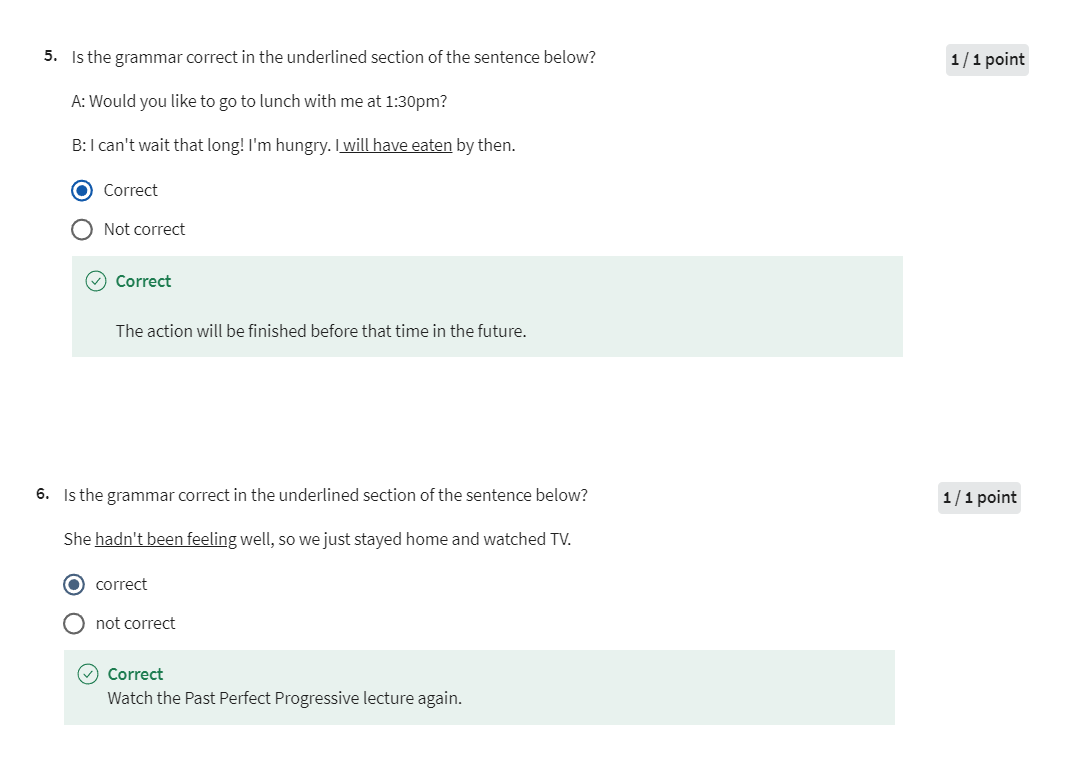
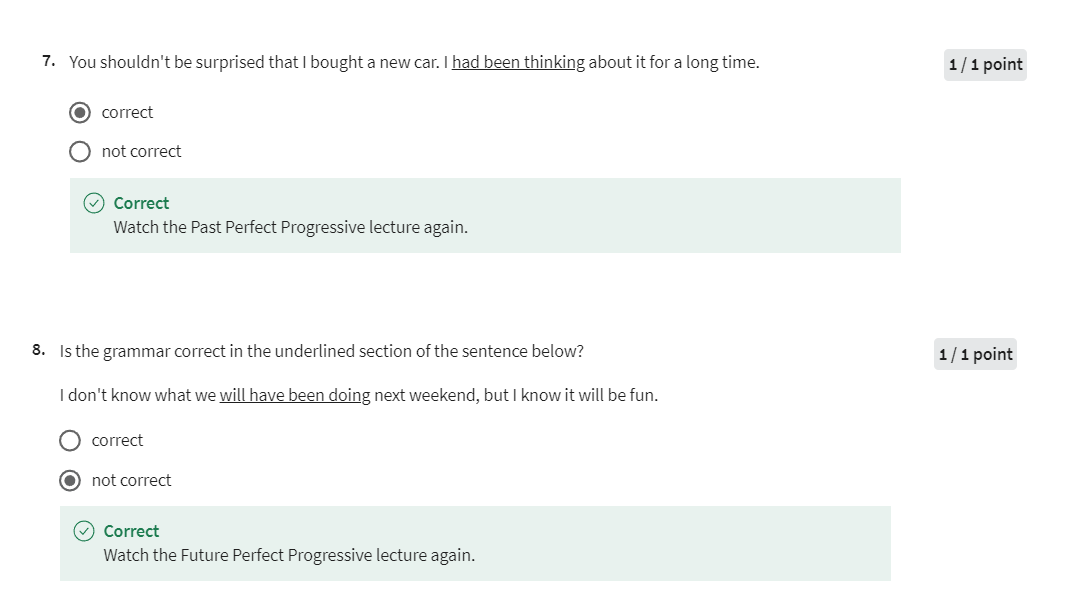
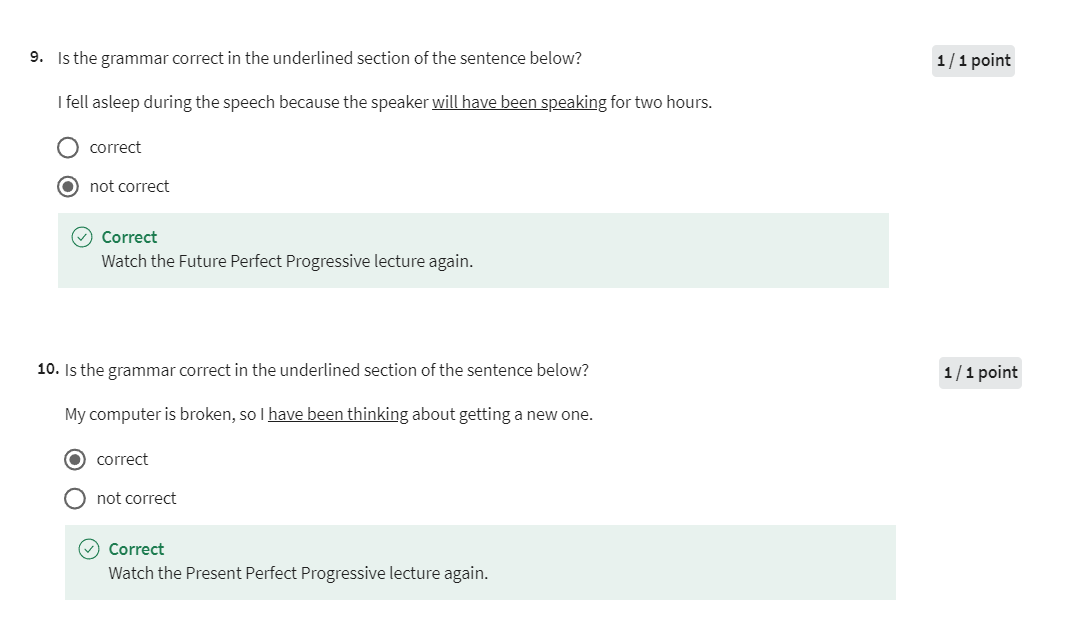
Week 03: Passives and Perfect Modals
In this week, you’ll learn about some more complicated verbs. Passives and perfect modals will take what you already know about verb tenses and add some more layers to it. Studying these will improve your fluency in written and spoken English.
Learning Objectives
- • make guesses about the past using correct grammar
- • distinguish between varying degrees of certainty about past events
- • use modals correctly to express regrets
- • recognize the difference between modals of regret and other modals
- • use modals correctly to express past obligation or necessity
- • use modals correctly to express lack of necessity in the past
- • use modals correctly to make inferences about the past
- • explain the purpose of passive verbs
- • form passive verbs correctly in sentences
Making Guesses about the Past Lecture
Making guesses about the past with modals. Here’s a picture of Emily’s desk. She’s very organized but look at it now. What do you think
happened to Emily’s desk? Maybe a thief broke into the office. Maybe a bird flew in through the window. Maybe Emily made a mess while she was
sleeping and then forgot about it.
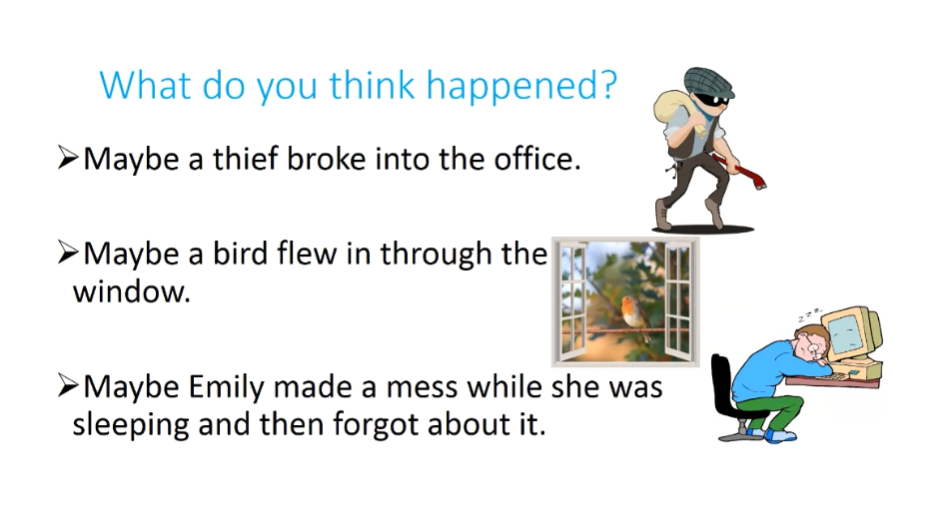
We are talking about
uncertainty in the past. We are not sure what happened,
we can only guess. It is important to remember that we
are not guessing about right now. These things probably didn’t happen but
maybe they did. Maybe expresses possibility but
uncertainty. We are not a 100% sure that this happened. When we are not sure what
happened in the past, we can also express this information
using modals which are helping verbs. A thief might have broken into the office. A bird may have flown
in through the window. Emily could have made a mess
while she was sleeping. These are followed by have and
the past participle of the verb.
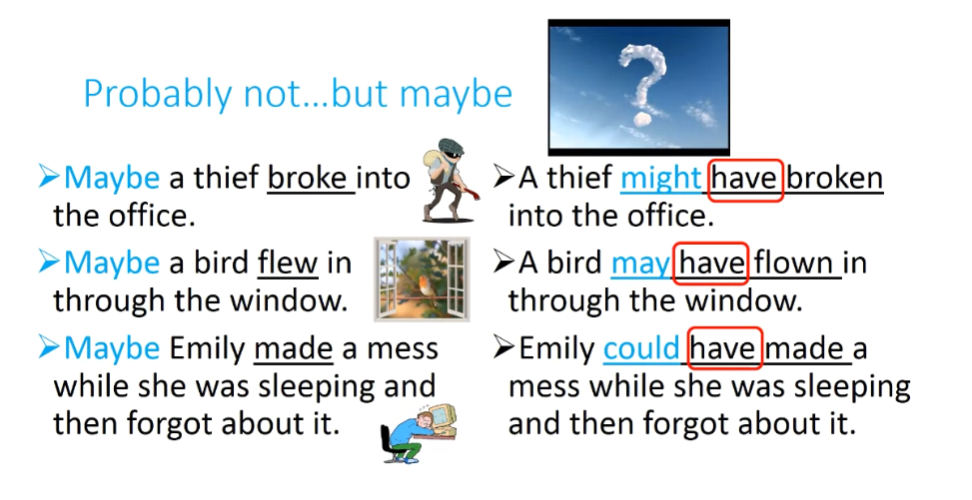
Let’s watch a conversation
involving this grammar. What happened to my desk? >> The wind might have blown your papers. >> The wind? It couldn’t have been the wind
because the window was closed. >> The cleaners might have done
it while they were cleaning. >> No, I don’t think so. It couldn’t have been the cleaners because everybody knows the cleaners
don’t come on Monday night. >> It could have been Matt. >> Matt? Come on!
He doesn’t even work here anymore. It couldn’t have been Matt. There is only one possibility. It had to have been you,
it must have been you. >> But it might not have been me.
Here are the characters in our story,
Emily and me. I’m Jake. What did I say about the past? The wind might have blown your papers. Here we use the modal have and
the past participle. You may recognize this as the same grammar
that we use in the present perfect tense. The cleaners may have done it. It could have been Matt. Or it also could’ve been me.
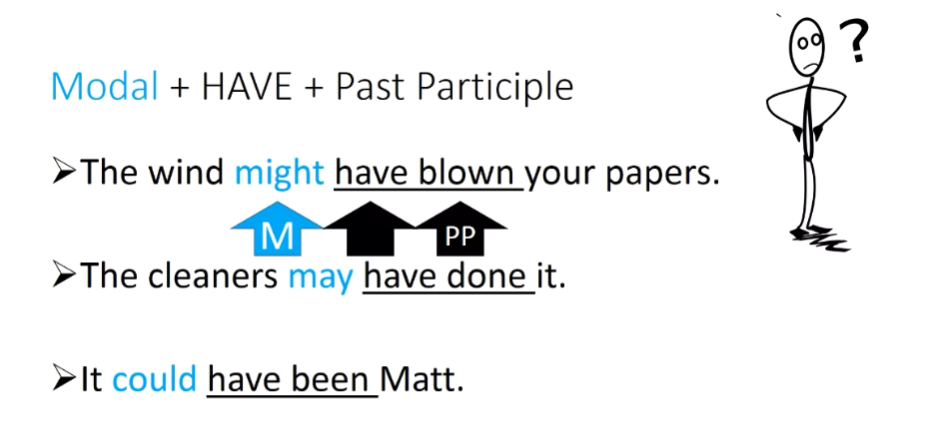
After a modal,
use the base form of the verb. In present perfect tense, we would say,
the wind has blown your papers. However, do not say,
the wind might has blown your papers. Always use have after
the modal with any subject.
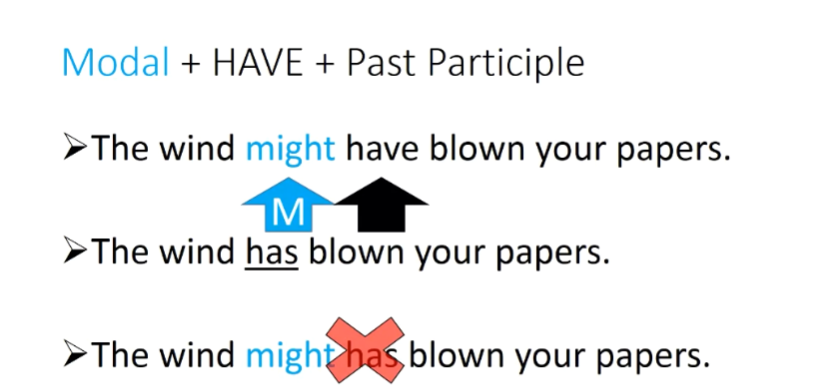
Here’s what Emily said. It couldn’t have been the wind. The window has been closed. It couldn’t have been the cleaners. They never come on Mondays. Matt couldn’t have done it. He doesn’t work here. If we use couldn’t have and
the past participle, this means we think
something was impossible. Emily also said, it had to have been you. Or we could also say,
you must have made this mess. Must have and had to have are used
to show that we are almost certain. Be careful in this grammar these
modals do not express necessity. It is not something we have to do,
it expresses our certainty or uncertainty about the past.
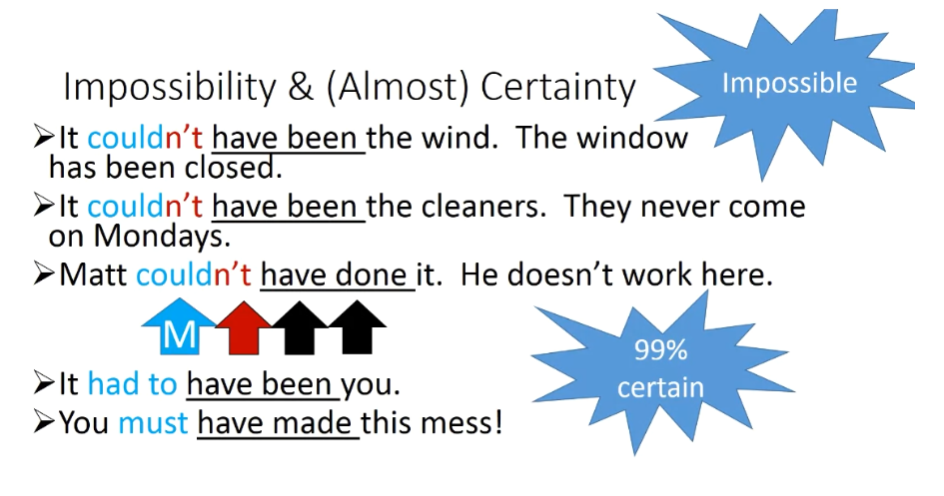
When we speak, it is very common to use
the contractions instead of the full form. It couldn’t’ve been Matt. It must’ve been you. When we pronounce this,
it sounds like couldn’t of, must of. It is okay to say this when we speak,
but do not use this in writing.
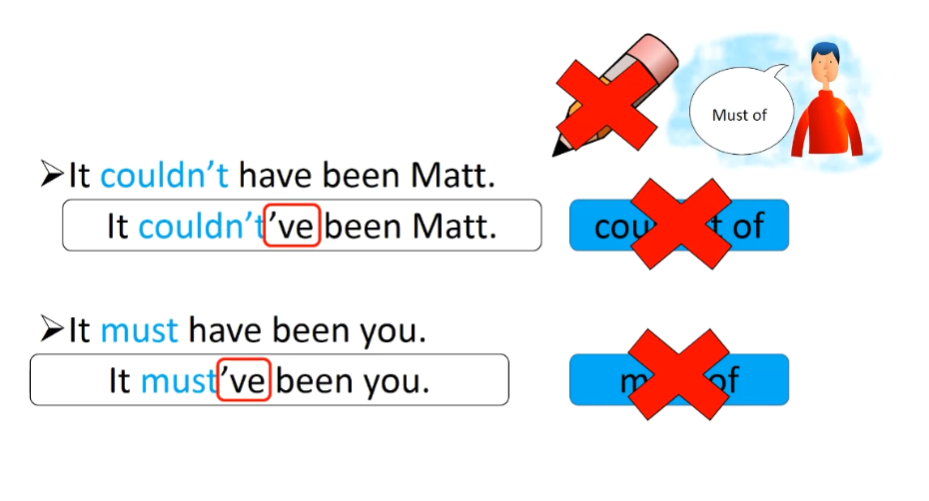
To form a yes no question, simply switch
the position of the subject and the modal. In American English could is the only
modal we would use in a question to express uncertainty in the past. This may vary with other
dialects of english. Could the cleaners have blown your papers? No, they couldn’t have. Could Jake have done it? Yes, she could have.
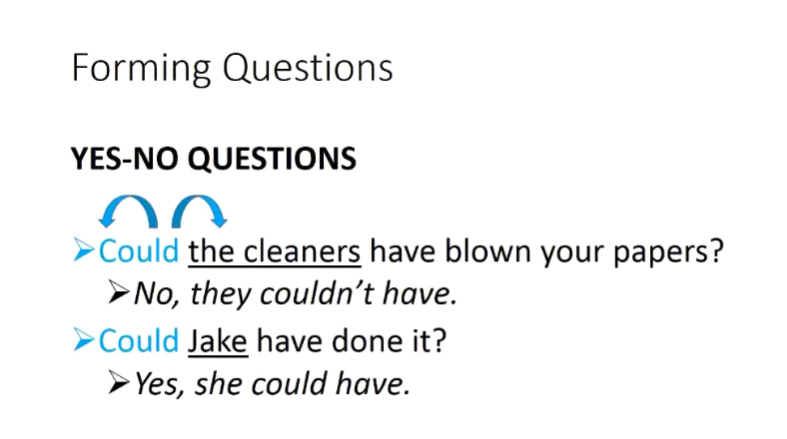
Let’s review. Here we can use modals with have and
the past participle for something that we aren’t really sure of. It’s just a possibility. Next, these modals can be used
to show that we are almost certain about something. Although there is still a little doubt. Finally, if something is impossible,
use couldn’t.
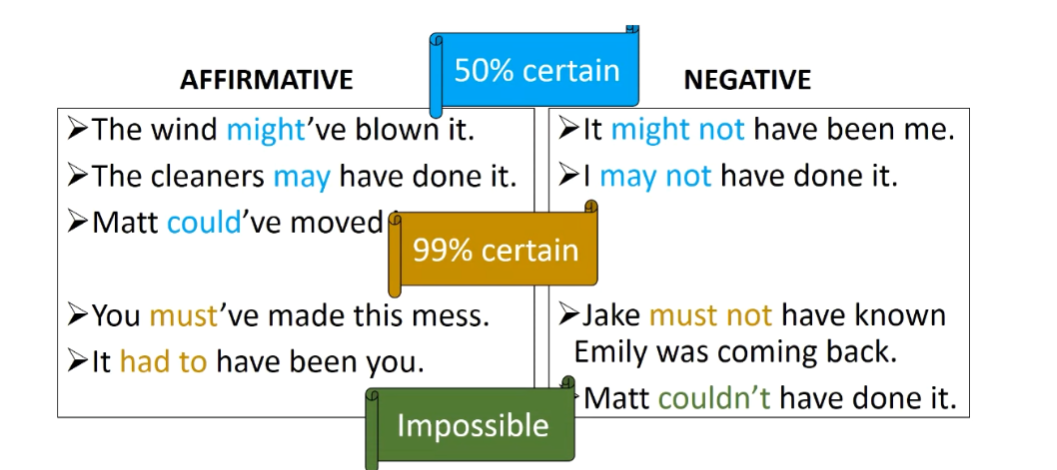
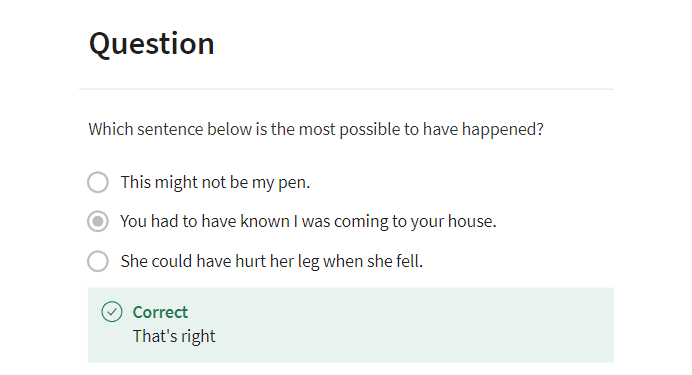
Making Guesses about the Past Practice Quiz

Making Guesses about the Past Practice
Practice
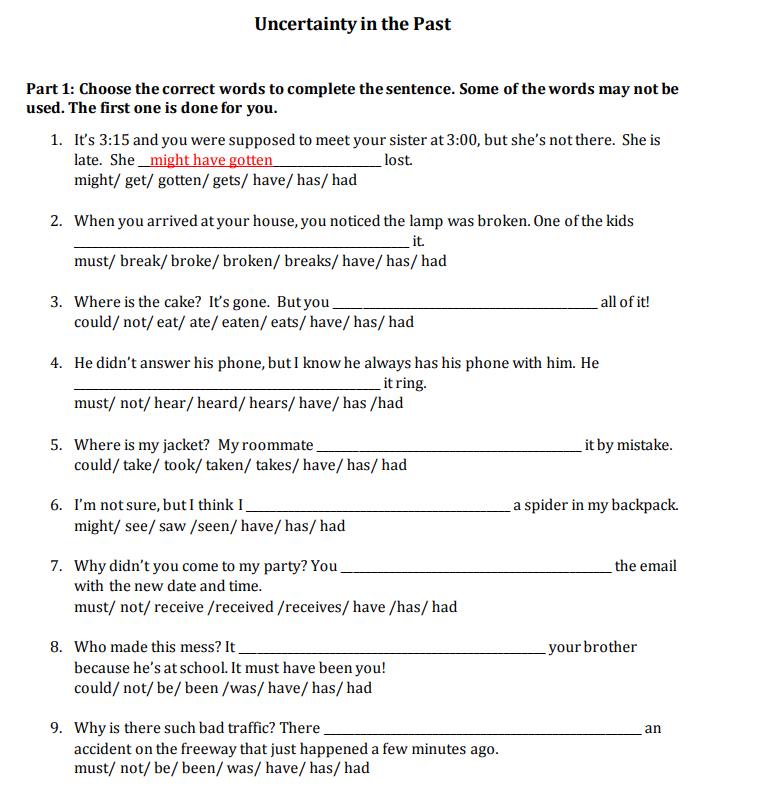
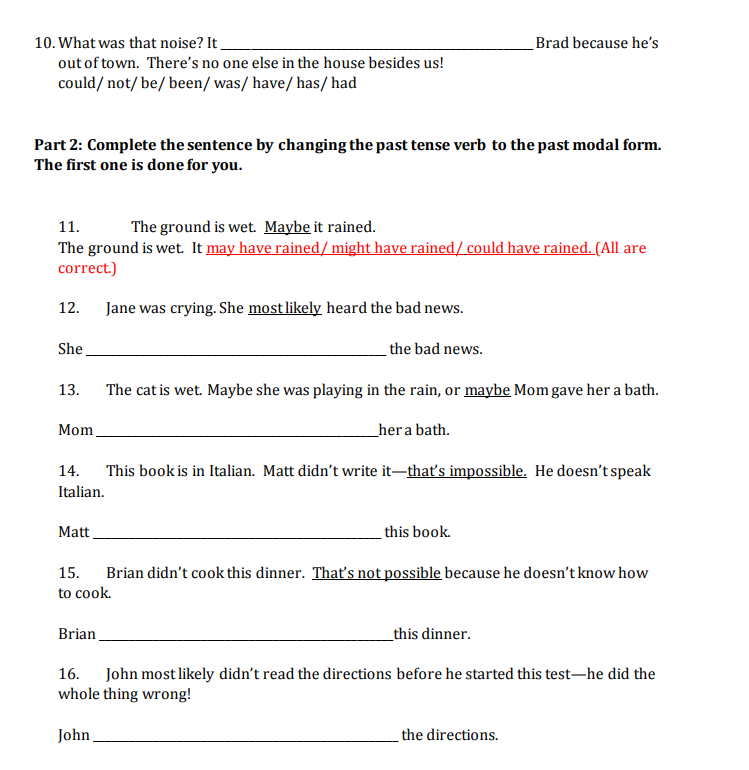
Answer key

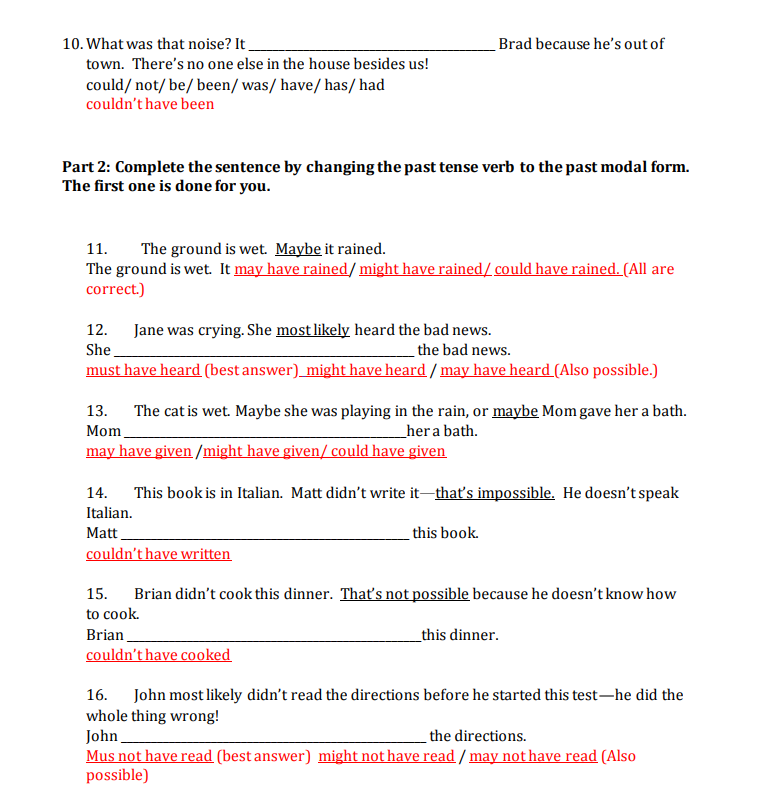
Expressing Regret about the Past Lecture
Reflecting on the past. Expressing regret and
disappointment with should have. By now, you probably know that should is
a word English speakers use frequently. Perhaps, you think of advice
when you see the word. You should study. You should clean your house. You shouldn’t eat too much. But did you know that you
could also use should with have and
a past participle to show regret or disappointment about the past?
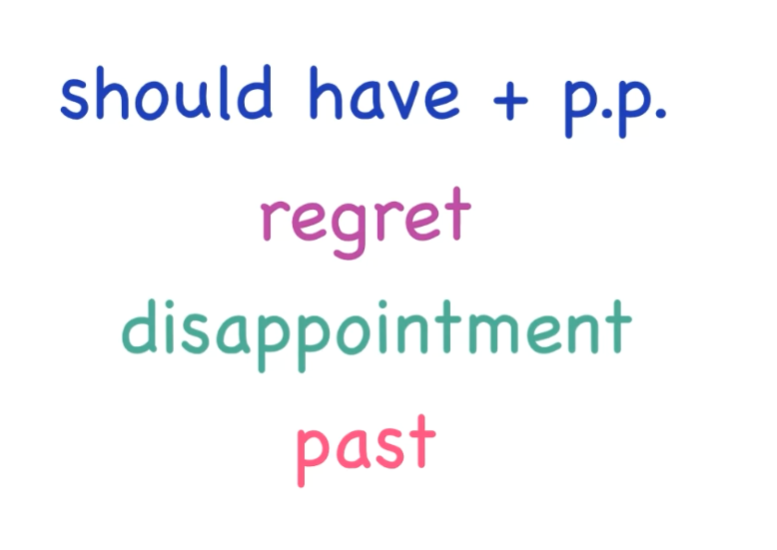
Take my experience as an example. Last Saturday, it was a beautiful day. The sun was shining. The crickets were chirping. So, I decided to go for a hike. However the experience was not
quite as perfect as the day was. I have a few regrets about that day,
let me show you what I mean. [Sounds] Which way do I go? Another crossroad. I’ll just look at my map. I didn’t bring the map. My phone, where’s my phone? I left it in the car. So stupid. In reality, I forgot my map. I didn’t bring my phone. I was not prepared. It was a mistake. In retrospect or looking backwards, I can see that I
should not have forgotten my map. You should always have
a map when you go hiking. I should have brought my phone. I should have been prepared. You know what, I regret it. I’m not happy about those decisions. Okay, let’s take a closer look
at these sentences on the right. We can use should have and
a past participle to talk about what we regret in the past or
what were disappointed about. Look at each this sentences. Should have and the past participle
of forget which is forgotten. Should have brought. Should have been.
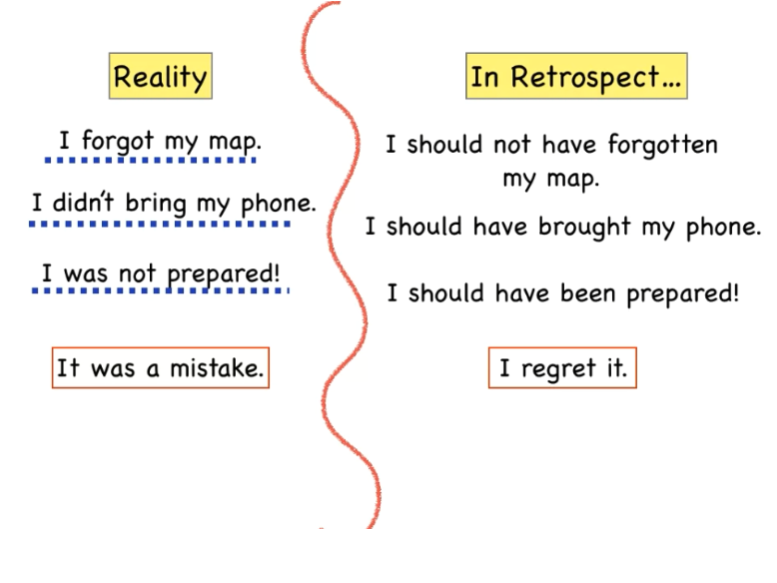
Okay, let’s take a look
at another example. >> Ow, ouch,
I can’t believe I twisted my ankle. These stupid shoes. All right. Again, I made a few
mistakes on my hiking trip. I twisted my ankle because
I wore the wrong shoes. It was a mistake. In retrospect or looking backwards,
I should have been more careful. I should have worn hiking boots. I regret it.
Can you find the past participles in each of these two
sentences with should have? Yep, been and worn. Which are the past participles of be and
wear. You know, my sister had advised
me to wear hiking boots. She’s pretty smart about hiking. I ought to have followed her advice. Ought to have is like should have. We also follow it with a past participle.
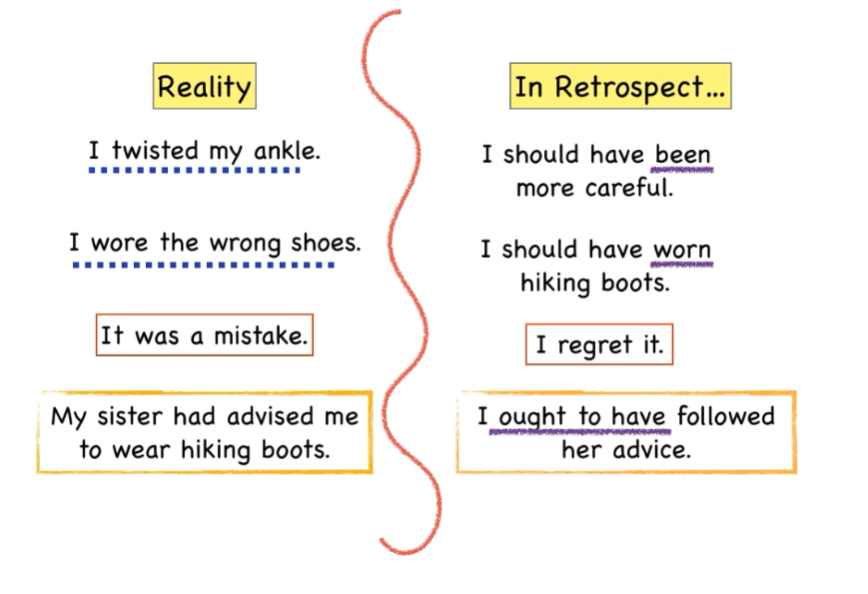
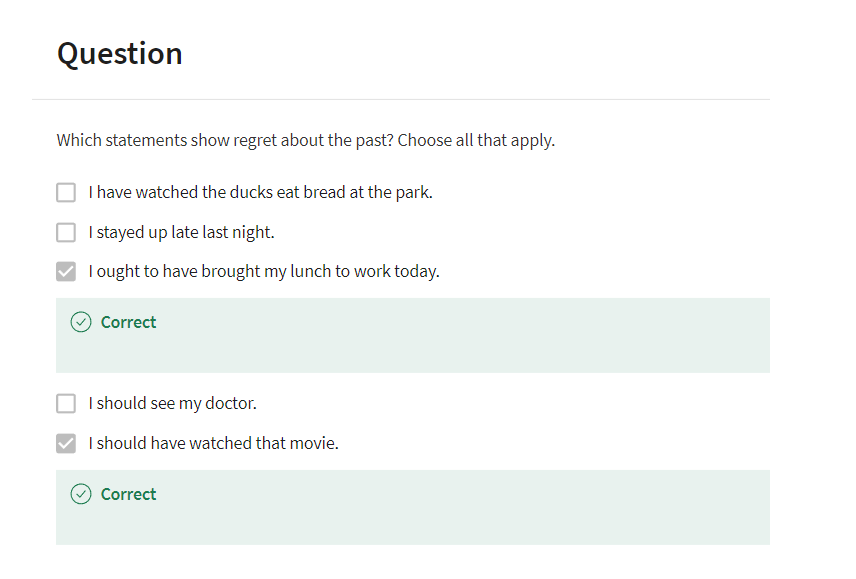
We can also use should have in a past
participle to give past advice.

Take a look at this example. Joe invited Molly to a Halloween party. He told her to wear a costume. However the day before the party, Joe called all his guests to tell them
it would no longer be a costume party. When Joe called Molly,
she didn’t recognize his number, so she didn’t answer it. Although Joe left her a message,
she didn’t listen to it. As a result, Molly was very embarrassed when she
arrived at the party dressed as a turkey. No one else was wearing a costume. In reality,
Molly didn’t answer Joe’s call. She didn’t listen to his message. She wore a costume to the party. Do you have any past advice for Molly? What should she have done? What shouldn’t she have done? She should have answered her phone. She should have listened to the message. She should not have worn a costume. Then, she wouldn’t have been so
embarrassed.
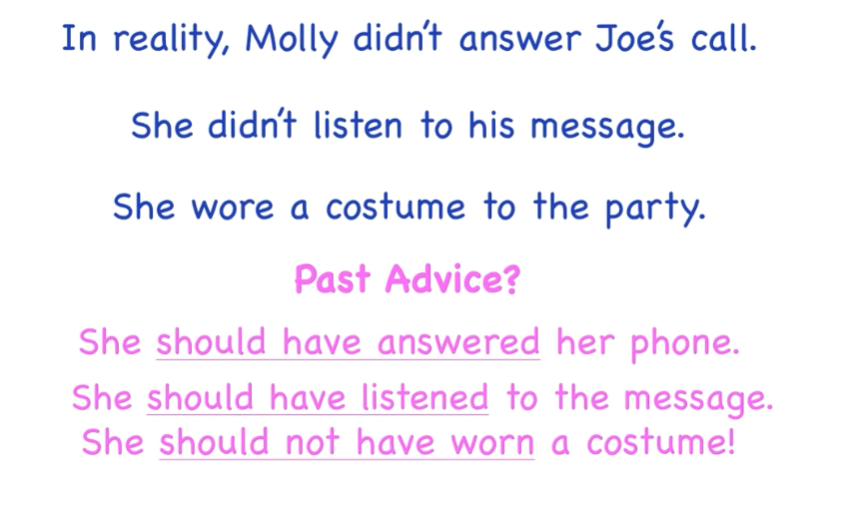
Okay, I’m going to show you
one more mistake I made. I think I’ll hike down this mountain. Looks like some exercise. Whoa! Whoa! My gosh.
Not a good idea. What did I do? Well, as you saw, I tried to hike
down the mountain and I fell. What should I have done? I should have been more careful. I should not have gone down that mountain. What do you think I should do next time? Well, I should probably be more prepared
for the possible dangers of hiking. Notice the difference between
using should in the past which is followed by have
in a past participle and using should to talk about the present or future which is followed by the base
form or simple form of the main verb. Also, like other module verbs,
when we form a question, should will precede the subject. It is then followed by had and
a past participle. What should I have done? It is also very common to
use the contraction forms. Should’ve, and shouldn’t have.
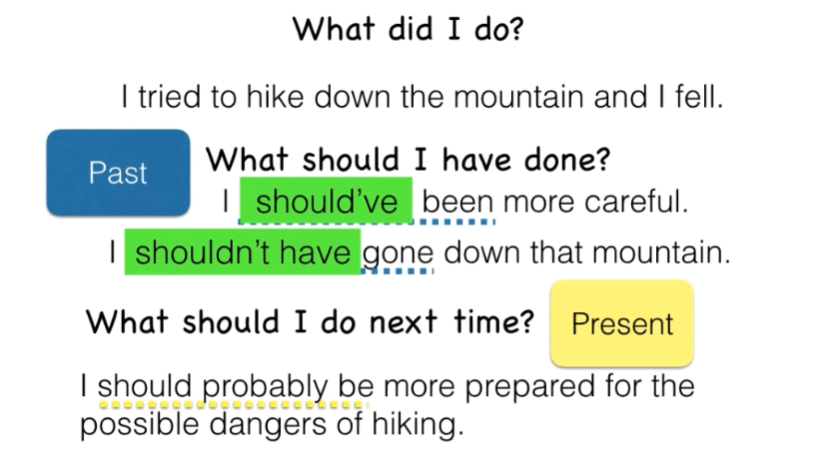
In this lesson, you learned how to use
should have with the past participle to express regrets, and
disappointment about past events. Thank you for listening.
Expressing Regret Practice Quiz
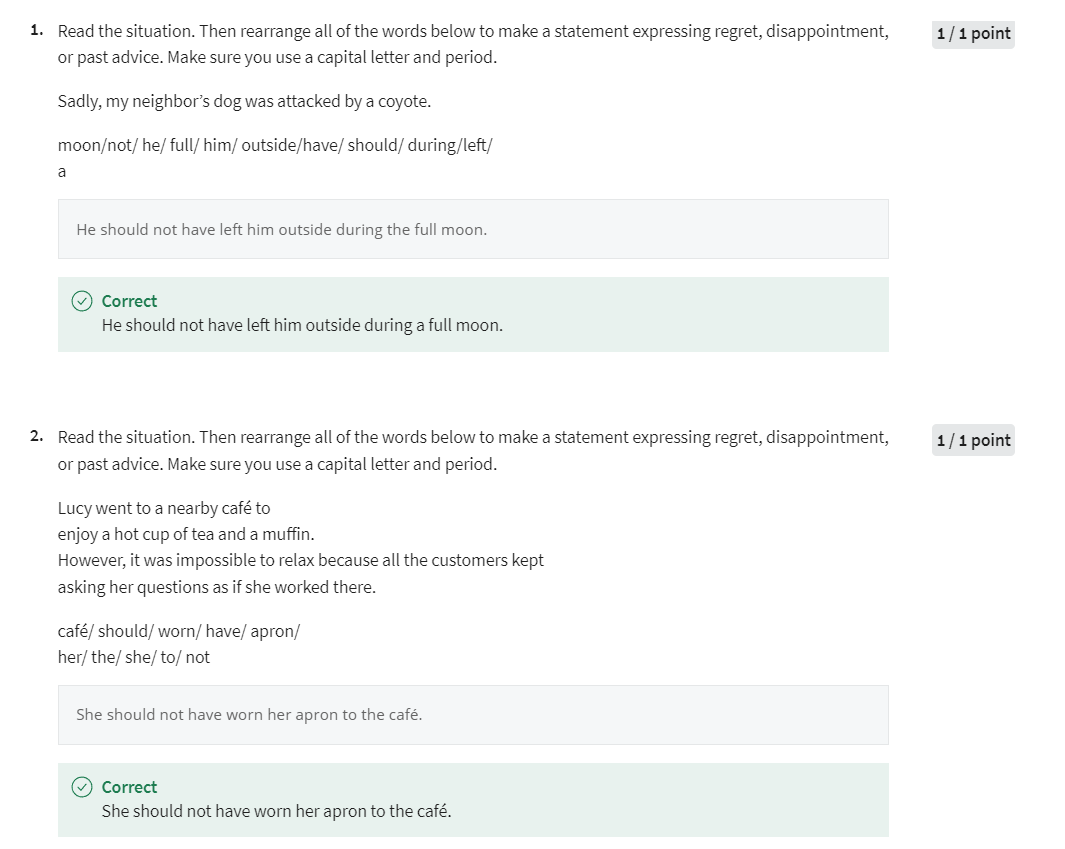
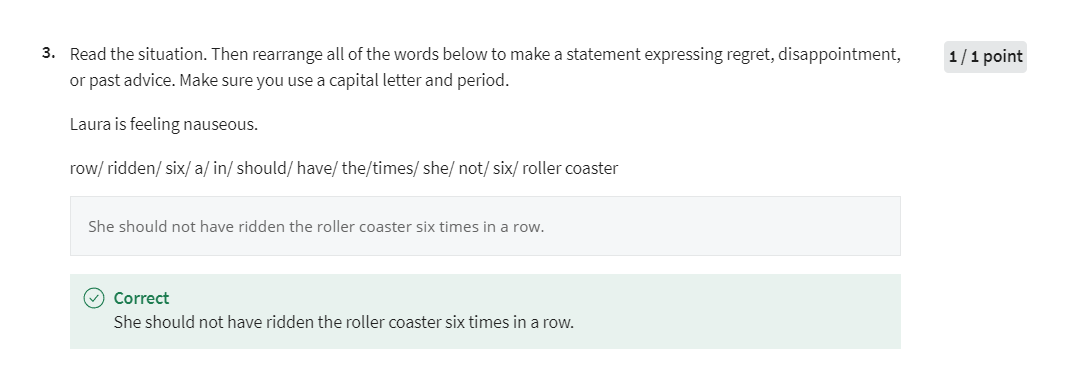
Reading: Expressing Regret Practice
Practice
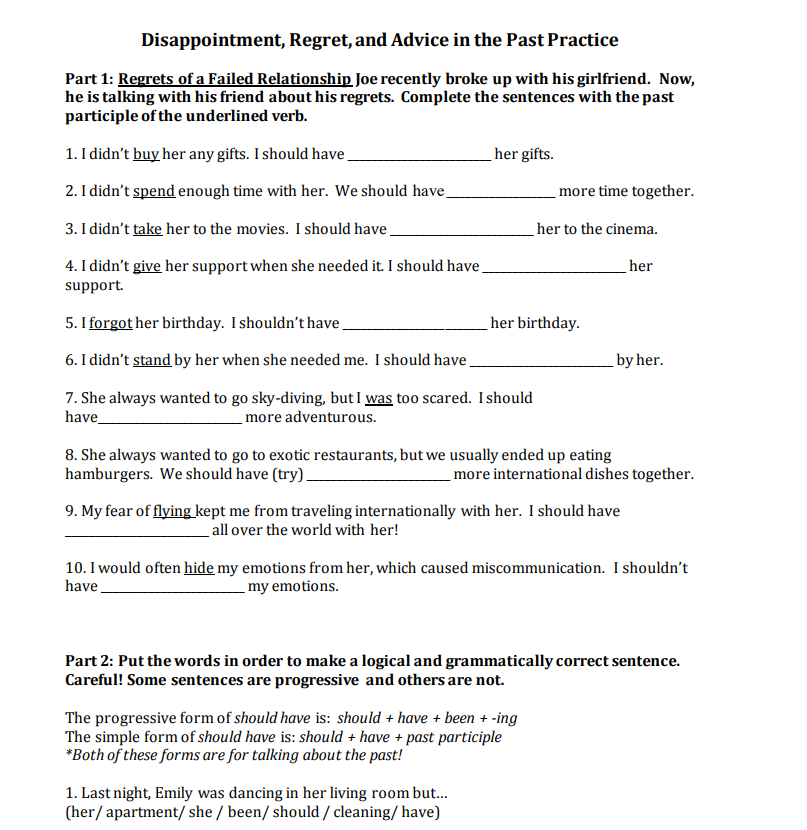
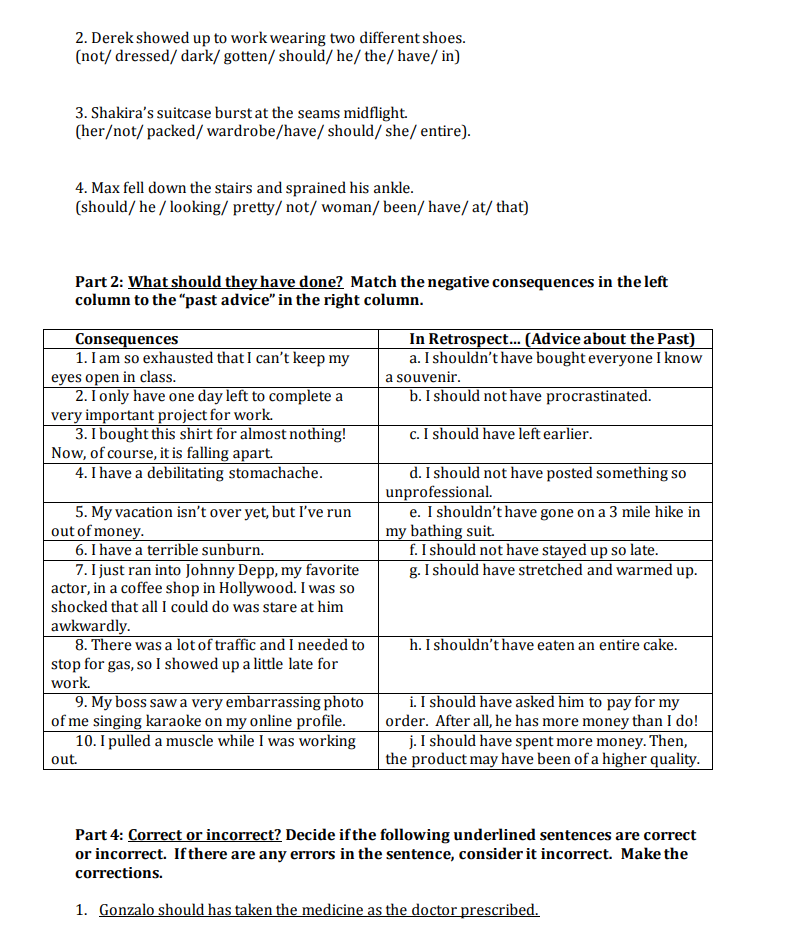
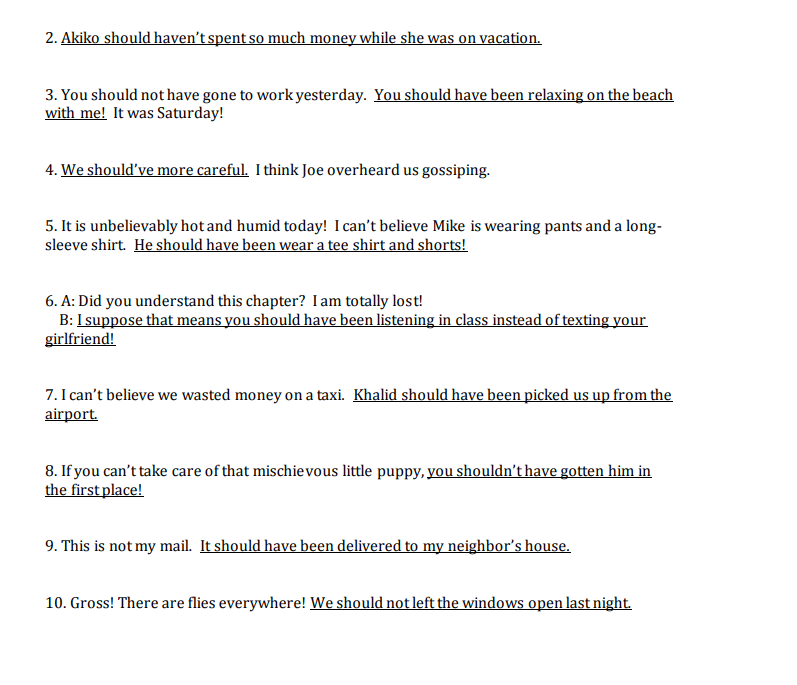
Answer key

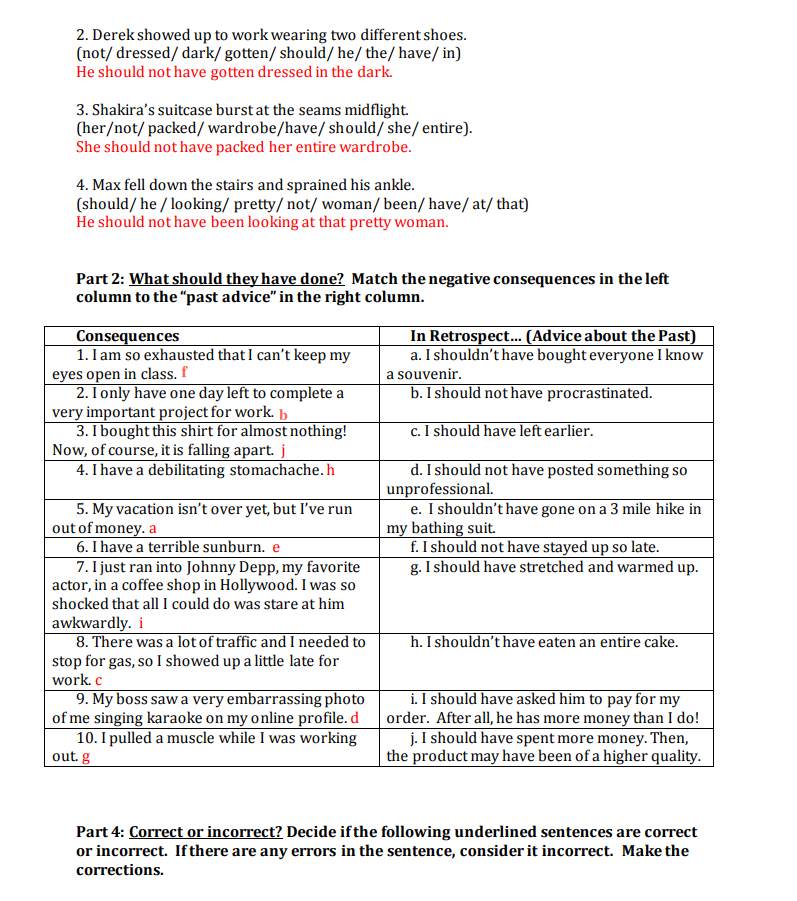
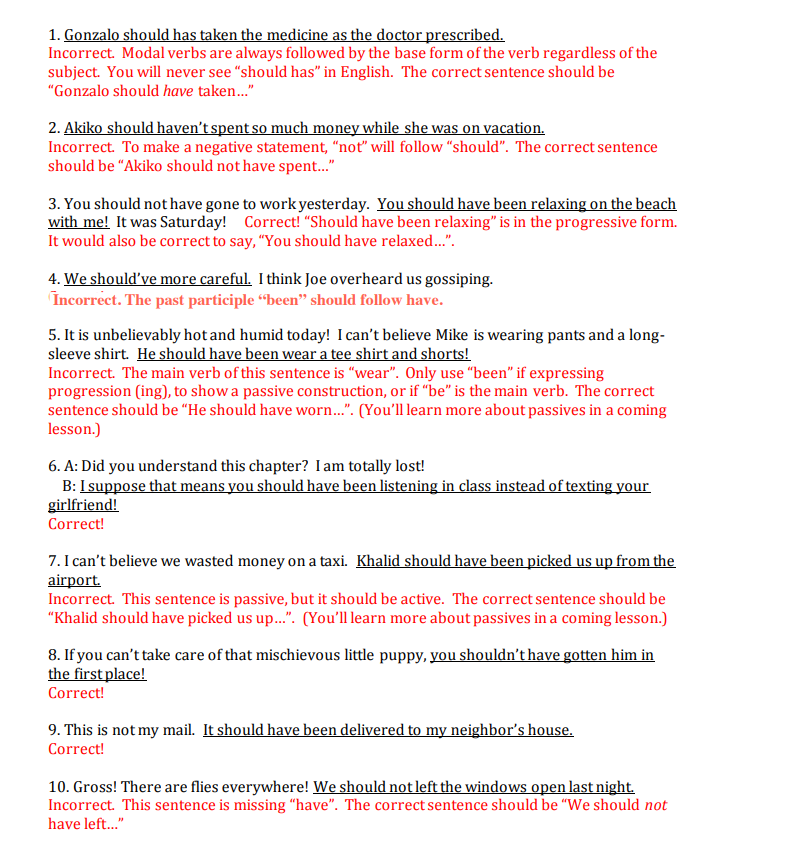
More Modals Part 1 Lecture
More Modals: Part 1. Must Have, Should Have, and Had To. In this lesson, you will learn to
distinguish between must have, should have, and had to. Which can often be confusing for
students of English. When must have and should have
are followed by a past participle and had to is followed by
the base form of a verb. We are talking about the past. However, they are use to
communicate very different things.
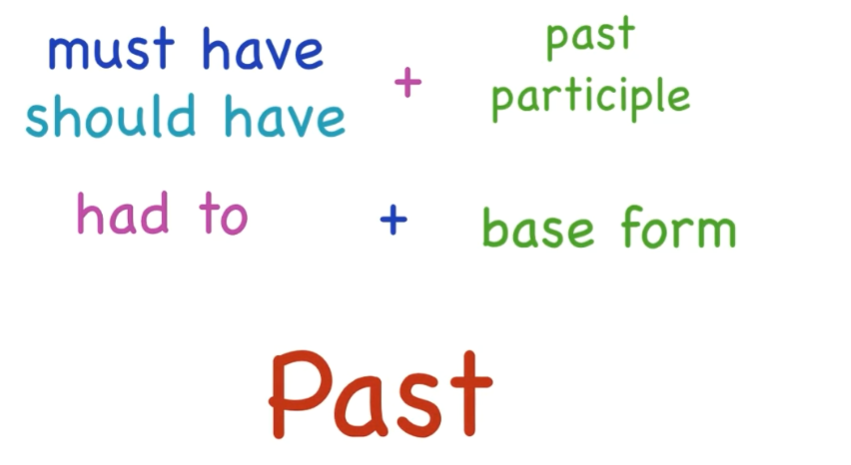
Let’s watch this short video
with the victim of a crime and a skillful detective for
some examples of how these verbs are used. >> Hi, ma’am, Detective Holmes. >> Detective Holmes. Thank goodness you’re here. >> Tell me what happened. >> Well, I was enjoying a delicious lunch,
and I had to step away for a moment because I had to
take a private phone call.
Can you complete the sentence
that you hear Jake say? Jake is the victim. That’s right, she said I had to step away for a moment because
I had to take a private phone call. Had to expresses a fulfilled obligation
in the past, or necessity in the past. Notice it is followed by the base form. Of the verb, not the past participle.
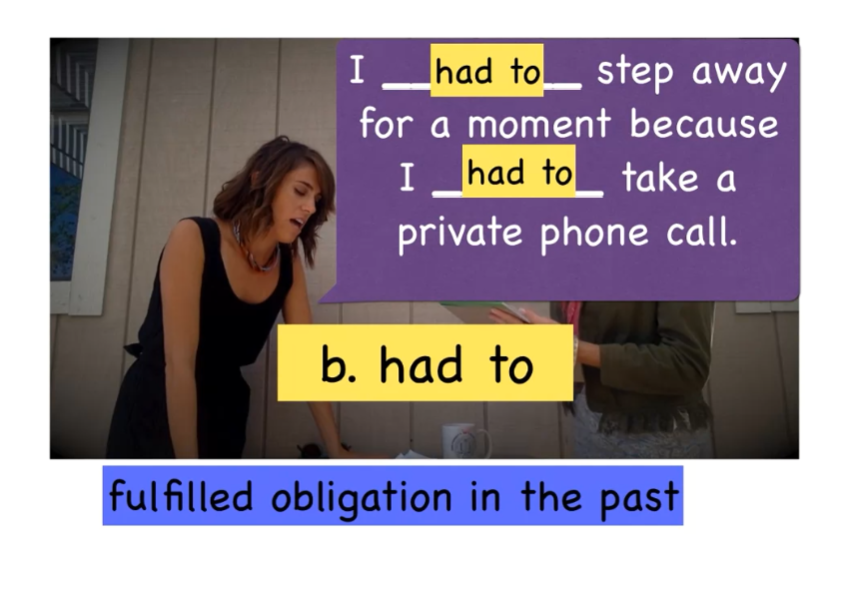
Let’s see what happened
when Jake left her food. >> And when I came back my wallet was gone
and more importantly my food was gone. >> Your food? Awful.
You saw it, Jake’s food and
wallet when she got back. That means that Jake made a mistake. Can you complete this sentence
with the correct modal? That’s right, Jake should not
have left her wallet unattended. When we use should not have,
we are showing regrets. Something happened that
was not a good idea. In reality, Jake left her wallet
unattended, and this was a bad idea.
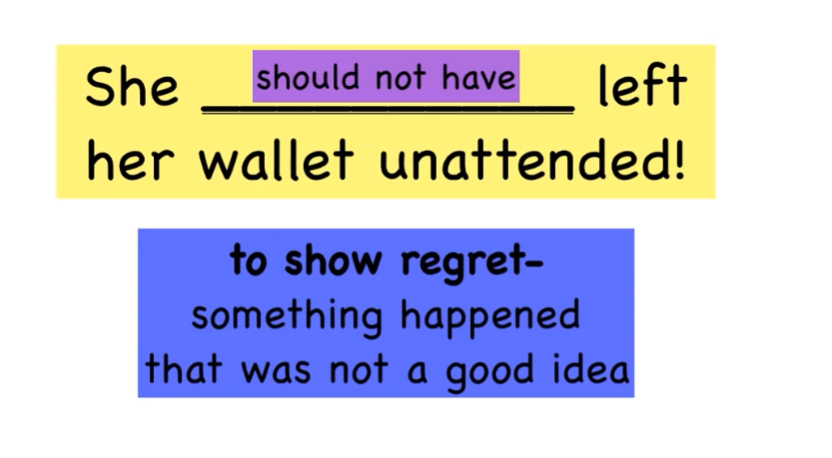
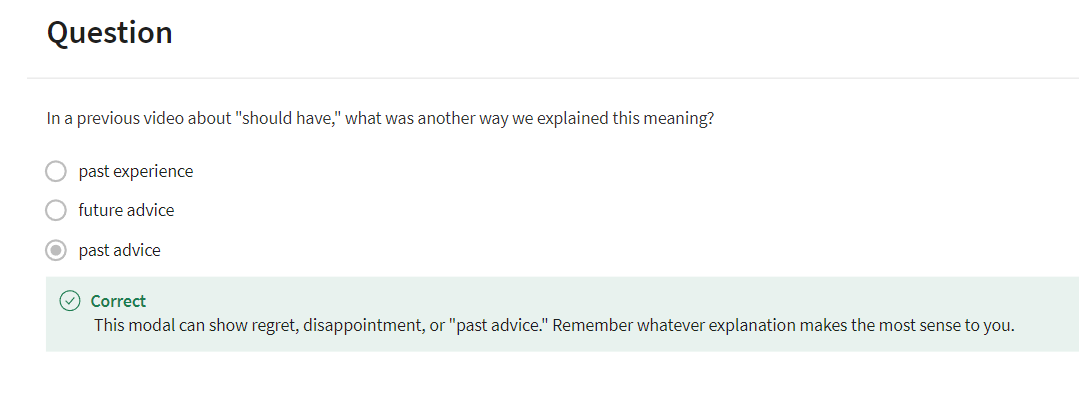
Notice, should not have,
is followed by a past participle, not the base form of the verb. Okay, let’s see if the detective
was able to find any evidence to solve this terrible crime. >> Don’t worry we are going
to get to the bottom of this. I’m going to find out who that thief is. >> Thieves must pay. >> That’s right,
first I want to ask you a few questions. Did you eat any food before you got up? No, the thief ate all of it,
the thief must have been really hungry. >> It looks like it.
What did you hear Jake say? Can you complete the sentence? That’s right,
she said the thief must have been hungry. We use must have with a past
participle to deduce or infer something about the past,
much like a detective would. The evidence for our deduction
is that Jake’s food was gone.

All right, let’s see if they were
able to find any more evidence. As you watch the next clip,
notice the different uses and tenses of the modal verbs. What’s this? >> Wait a minute. What is that? That’s lipstick. We’re you wearing lipstick? >> I don’t wear lipstick. >> Then the thief must have
been wearing lipstick. >> What is this? What’s this? >> I’m the expert ma’am. Just a moment. Mom, this is what appears to be a shoe. Is this your shoe? >> No! >> Then this must belong to the thief. She must have left in a hurry. Ew, and I think she should go shopping. Anyway, yes and was this popsicle yours? >> That’s mine. >> Well,
it’s still frozen which means that you must not have been gone for very long. >> That’s right and it also means that
the thief must not have gone very far >> I’m the expert ma’am, I’ll do this. >> Wow,
it looks like they are on to something. Okay, stay tuned for part 2 of this lesson,
in which you’ll learn a little bit more. About the usage of these model groups. See you soon.
More Modals Part 2 Lecture
More Modals Part 2. In the first part of this lesson,
you saw a lot of good detective work, you also saw a lot of modal words. In this part of the lesson, we’re going to talk about the differences
between these modal verbs and we’ll also look at a few common errors that learners
of English make when using these modals. Let’s start with must have and
a past participle, which we use to make
a deduction about the past. Think of a detective, or
of someone thinking about the past. For example, the thief lost her shoe. This is our evidence. She must have left in a hurry. This is our deduction
based on the evidence. Careful. Although must and
the base form of a verb does express necessity in the present,
like you must catch the thief. It is necessary. Must have and a past participle does
not show necessity in the past.
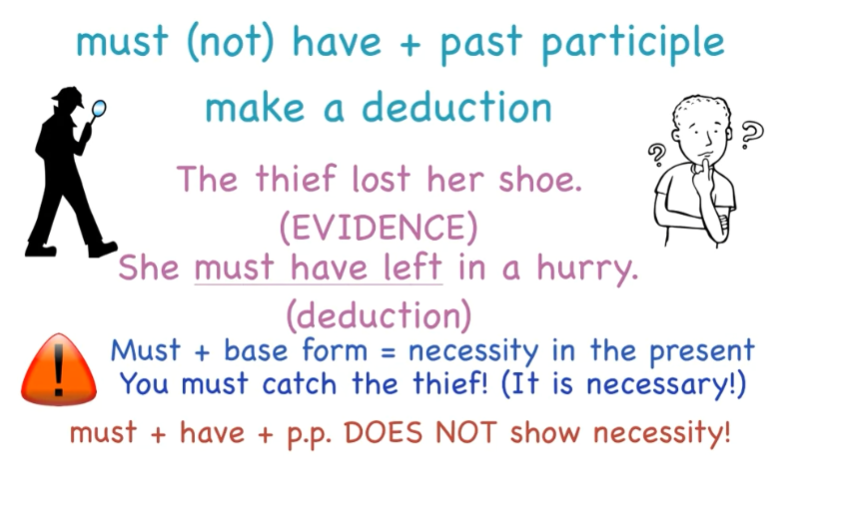
Let’s look at a verb that does do so. When we use had to and
the base form of a verb we are expressing fulfilled obligation in the past or
necessity in the past. For example, Jake had to take a private
phone call, it was necessary. When we use didn’t have to and
the base form of a verb, we are expressing lack of
necessity in the past. Clearly, the detective didn’t have
to look very hard to find clues. They were everywhere. Finally, we can use had to plus have and
a past participle when we want to make a strong
deduction about the past. When we are almost 100% sure
that something happened. It’s very similar to must have and
a past participle. That thief had to have been hungry. That thief must have been hungry
because all the food was taken.
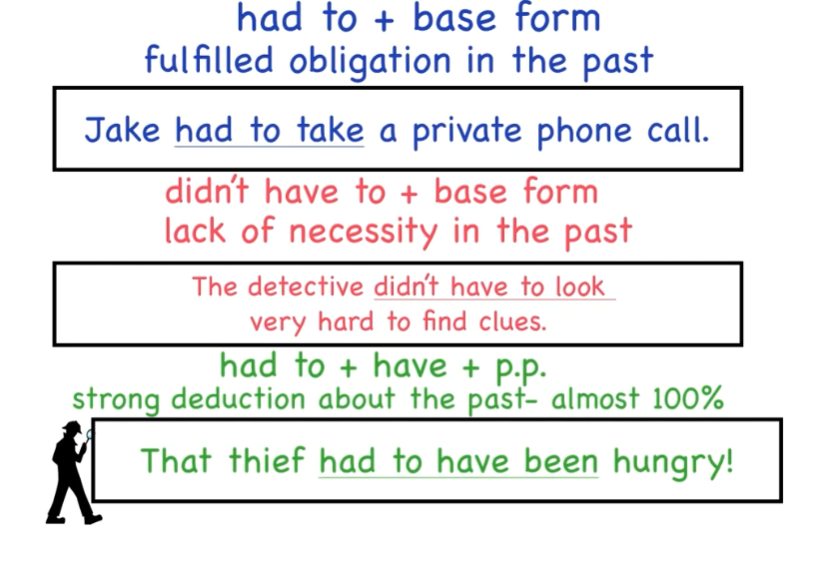
All right,
you already know that should have and a past participle is used to show
regret about a past time situation. For example, Jake should not have
left her wallet on the table. In reality, Jake did leave her wallet on
the table, and that was not a good idea. Jake should have been more careful. In reality, Jake was not careful.

You should also be careful
when using this modal verb. To express a fulfilled obligation
in the past use had to, not should. Let’s look at an incorrect
sentence to see what I mean. It’s wrong to say, I couldn’t go to the
movies because I should do my homework. It’s also wrong to say, I couldn’t go to the movies because
I should have done my homework. In the first sentence,
it’s a tense problem, should plus the base form of
a verb is used to express necessity in the present or
future, not the past and clearly this speaker is talking about
the past because we see the verb couldn’t. The second sentence is wrong for
a different reason. It’s a meaning problem. Should have done my homework implies
that I did not do my homework, when in fact the speaker
did do her homework. She had to do her homework. The right way to say this is I couldn’t go to the movies
because I had to do my homework.
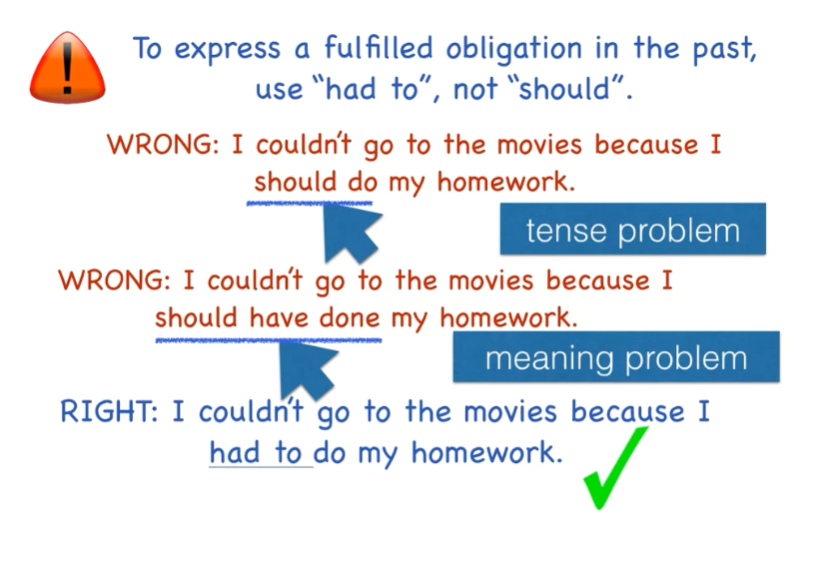
Alright, it turns out that that crime that you saw on the first part
of this lesson has been solved. They found some secret security footage. Take a look. >> This looks like a delicious feast. [SOUND]. And someone forgot their wallet. That’s not good. I better take this to the police, I don’t
want this good food to go to waste. I’m going to be late for
my appointment, I better hurry.
More Modals Practice Quiz

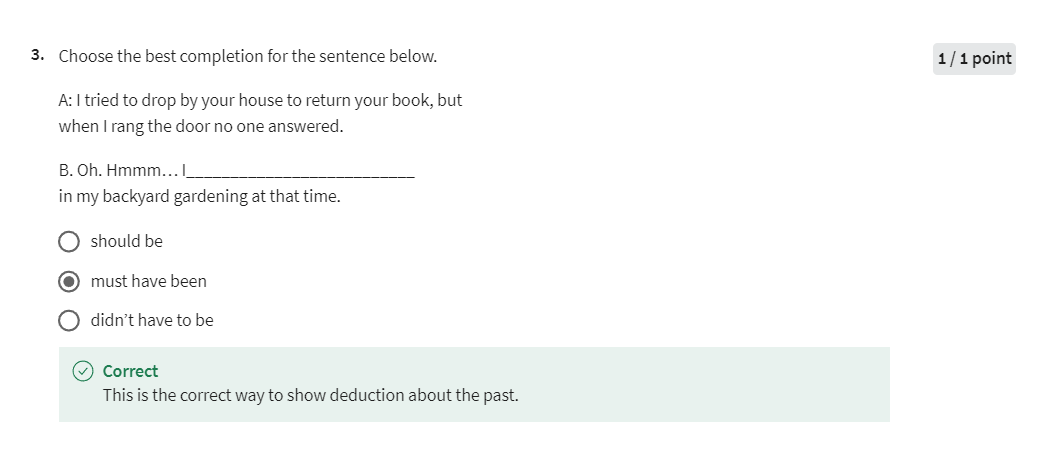
More Modals Practice
Practice
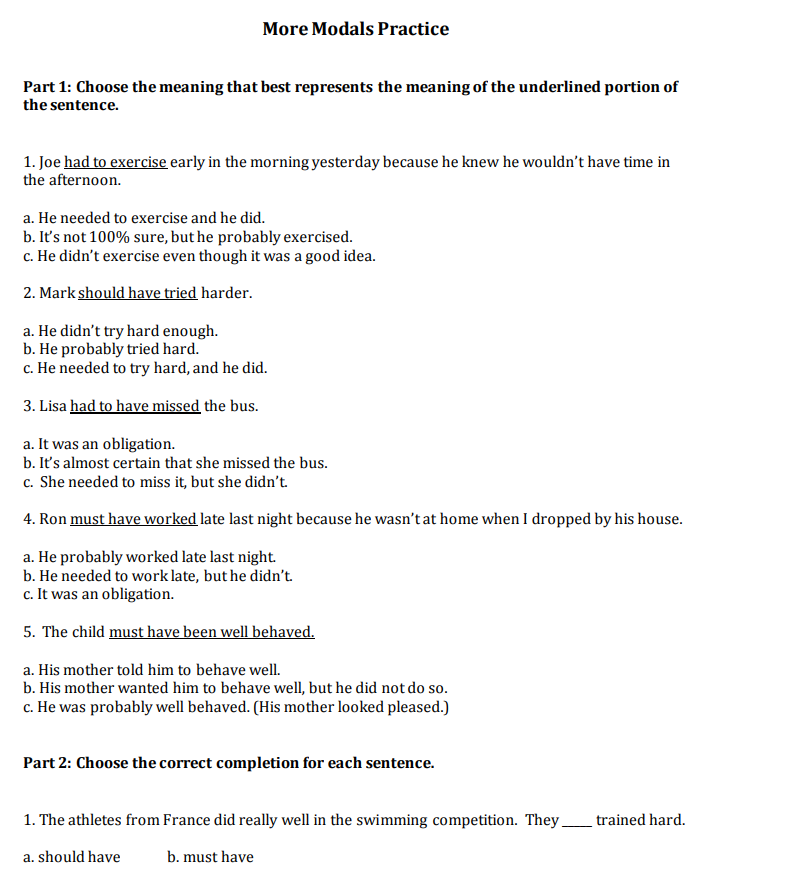
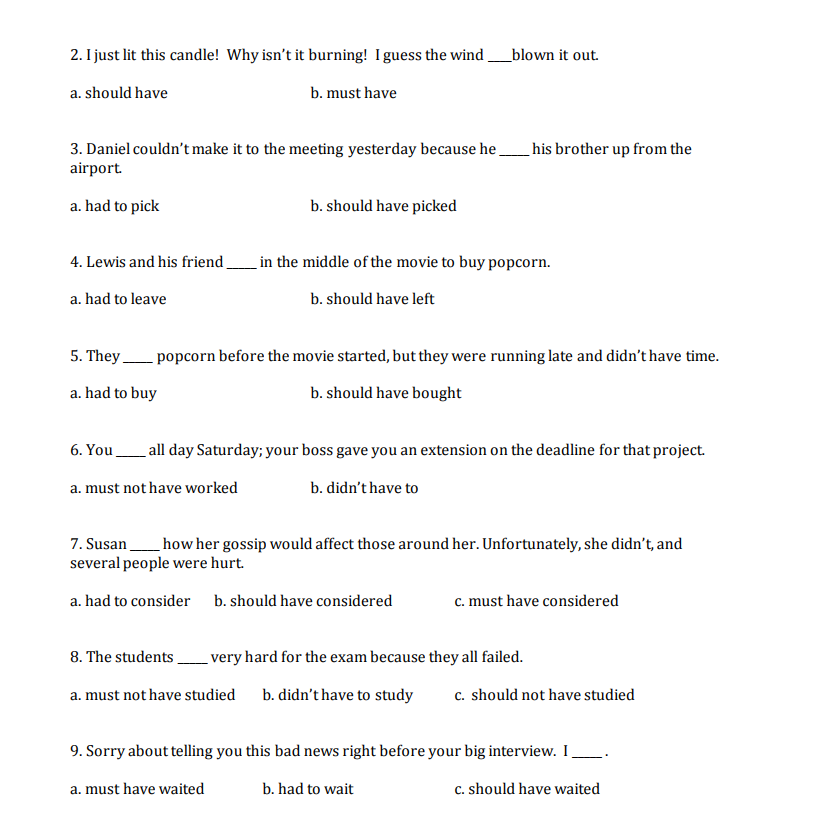
Answer key
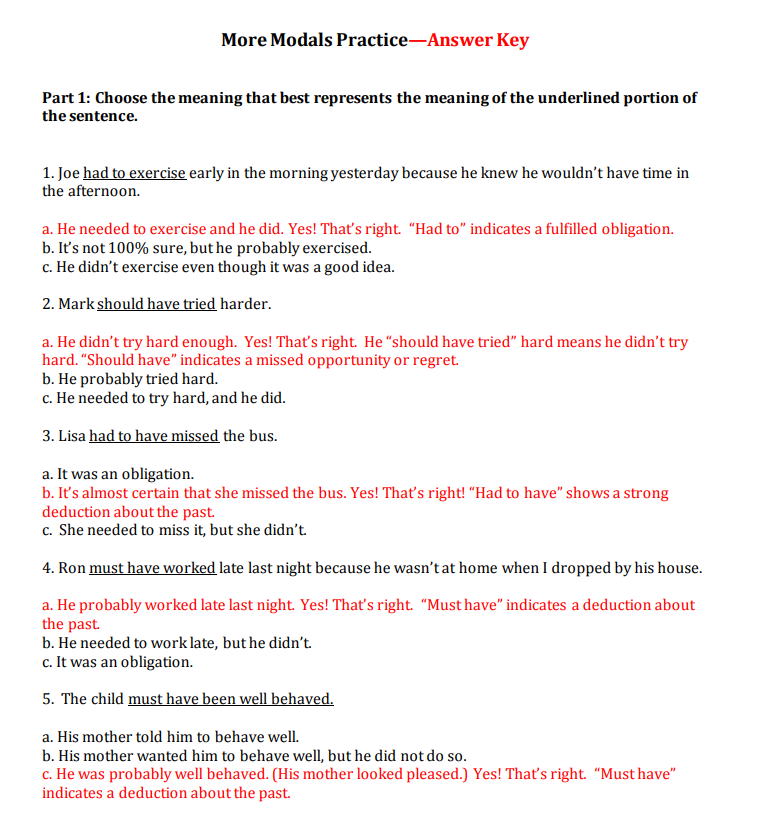
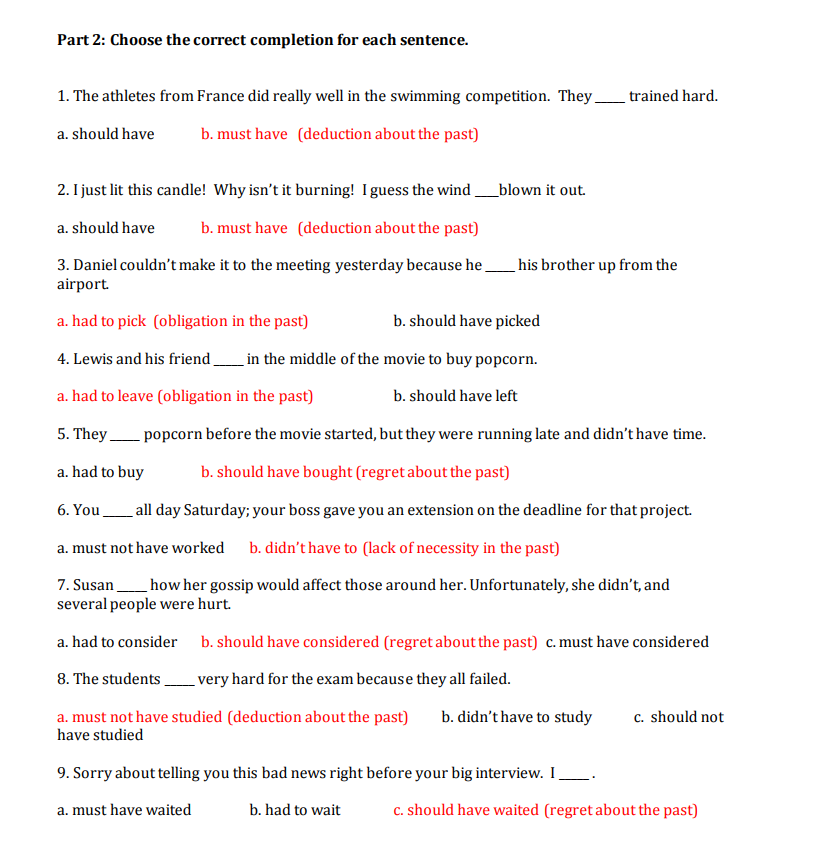
Passive Verbs Lecture
Passives. To help us talk about the grammar, let’s watch a quick video in
which I steal Emily’s muffin. >> What was that?
[INAUDIBLE] What happened to my muffin? >> Your muffin was stolen. >> There’s my muffin. How did you get there? What? What happened to my muffin? >> A bite was taken out of your muffin. Your muffin was eaten. >> Yep, by you.
What happened? I stole the muffin. I took a bite of the muffin. I ate the whole muffin. In these sentences the subject is
the person who is doing the action. We will call this the doer,
the person doing the action. And the object which is after
the verb is receiving the action. This is called active voice. I am the doer. The muffin is the receiver of my action. But in the video you heard
me say it differently. The muffin was stolen. A bite was taken. The whole muffin was eaten. This is the passive voice In
passive voice the noun that is receiving the action moves to the subject
position at the beginning of the sentence.
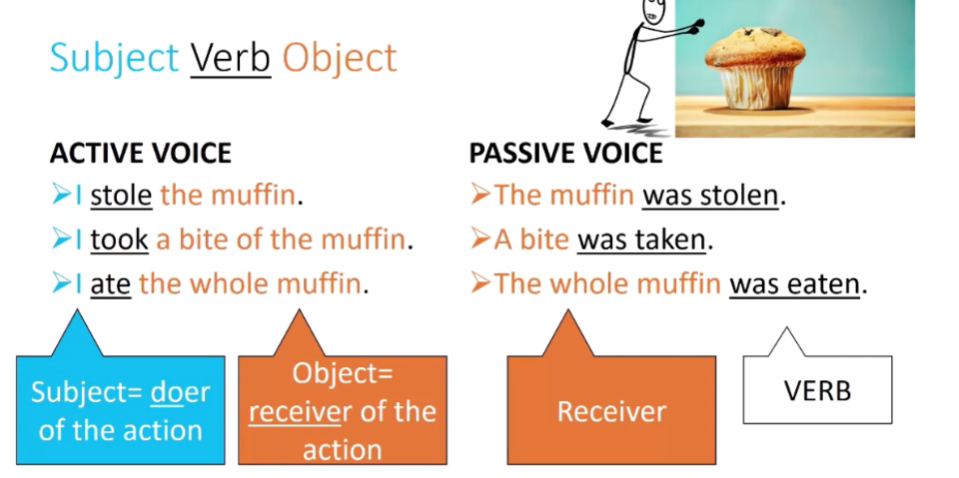
Jake ate the muffin. This is active. The muffin was eaten by Jake. This is passive. Here is the doer. Jake that’s me, I’m Jake. We switch the doer and the receiver. Now, let’s look at the verb. Notice that now there are two words for
the verb, instead of just one. Now we have was. Which is a form of the be verb and eaten the past participle,
which I will call PP. Was is the past tense form of be, because the original sentence, Jake ate
the muffin, was in simple past tense. You can follow these three steps to
change a sentence into passive voice. One, move the receiver
to subject position. Two, add be and the past participle. Three, you might add by and the doer.

Try to change these
sentences to passive voice. Start with the object or
the receiver of the action. Move it to the subject position. Add the past tense of the be verb and
the past participle. That’s it. We can end the sentence here without
saying who did the action or we can add this by phrase. The muffin was stolen by me. You need to use the object pronoun
instead of the subject pronoun. Or by Jake, if you’re the one speaking. You can imagine why I don’t
want you to mention my name. Passive voice is useful if we
don’t know who did the action, or if we don’t want to say
who did the action. Pause the video and try to answer the next
one before I give you the answer. Jake took a bite of the muffin. A bite of the muffin was taken by Jake,
or by her.
We can only use the passive for
certain types of verbs. Look at this sentence. Something strange happened. Can we change this into passive voice? No, there is no object after the verb. This is called an intransitive
verb because there is no object. Here are some other examples,
I slept well last night. I lived there for a year. We can only use the passive
voice if the verb is transitive. The child broke the lamp. Thomas Edison invented the light bulb. Someone robbed the bank. These verbs have objects. Pause the video for a moment and try to
change these sentences into passive voice. The child broke the lamp. The lamp was broken. Thomas Edison invented the lightbulb. The lightbulb was invented
by Thomas Edison. Someone robbed the bank. The bank was robbed. What about plural nouns? The child broke two lamps. Or Thomas Edison invented many things. In the passive, the be verb must agree
with the noun that is in subject position. Two lamps were broken. Many things were invented. What about I taught you? The passive is, you were taught. Be agrees with you. Remember, the active and
the passive have the same meaning. They are just different ways
of saying the same thing.
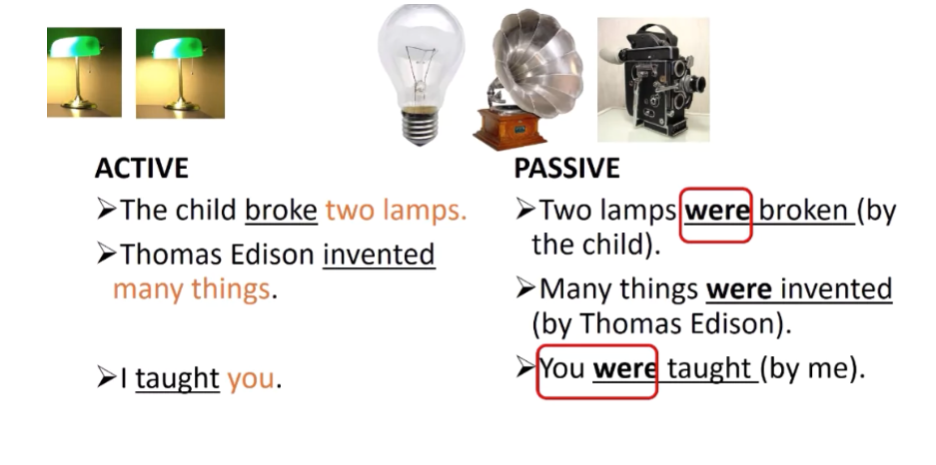
Here we can see three good
reasons to use passive voice. We have already talked
about the first one. When we don’t want someone
to know who did the action. In the second example,
we are changing the focus. The person is not important, the invention
in this case the label is more important. And finally,
if we don’t know who did the action. Now let’s see if you can do the reverse. Here’s a passive sentence. Passive voice was talked about today. Who did the action? I did.
Do you remember my name? What’s the active sentence? Jake talked about passive voice today. This video was watched by you. Who did the action? You did. You watched this video. Thank you for watching this lesson.
Passive Verbs Quiz
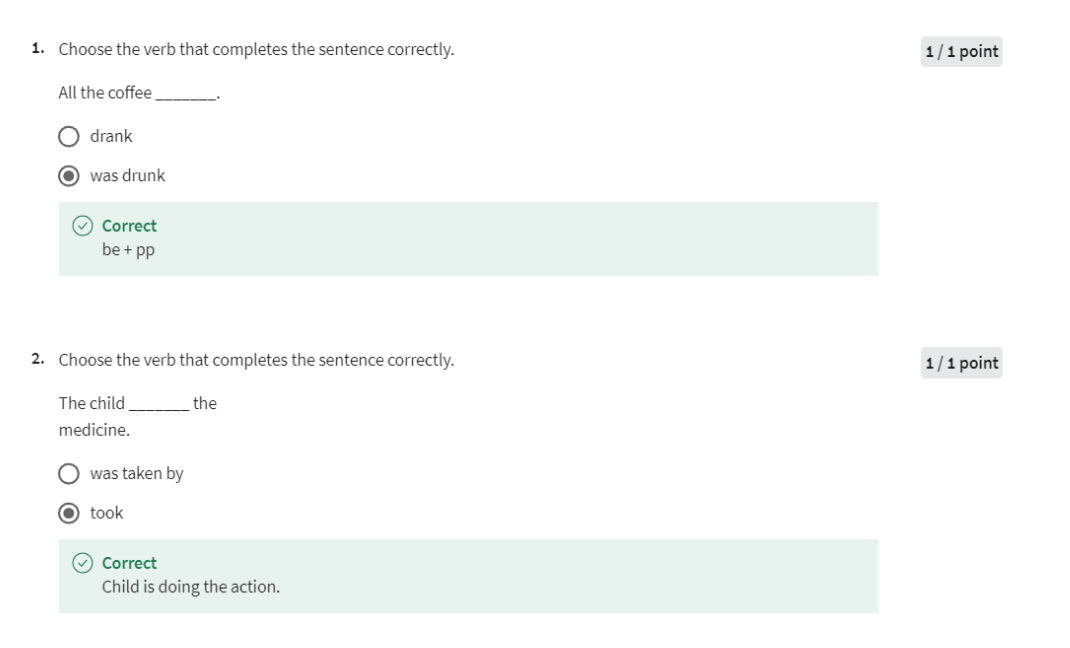
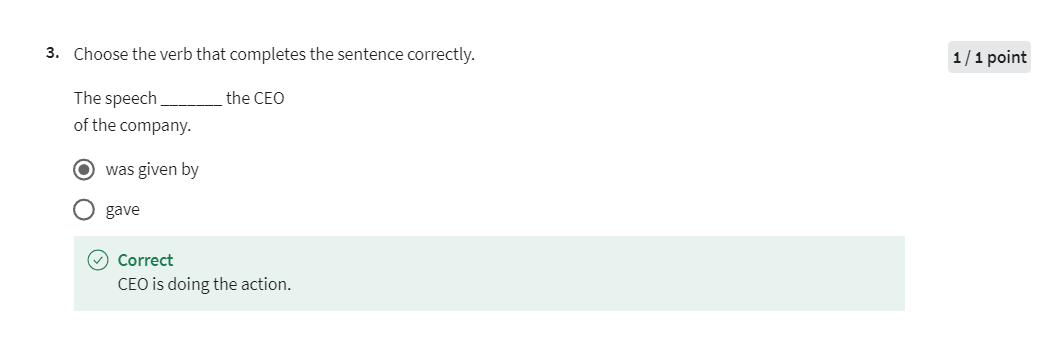
Passive Voice Practice
Practice
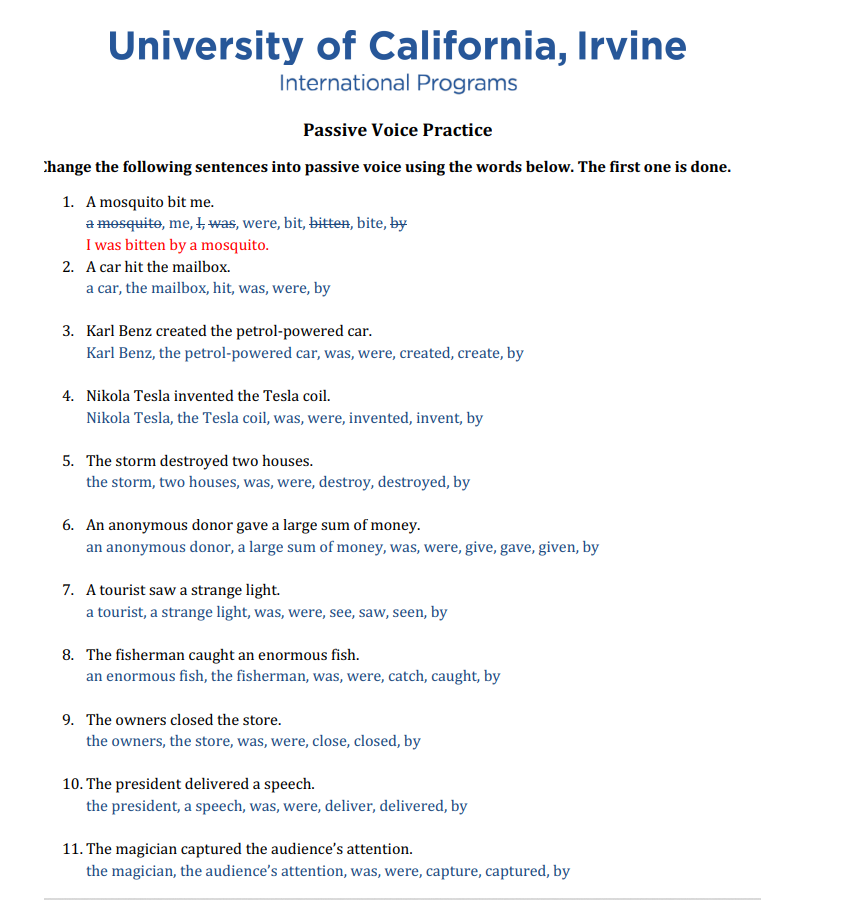

Practice key
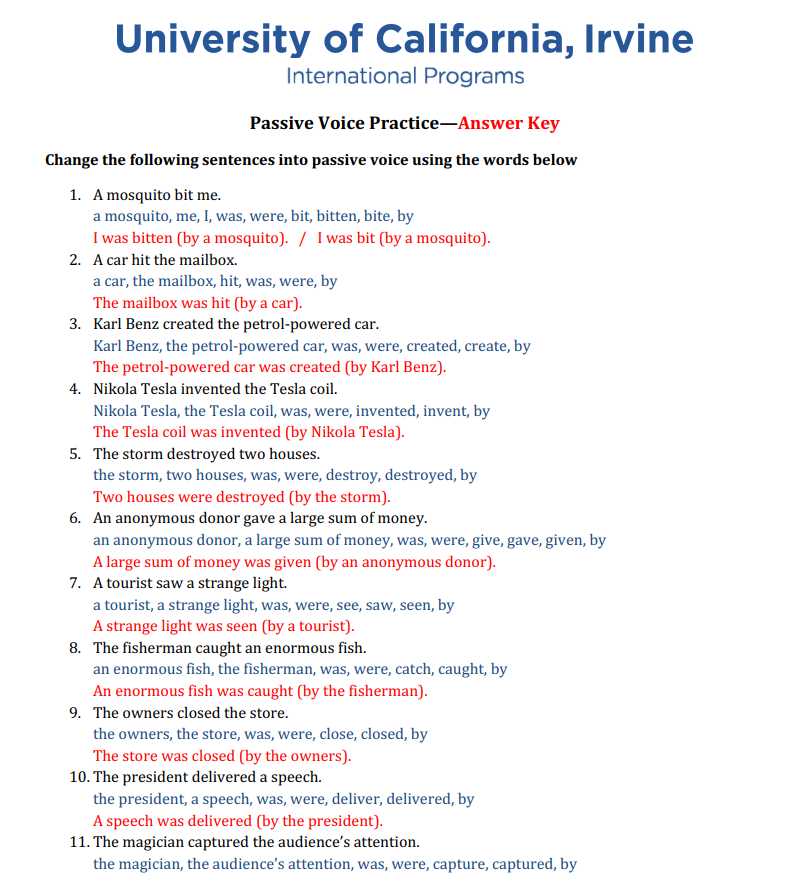
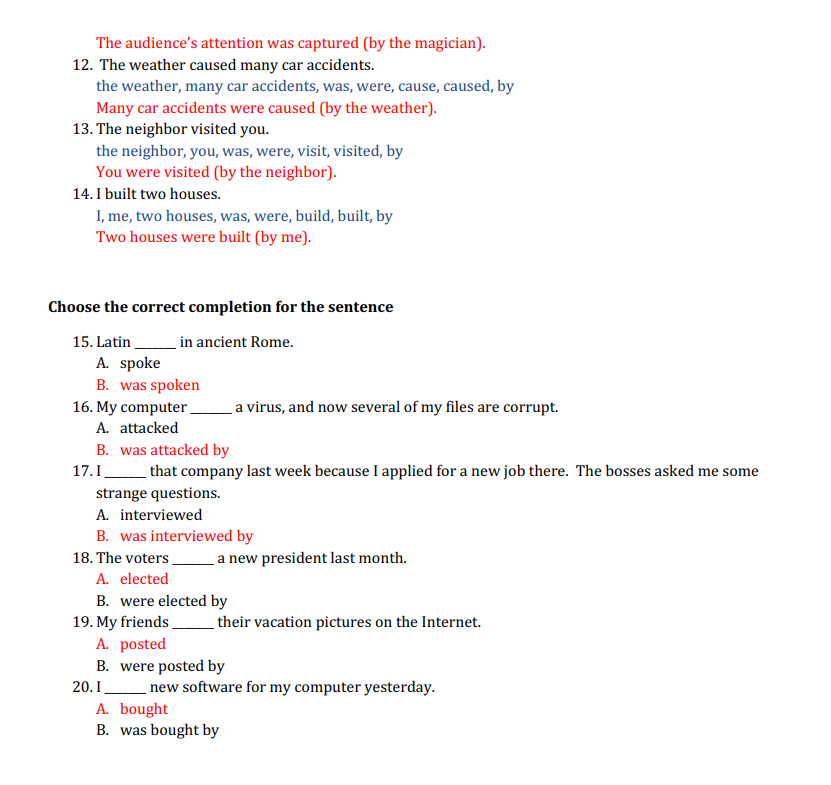
Graded Assignment: Modals and Passives Assignment
You will get a chance now to demonstrate your ability to use modals and passives correctly. You will choose one topic below to write a paragraph on that uses modals, such as should have, might have, couldn’t have, or had to, and passives, such as were eaten or has been given, correctly. You will need to be creative so that you can use a variety of modals and passive verbs. You must include at least 5 modals to talk about the past and 5 passive verbs in correct form (If you use a passive modal, count it as a passive**.). They also must be used in correct situations.** You will type the paragraph here for grading. Italicize your modals and passives so they are easy to see.
Topics:
- Your biggest mistake
- A crime that happened in your hometown
- The most important thing you have learned in life
- A workplace disaster you have witnessed
Please keep your paragraphs in good taste. Avoid potentially offensive topics. The point of the topics is to practice grammar.
My try
A workplace disaster I have witnessed:
During my time working at the factory, there had to be strict safety protocols in place to prevent accidents. Unfortunately, one day, those protocols were not followed, and a major disaster could have been prevented. The machinery should have been regularly maintained, but it was neglected for months. As a result, a critical part might have been damaged, leading to a malfunction. The warning signs had been ignored, and when the machine finally broke down, chaos ensued. Emergency procedures had to be implemented, and the entire production line had to be shut down. It was a wake-up call for everyone involved. Lessons had to be learned from this incident, and changes had to be made to ensure that such a disaster would not happen again.
Graded Quiz
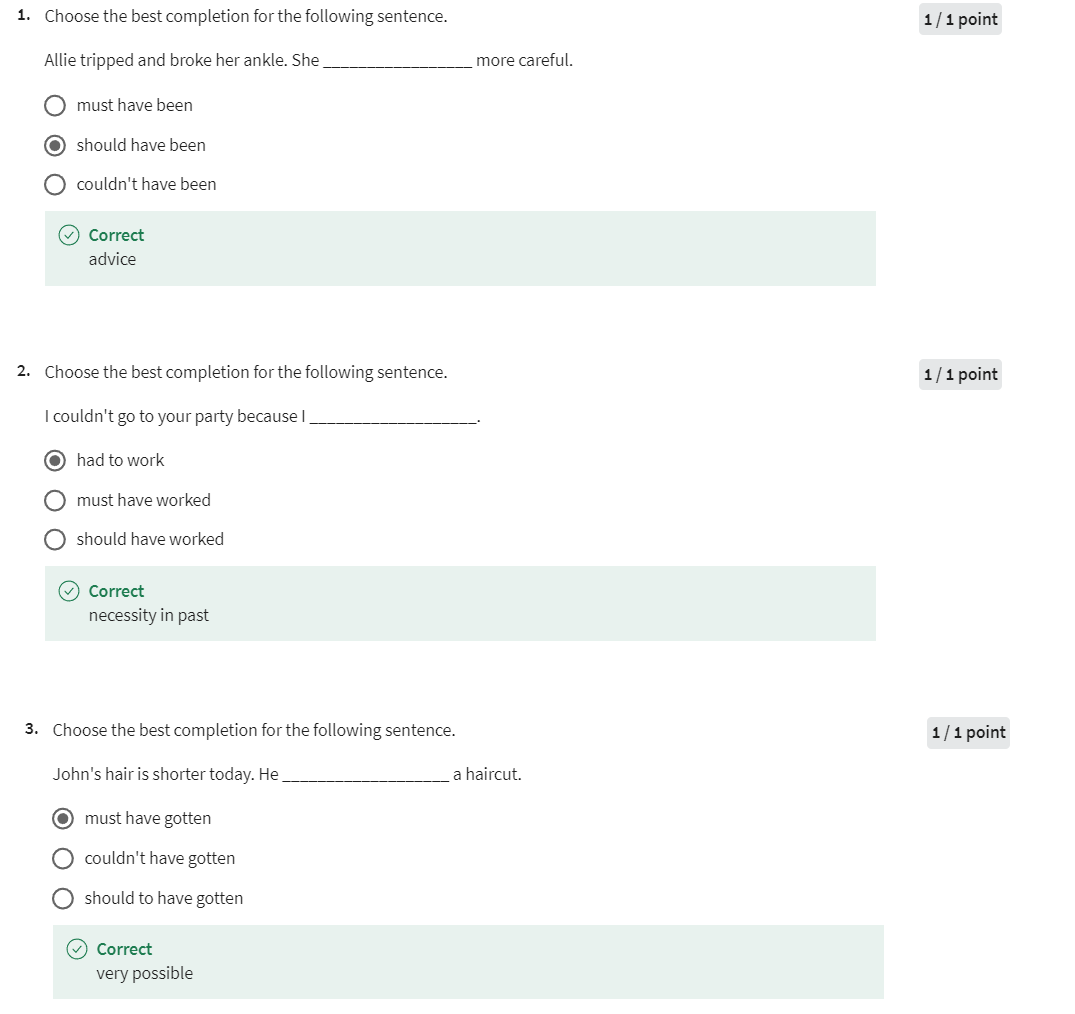
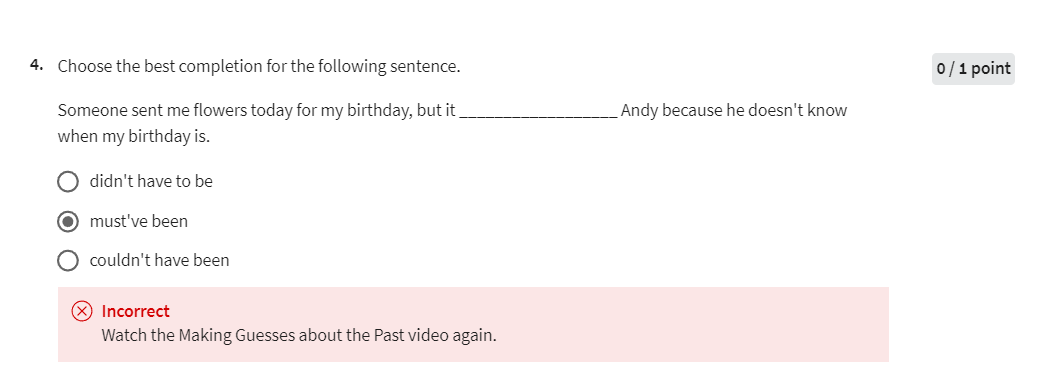
第四题选couldn’t have been

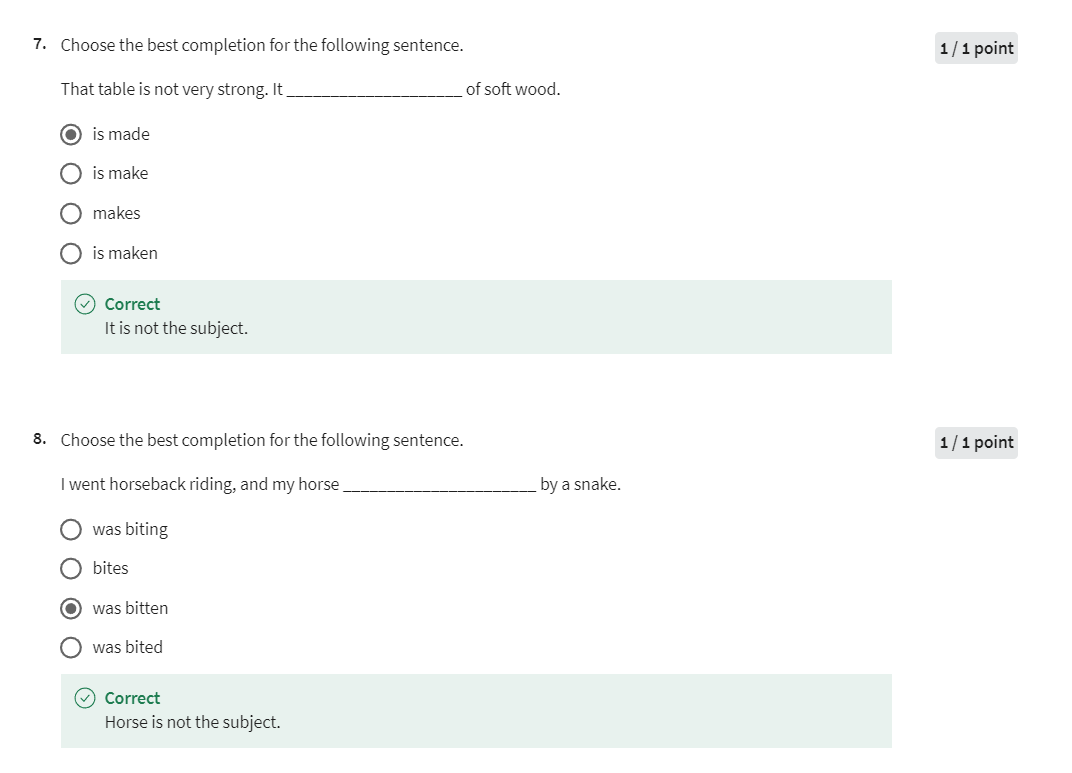
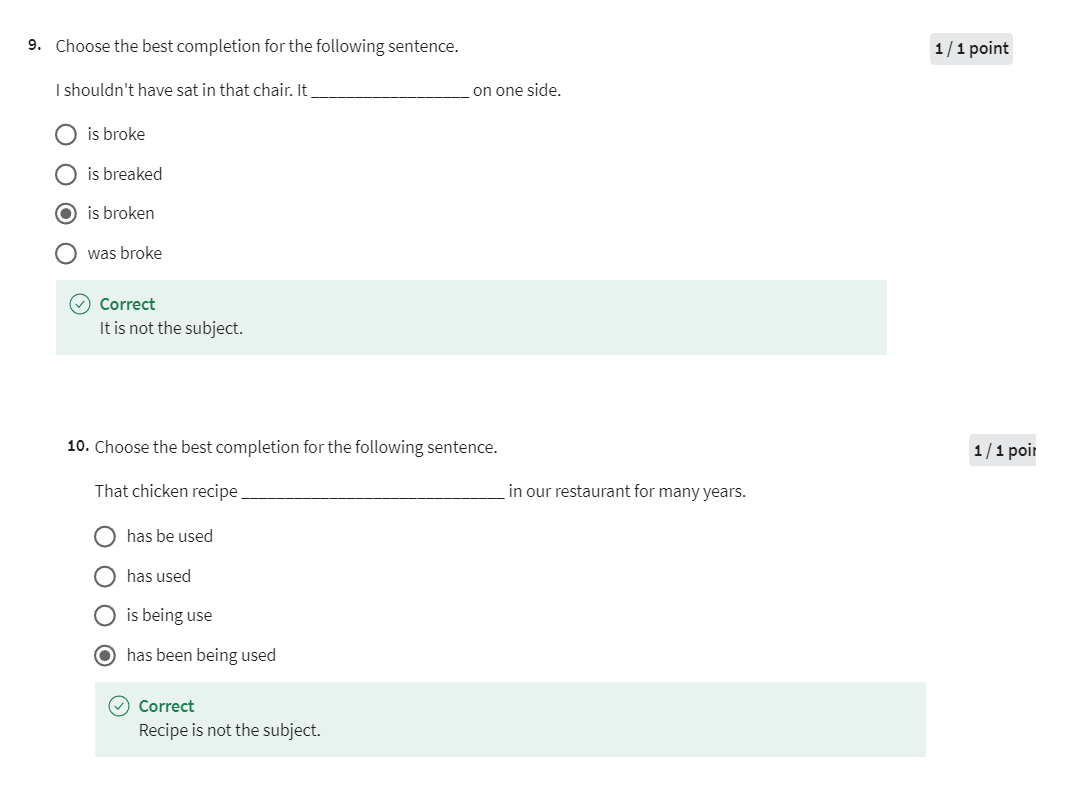
Week 04: Blending Tenses
In the final week of the course, you’ll learn about one of the most difficult but necessary aspects of verb tenses. You will learn how to blend or mix them to talk about the past, present, and future naturally. Learning to do this will help you become a more fluent speaker and writer of English.
Learning Objectives
- • use future tense correctly in complex sentences
- • avoid common mistakes when blending tenses to talk about the future
- • identify key words in sentences to determine which tenses to use
- • blend tenses when appropriate
- • explain the differences between simple past and present perfect
- • blend tenses to talk about the past
- • use most verb tenses correctly most of the time
Future Time Clauses Lecture
Future Time Clauses. Take a look at these three sentences. When I got to my office, I ate a bagel. When I get to my office, I eat a bagel. When I get to my office,
I’m going to eat a bagel. Now, can you place these words in
the correct sentence in the blank spaces after office? In the first sentence,
we should say, yesterday. You know this because we
have two past tense verbs. In the second sentence,
we should use every day. You know this because we have two simple, present tense verbs,
which indicate a habit. Finally, in the last sentence, we should
use tomorrow because we have the future tense here and wait a minute,
this isn’t future tense. This will be the focus of our lesson
today, this is a time clause. It starts with a conjunction
that indicates time. In a time clause that expresses
the future, we cannot use future tense.
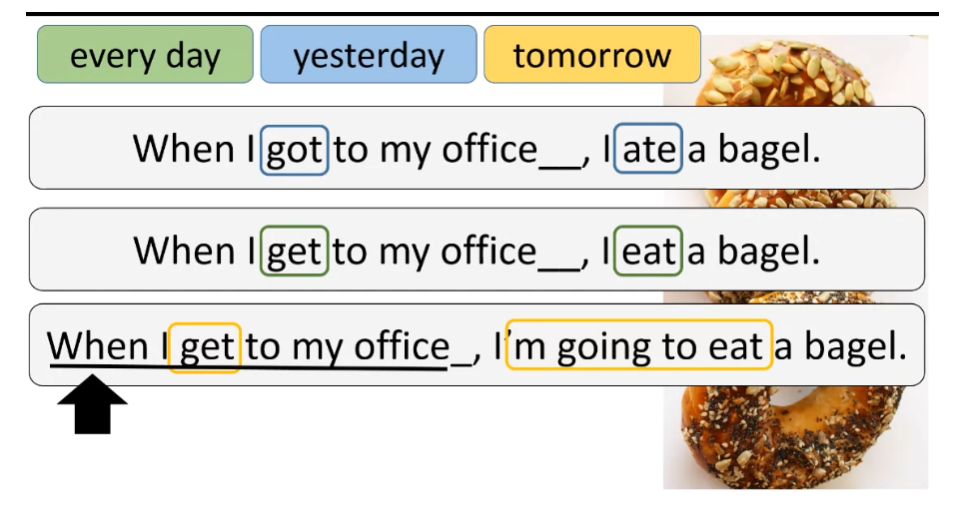
Let’s watch a quick video where Emily and
I talk about a future event. [SOUND]
Hey! >> Hey,
it’s the day we’ve been waiting for! >> Bagel Day! >> I love free food. And stealing food, too. >> You know I can’t be
mad at you on Bagel Day. >> What’s this? >> What? A text from Tammy. You’d better hurry, there is only
one bagel left in the office. >> That bagel is mine. When I get to the office I’m
going to take that bagel before you. >> Not if I get there first. When you get to the office,
I’ll already be eating that bagel. >> I don’t think so. By the time you get to the office,
I will have already destroyed that bagel! I’m out of here. >> Listen again to the first
time clause that we heard. You will see the words on the screen. Try to identify the tense
that is underlined. >> That bagel is mine. When I get to the office I’m going
to take that bagel before you. >> This is simple future tense. [NOISE]
Mine. >> Now, try identify this next tense. >> Not if I get there first. When you get to the office,
I’ll already be eating that bagel. >> This is future progressive tense. >> What? >> [SOUND] And finally. >> I don’t think so. By the time you get to the office,
I will have already destroyed that bagel! >> This is future perfect tense. >> Mm, that was a good bagel. [LAUGH] Gone.
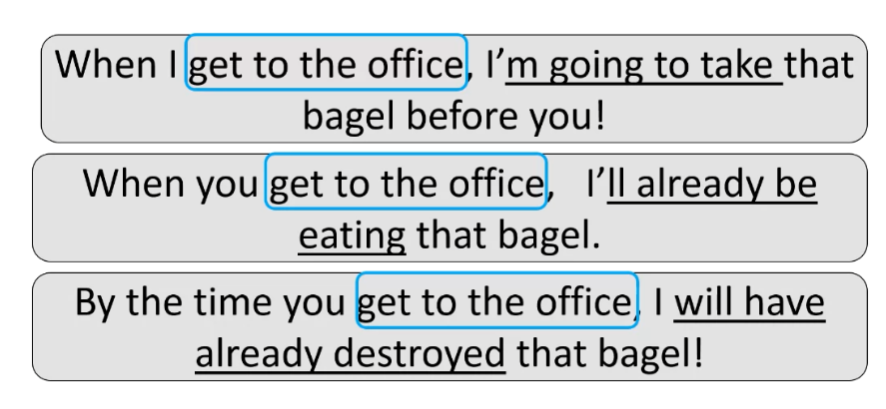
Here are the three
sentences that we just heard. Now focus on the first clause,
the time clause. Notice that the verbs here
are all identical, and they are all in simple present tense. All of our actions will
occur in the future. We will both get to the office, but in
this situation, Emily will arrive first. Then she will take the bagel
right when I get there. Even though these are both in the future, we cannot use the future
tense in the time clause. Use present tense. Here, in the future progressive,
first I’ll arrive and I will start eating. She will arrive and interrupt my eating. We still use simple present
in the time clause. And in the final scenario, the action of
eating will be finished before I arrive. Everything is in the future but the verb
and the time clause remains the same.
By now, you should be able to tell
me what’s wrong with this sentence. We can not use future tense,
because this is a time clause. The correct sentence is when I finish this
course, I will start the next course.
Here are some words that we can
use to start a time clause. You should be aware that this
is not an exhaustive list. Here’s another example in the future. Emily and I will be friends again by
the time we leave the office today. This time, the time clause comes
after the independent clause. The time clause can come first or
second, it doesn’t matter. Just remember to never use
the future in a time clause. Take a look at these two sentences. My brother will graduate next year. Before that, I will start a new job. Let’s combine these using a time clause. By the time my brother graduates,
I will have started a new job. Don’t forget that the verb
must agree with the subject. So, in simple present tense,
we need to add s to the verb graduate for a third person singular subject.
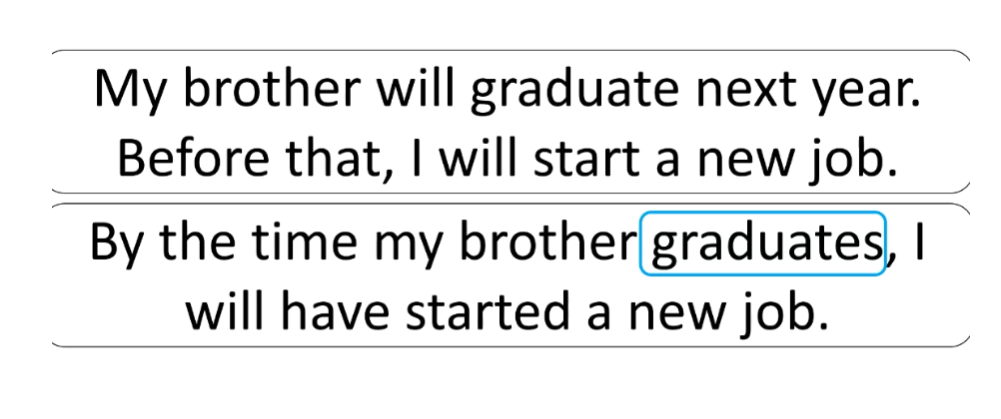
Here’s another example. Both of these verbs are in
future progressive. Tomorrow at 10:00AM, I will be working. My brother will be sleeping. If we combine these with a time clause, just get rid of will but
keep the progressive aspect. Just use present progressive. While my brother is sleeping,
I will be working. Let’s try one more. Tomorrow at 10:30 AM,
I will have been working for an hour. My brother will have been sleeping for
an hour. It would be very uncommon to hear
this phrase since this verb tense, a future perfect progressive,
is rarely used but let’s give it a try. Just get rid of the future aspect. Our new sentence is,
when I have been working for an hour, my brother will have been sleeping for
an hour.
Future Time Clauses Practice Quiz
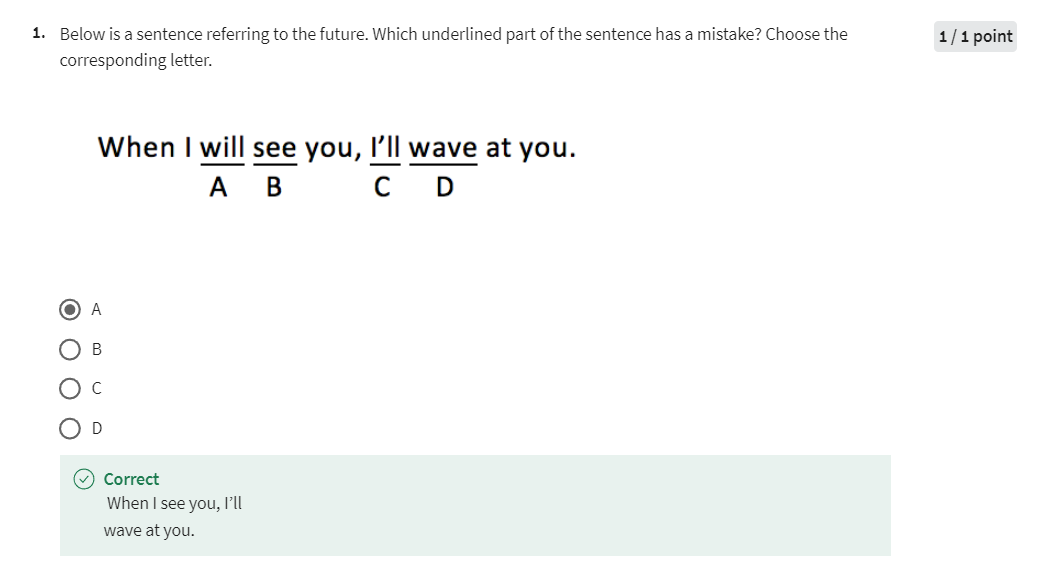
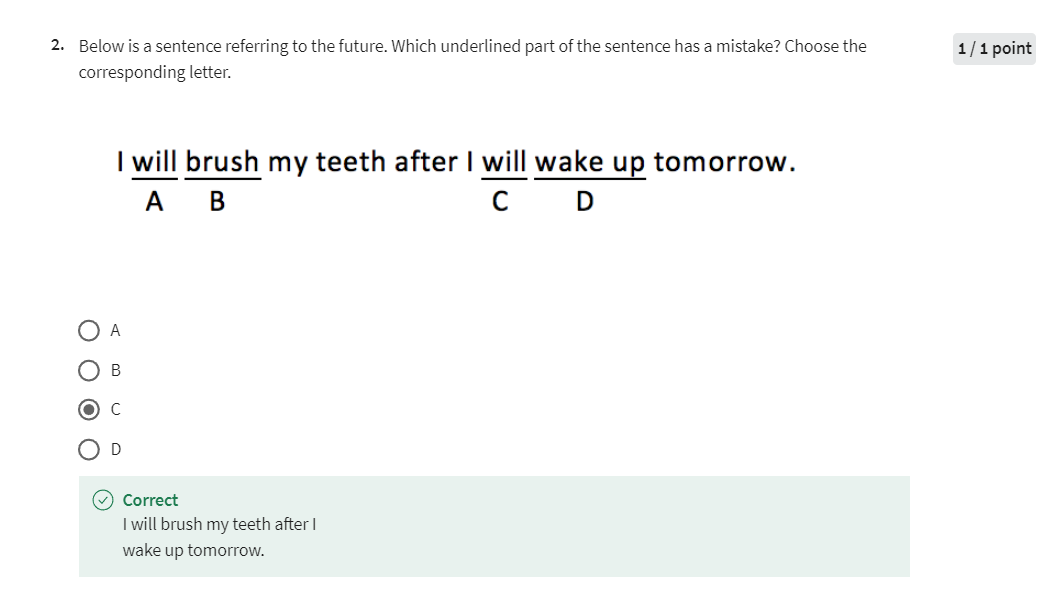

Future Time Clauses Practice
Practice
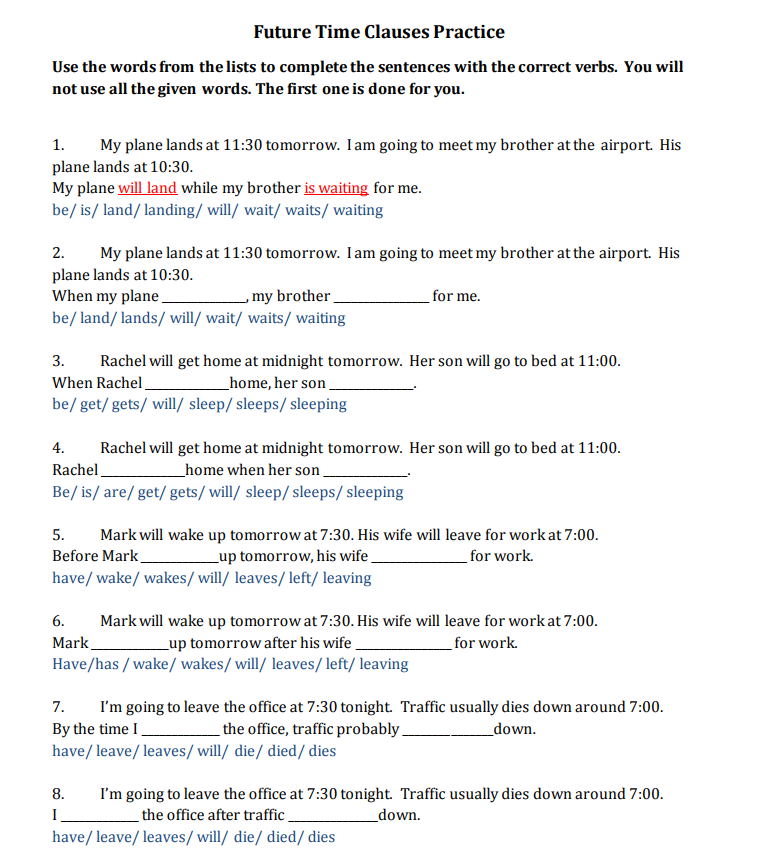
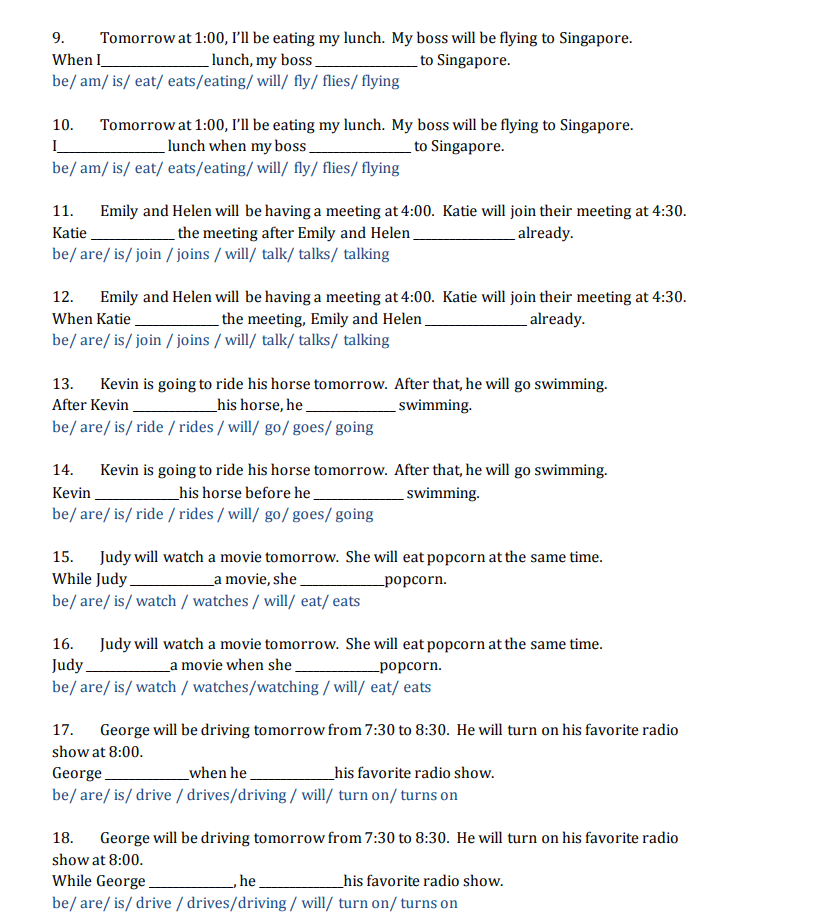
Answer key
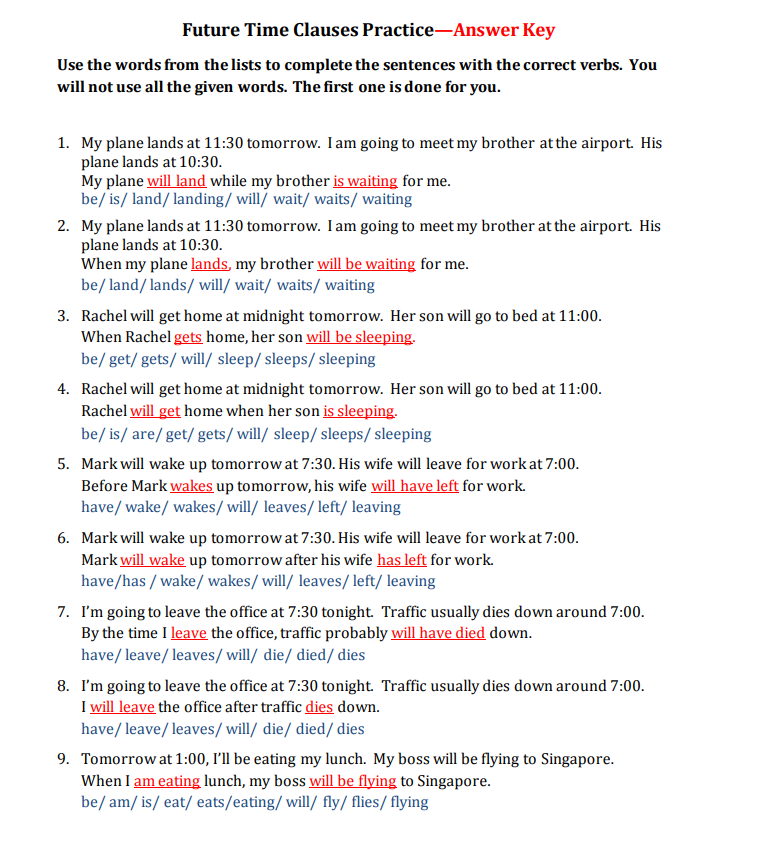
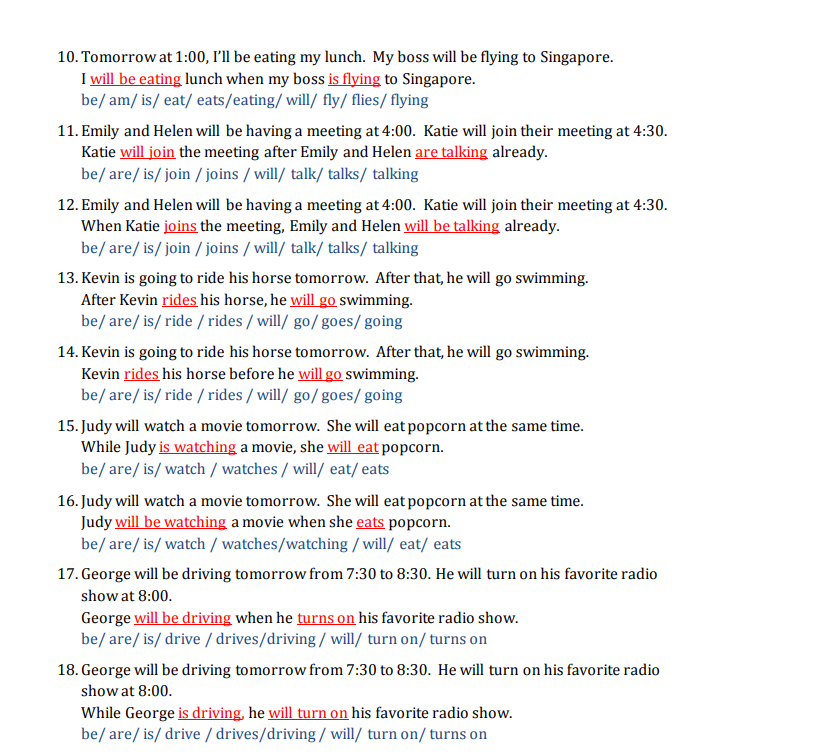
Mixed Tenses Part 1 Lecture
Mixed Tense, the Past Affects the Future. To start out,
take a look at the verbs in this sentence. My phone rang while I was sleeping. Can you identify the tenses? Ring is in the simple past and
was sleeping is the past progressive. You may remember this
from a previous lesson. You already know that it is possible
to use these in the same sentence even though they are different tenses. And this make sense because both
of these actions are in the past. You may also remember this example
where we use two different tenses with a time clause. I’ll be eating that bagel
when you get to the office. We know that both of these
actions occur in the future regardless of the fact that
we are using present tense.
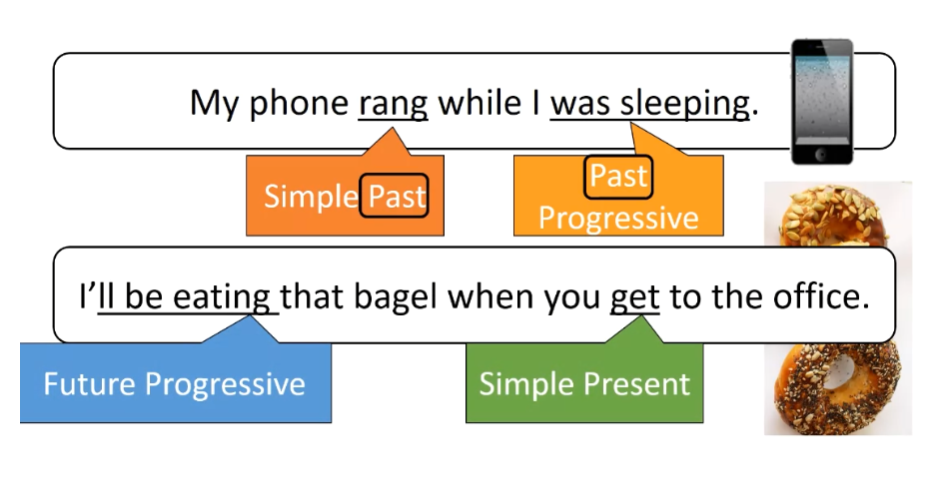
But take a look at a different example. You decided to take this course because
you want to improve your English. Notice the verb tenses in this sentence. We have past and present,
which are two completely different times. You might ask, is this possible? The answer is yes. That is because the past
affects the future. You made a decision to take
this course a few weeks ago. You wanted to improve your English then. So, you could say this, but
you also want to improve it now. Here’s another example of mixed tenses. I feel tired today because I
swam 3,000 meters yesterday. This time, we have the present
tense in the result clause, and the past tense in the clause
that tells us the cause. This is also possible. There are several different ways to mix
tenses, as we will see in this lesson.

Try to fill in the correct verb tense
in this sentence using these verbs. Emily still upset because
I her muffin last week. Can you change the verbs
to the correct tense? Maybe this timeline will help you. The correct answer is Emily is still upset because I stole her muffin last week. Because Emily feels upset now about
something that happened in the past. Try another example. I my suitcase today because
I on a trip next week. Here’s our time line. Here are the events. The correct answer is I am
packing my suitcase today because I am going to
go on a trip next week. You could also say, I am going on a trip next week,
because this is a planned event. Here we have the present progressive,
because this is today which is now, not a habit, and simple future for
something that will occur after now.
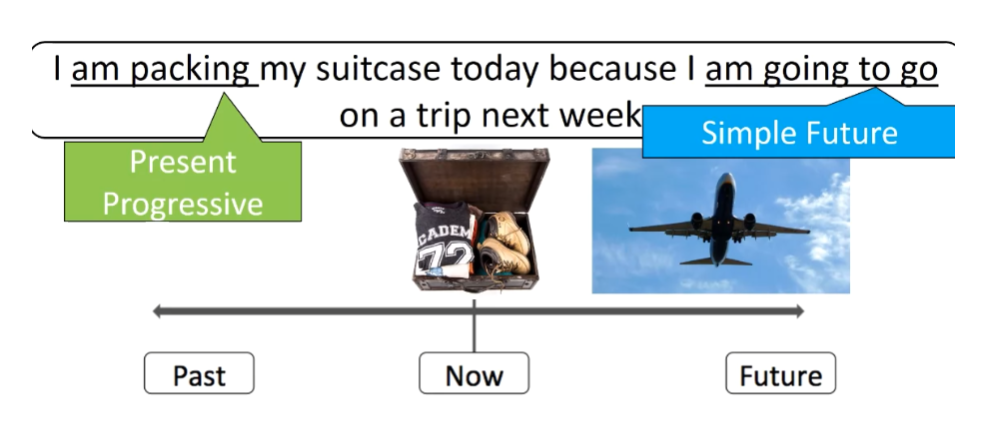
Think about the timeline for this one. Because there a hurricane tomorrow,
Sam a bunch of supplies last night. When do these events occur? The answer is because there is
going to be a hurricane tomorrow. Or we can also say, because there
will be a hurricane tomorrow, since this is a prediction
both ways are okay. Sam bought a bunch of supplies last night. The same rules apply to other cause and
effect conjunctions, or in this case even though, which expresses the opposite
of what we expect the result to be. I my car tomorrow even
though it a lot lately. First, let’s think carefully
about the second verb rain. Notice the keyword lately. This is something that started
in the past, continues now, and may continue in the future. Continue is a key word here. That means we should use present
perfect progressive tense. The first verb, wash,
is probably a bit easier. The correct answer is I’m going to wash my car tomorrow even
though it has been raining a lot lately.

In this sentence, we still have present
perfect progressive in one clause, but notice what is different
in the first clause. So, now our timeline looks like this, which means that we need to change
the verb to I washed my car yesterday.
Let’s try something a little different. I’ve given you the correct sentence
with the correct verb tenses. The wind had been blowing
before I got home, so I will rake up the leaves
in my backyard later. Now I’m going to show
you two timelines and you need to pick the correct
one that matches the sentence. Or, The second one is the correct timeline. The wind had been blowing in
the past before I came home. In addition, came is in the past, not now.
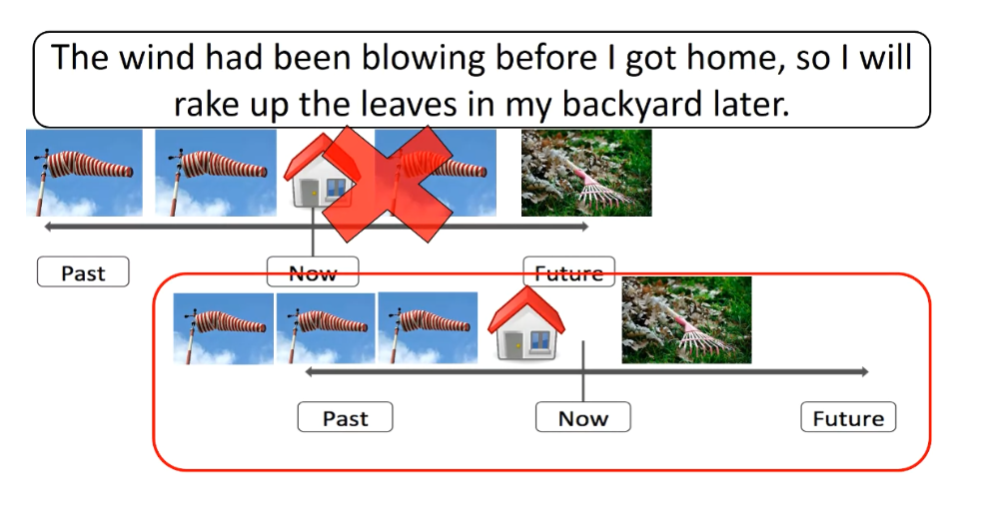
Now that I’ve exercised today,
I think I’ll eat some ice cream tonight. In this sentence, we have the conjunction
now that, which means because now. That means we use some aspect of
present tense with this phrase. Which timeline best
represents this sentence? You’ll need to decide if the action
of exercise happened in the past or if it is happening now. If you chose the first timeline,
then you are correct. Although this action happened in the past, we use present perfect because the time
period of today is not finished yet. To review, we have seen that we can mix
several tenses together, present and past or future and past, and present and future. We can even add progressive or
perfect aspects if we need to. So how do you decide which tense to use? Well, there is not necessarily one rule
that will tell you what tense to use. Just think about your timeline. It depends on when these actions happened.
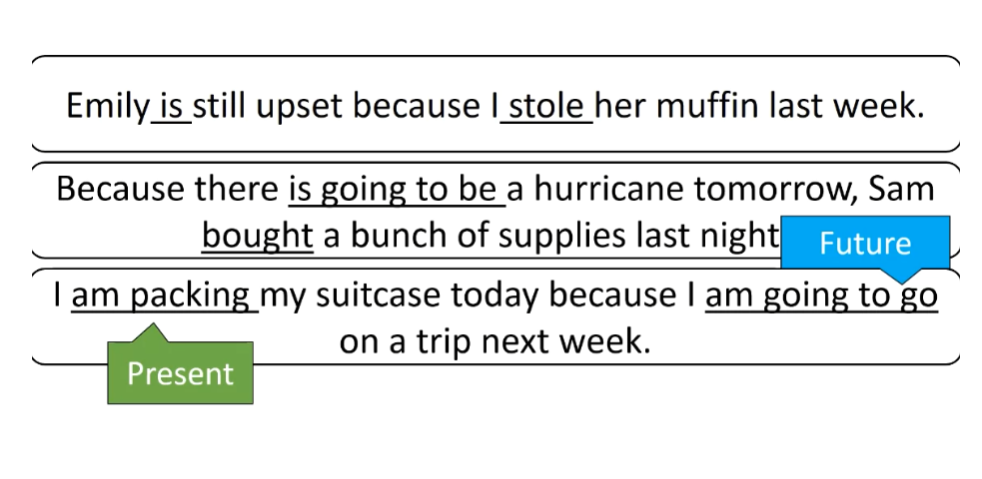
Mixed Tenses Part 1 Practice Quiz
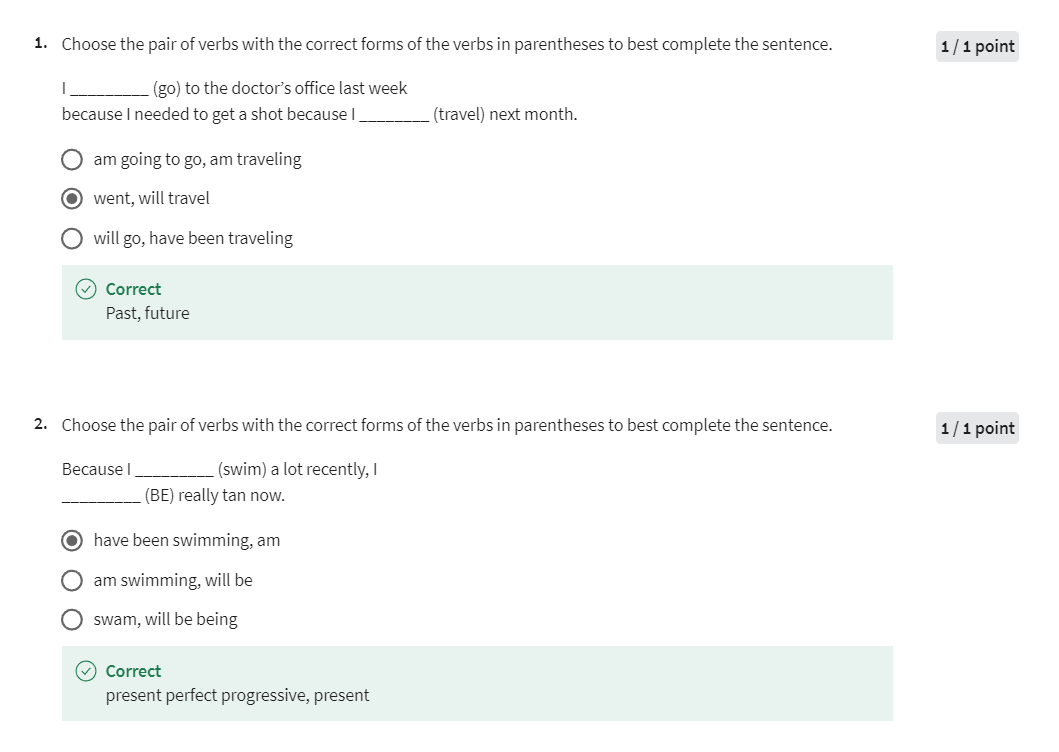
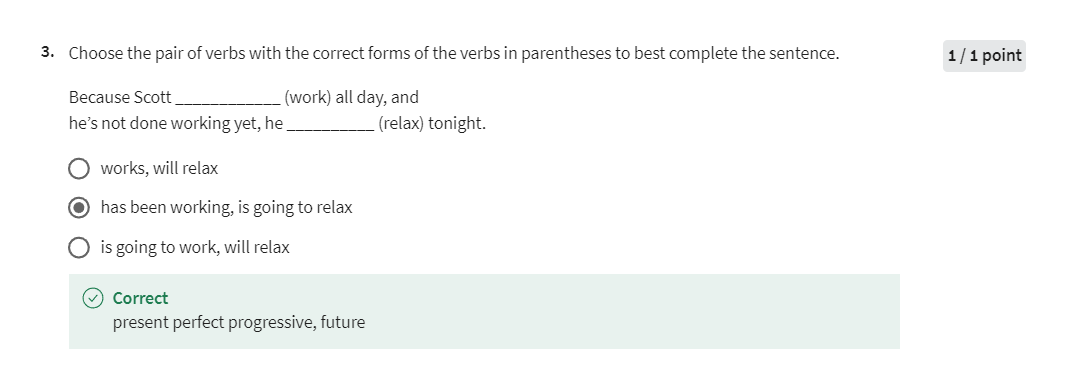
Mixed Tenses Part 1 Practice
Practice
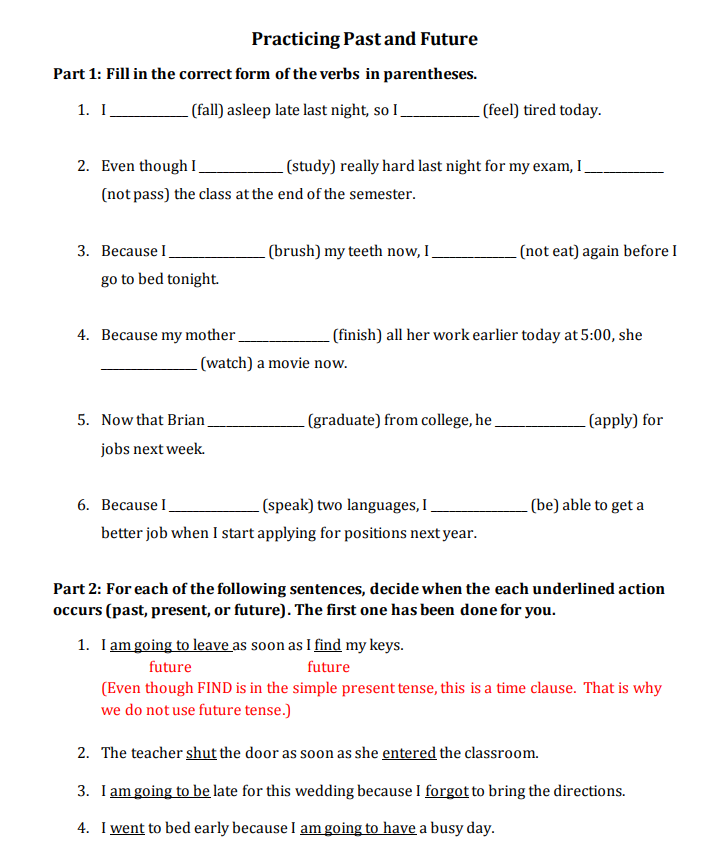
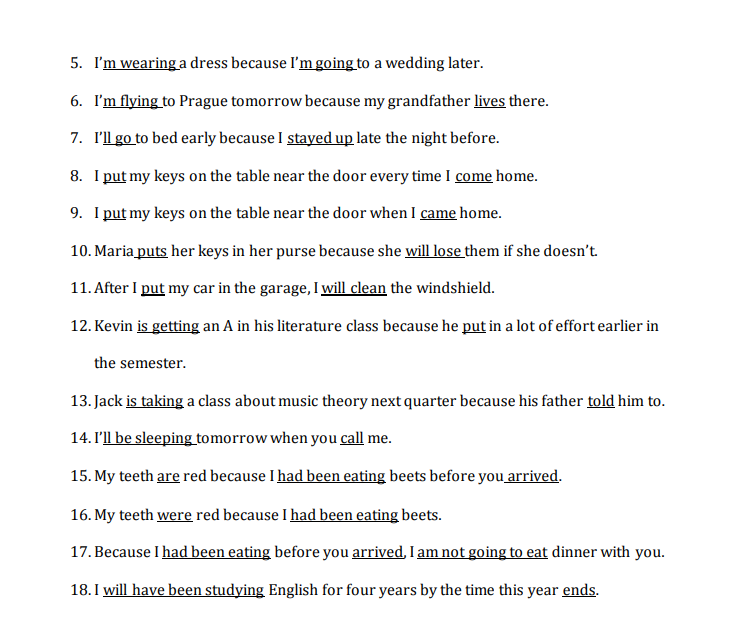
Answer key
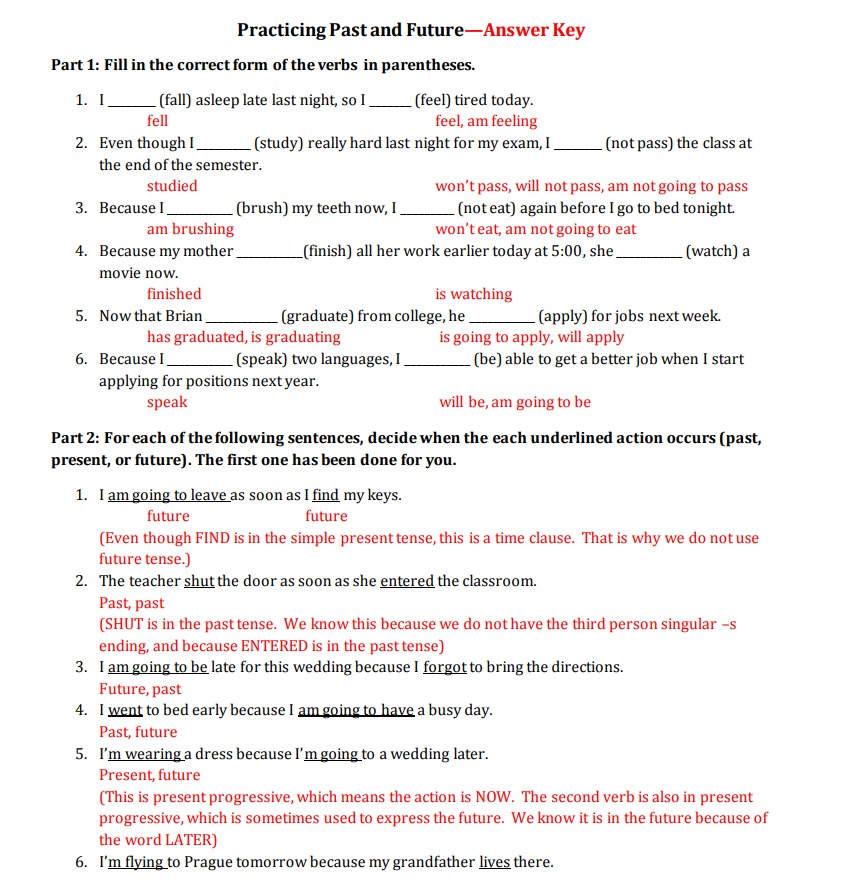
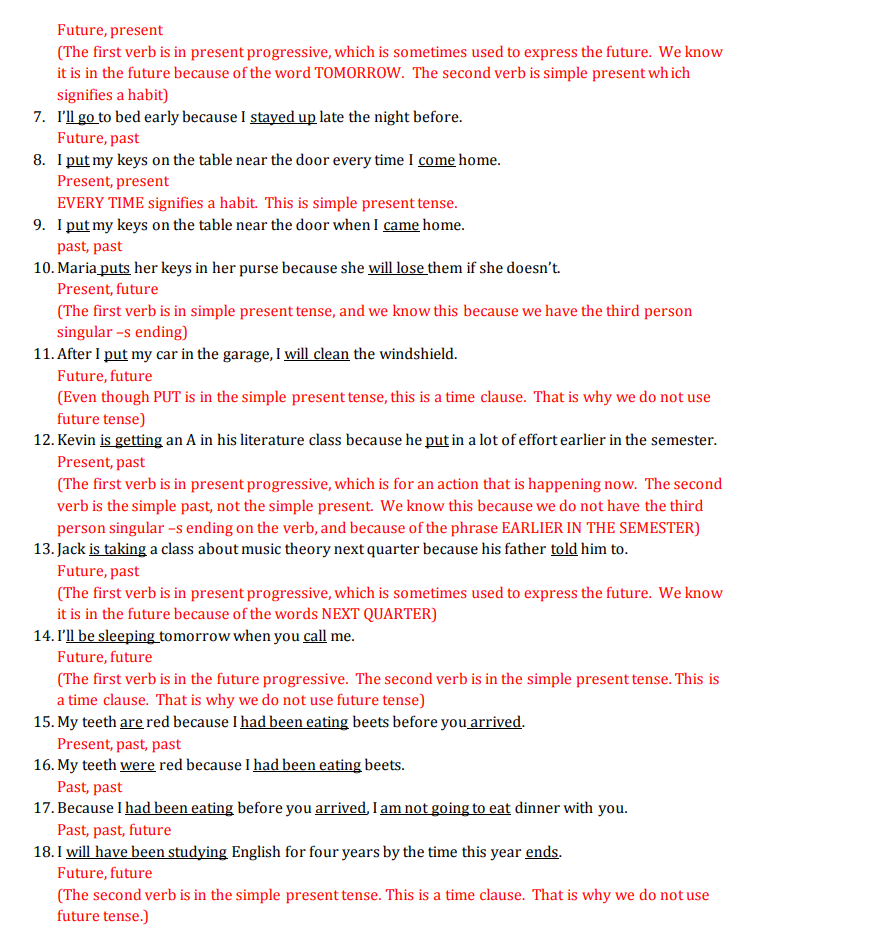
Mixed Tenses Part 2 Lecture
Present Perfect and Simple Past. I am a swimmer. This action is true right now. In fact, I have been a swimmer for
many years. I have been a swimmer
since I was 7 years old, a long time ago, but
I won’t tell you when that was. Notice we are using the present perfect
tense with have and the past participle. You probably know we are using this
because it is an action that started in the past, continues now, and
will probably continue in the future. You also know that we are using this
tense because we have the word since. You may remember that we can use
since before a year or point in time, I have been a swimmer since the 90s. But we can also use since with a clause. Remember, a clause means we
have a subject and a verb. There are two clauses in this sentence. I have been a swimmer and,
since I was 7 years old. In the clause that starts with since,
use simple past. In the independent clause,
use present perfect.
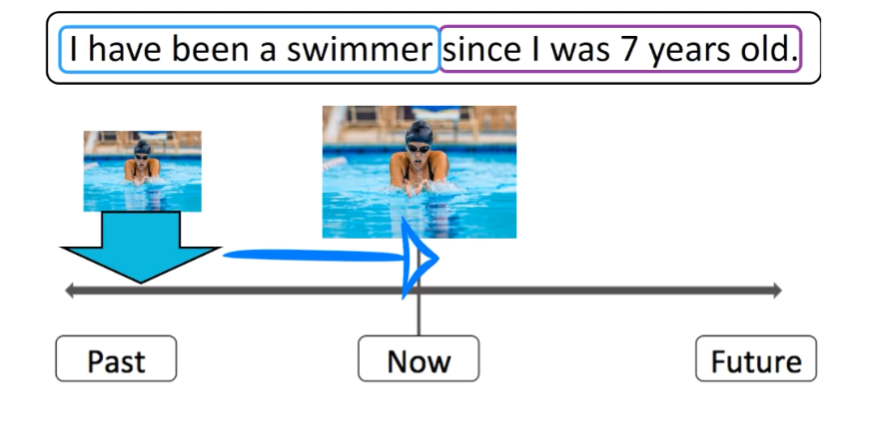
Here’s another example. Emily and I have known each other
since we started working at UCI. Have known is in the present perfect and
started is in the simple past. Now I want you to try it. Here’s our timeline, we’re looking at the past, we are going
to talk about a bad driver, John. John got his drivers license, but
look at what happened after that. Can you complete the sentence
using the verbs get and crash? Take a moment to think about it. If you said,
John has crashed his car twice ever since he got his license,
then you’re right, good job. And it is possible that
he will crash again. Notice the phrase, ever since,
it has the same meaning as since.
Watch a short video,
there’s no sound, so just watch. And then I’ll ask you to
make a sentence about it. Now use these words to form
a sentence about what happened. The verbs in grey are not in the correct
form, you will need to change them. That means you may need to add a word that
is not here to form the correct verb. Pause the video if you need to
give yourself time to think. Jake has drunk 3 cups of
tea since she sat down. Remember that we can also say the sentence
like this, since Jake sat down, she has drunk 3 cups of tea. If since comes at the beginning
of the sentence, that is to say if the dependent clause is first,
you need a comma to separate the clauses.
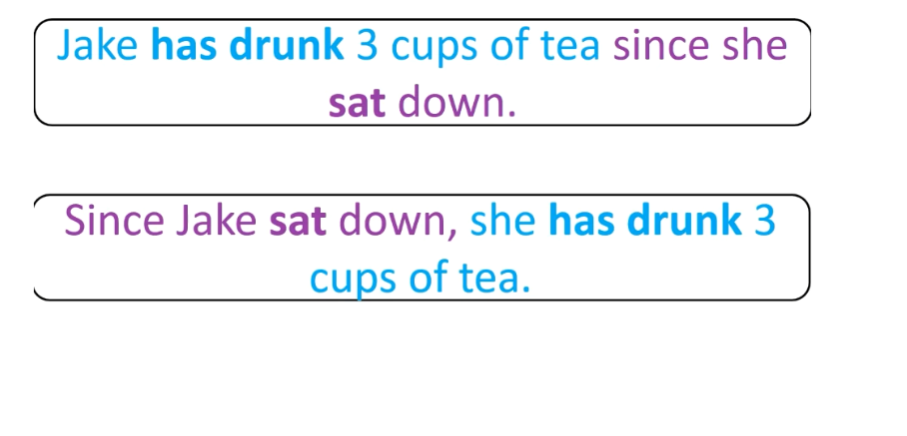
Here’s another example. Here is the day that Frank downloaded some
software onto his computer, the 22nd. But now, look at all the viruses
he has on his computer. Try making a sentence with these words, putting since at the beginning
of the sentence. Again, you will have to
change the form of the verbs. Since Frank downloaded the software,
he has gotten several viruses. Or if you’re speaking British English,
you can say has got.
As a final check, let’s see if you can
find the errors in these four sentences. I have swam since I was a child. Since the moment Emily started
learning Spanish, she has enjoyed it. Ever since I have woken up,
I’ve had a headache. I crashed twice since I got this car. You may want to pause the video
to allow yourself time to think. First, the past participle
of swim is swum. A lot of native speakers
get that one wrong, so if you got it right, then great job. Sentence two needs a comma because
the dependent clause is first. In sentence three, we must use the simple
past in the dependent clause with since. And finally, we must use the perfect tense in the independent clause when we
use since in the dependent clause. Okay, great work.
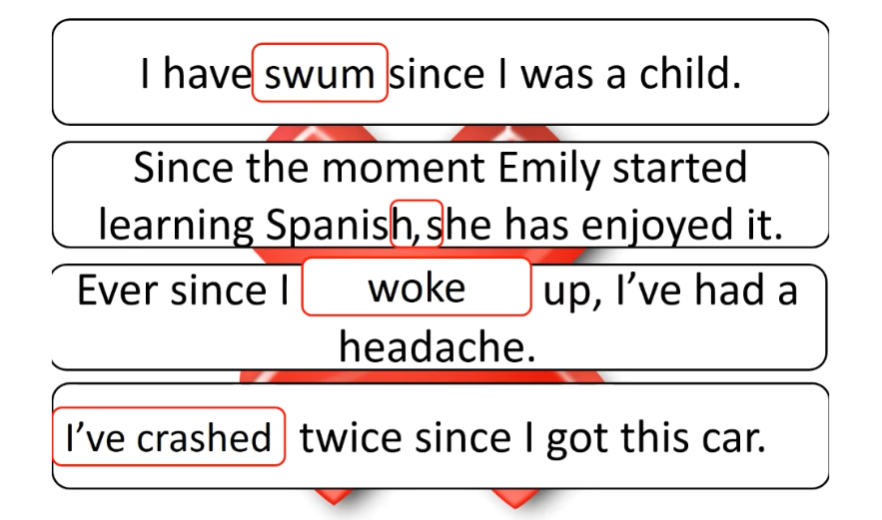
Mixed Tenses Part 2 Practice Quiz
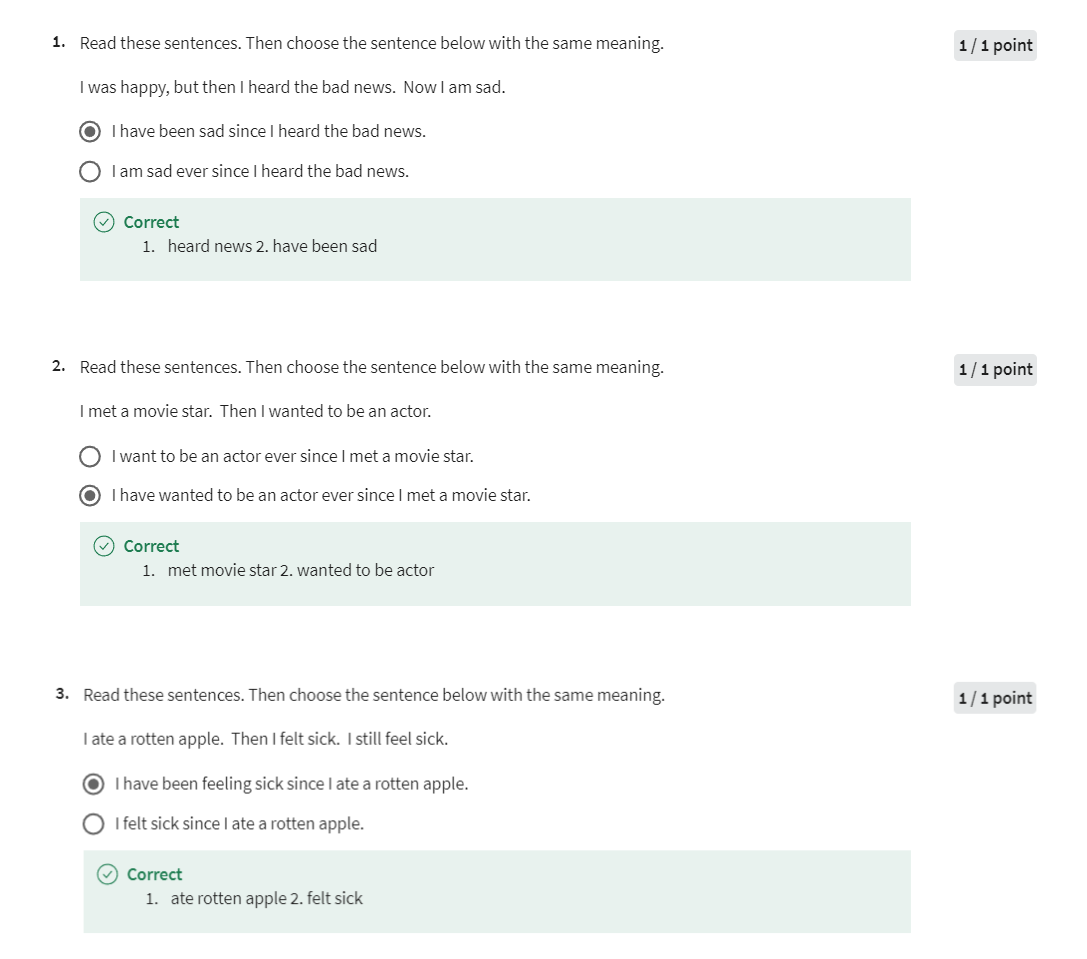
Mixed Tenses Part 2 Practice
Practice
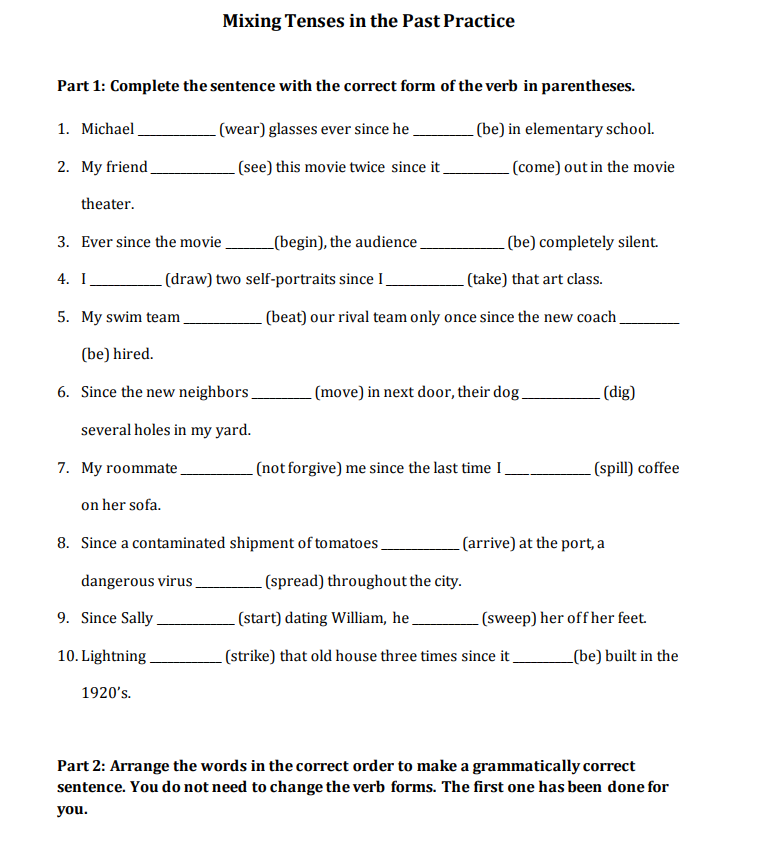
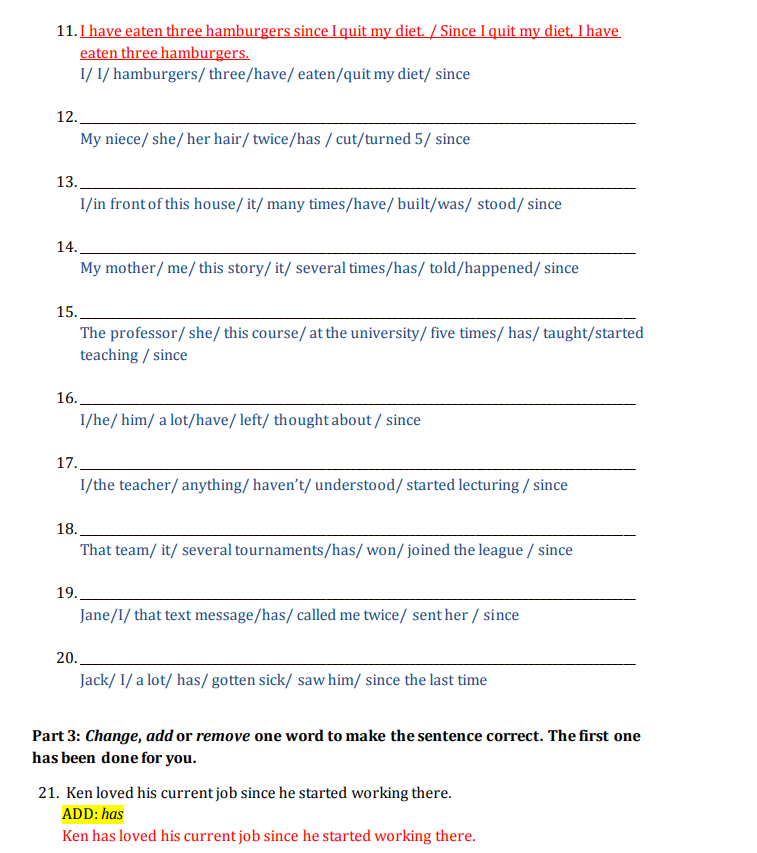
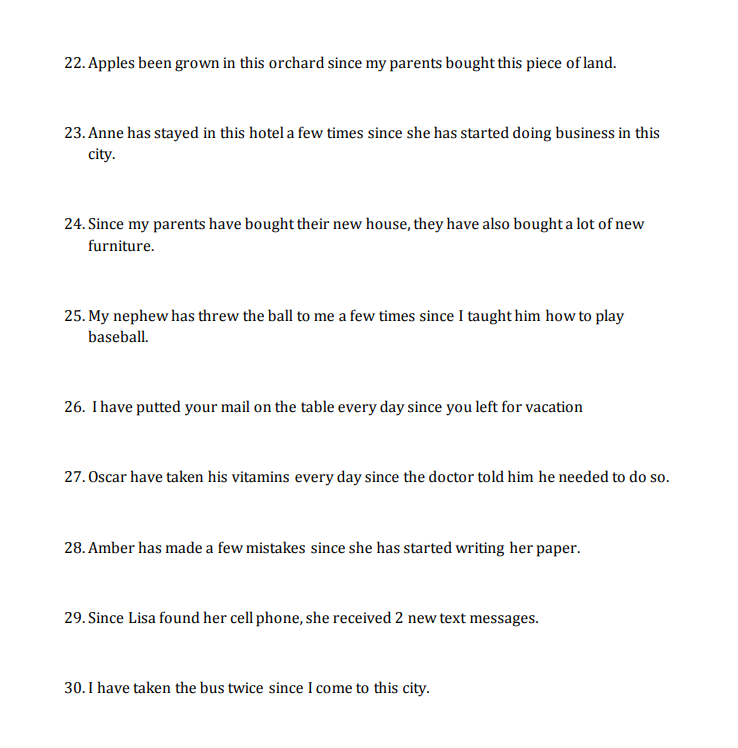
Answer key
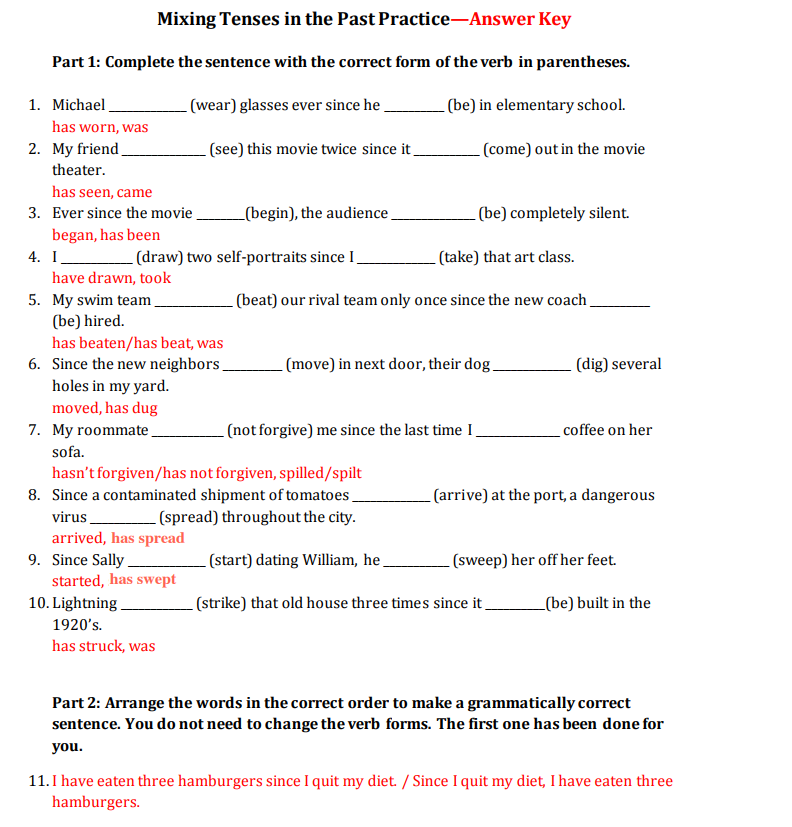
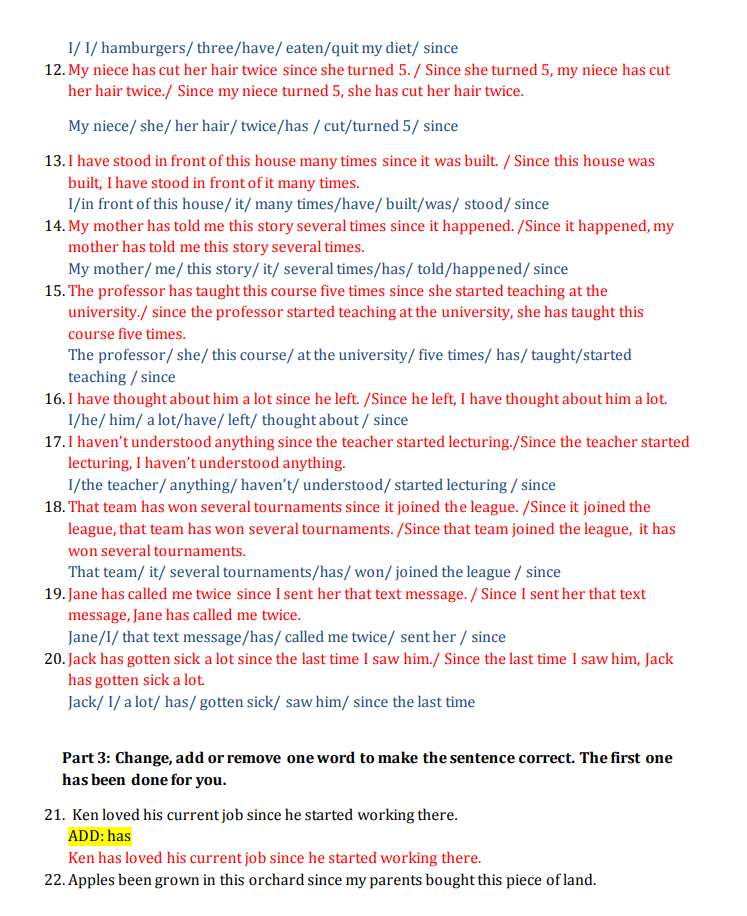
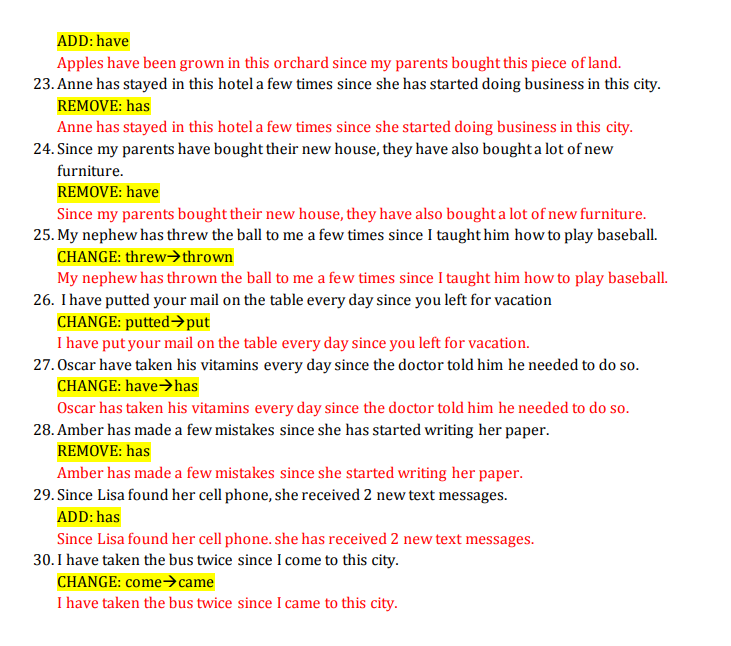
Warm-up Activity
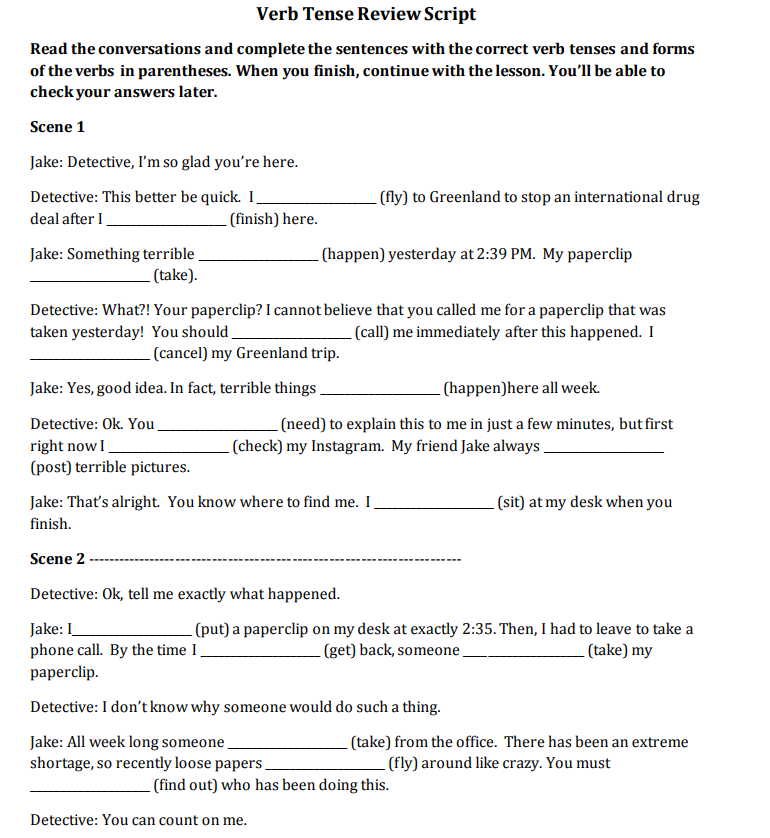

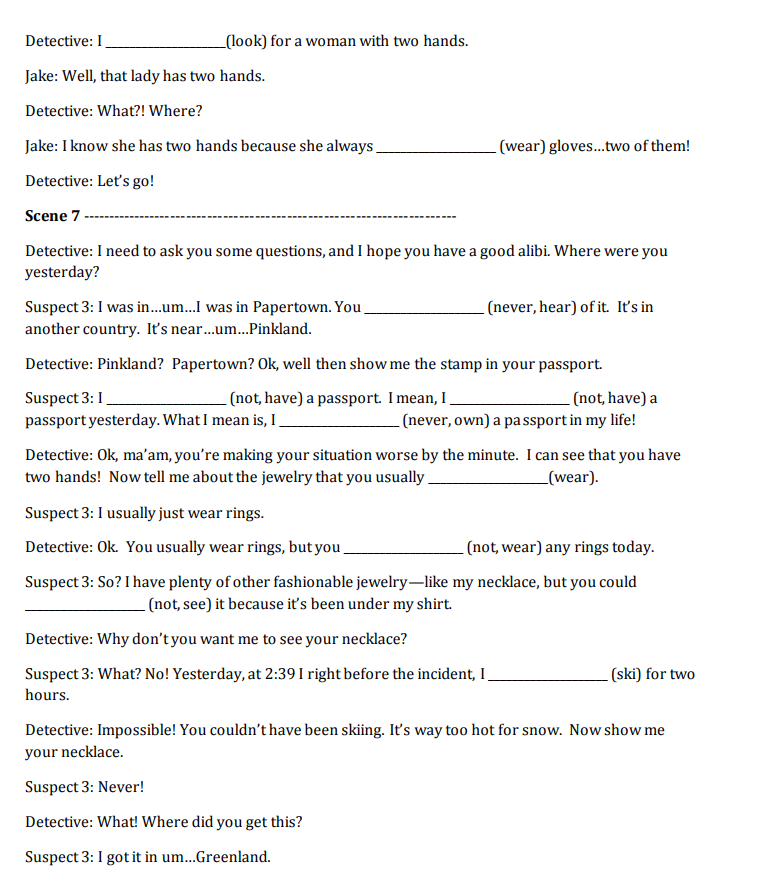
Verb Tenses Review Lecture
You’ve learned a lot of Verb Tenses and
Passive Verbs. Now, you’re going to watch a video that uses all of these. >> What? This is not my paper clip! [SOUND] Detective,
I’m so glad you’re here. >> This better be quick. I’m flying to Greenland to stop
an international drug deal after I finish here. >> Something terrible happened
yesterday at 2:39 PM. My paperclip was taken. >> What? Your paperclip?
I cannot believe that you called me for a paperclip that was taken yesterday. You should have called me
immediately after this happened. I’m going to cancel my Greenland trip. >> Yes, good idea. In fact, terrible things have
been happening here all week. >> Okay. You’ll need to explain this
to me in just a few minutes. But first, right now,
I’m checking my Instagram. My friend Jake post
away terrible pictures. >> That’s alright. You know where to find me. I’ll be sitting at my
desk when you finish. >> All right.
Okay, tell me exactly what happened. >> I put a paperclip on
my desk at exactly 2:35. Then I had to leave to take
an international phone call. By the time I got back,
someone had taken my paperclip. >> I don’t know why someone
would do such a thing. >> All week long, someone has been
taking paperclips from the office. There’s been an extreme shortage so recently loose papers have
been flying around like crazy. [SOUND] You must find out
who’s been doing this. You can count on me. This was found at the crime scene. The thief must have been
a woman who wears jewelry. >> And she must have been
a woman with small hands. Or I guess it could have been a child. But probably not because
kids never use paper clips.
That’s true. Okay, I have a few questions
that I need to ask you about the moment the crime occurred. What were you doing yesterday
at exactly 2:39 PM? >> I was sitting outside and
I was eating at 2:39. >> And you were eating your food? >> Well, not exactly. You see, right before 2:39,
I had found some free food on the table. So I was eating that. >> I see, when couldn’t have been,
you couldn’t have taken it with him. It’s just not possible. >> Right.
What are you doing? >> I’m not doing anything. >> I’ve been looking for
you for a long time. >> But why? I haven’t done anything wrong. >> What? >> Okay, what’s in your hand? >> What are you talking about? My hand was cut off years
ago in a scissors accident. [SOUND]
By the time I finish this case, the Greenland drug deal would
have already started and ended.
What are you doing? >> I’m looking for a woman with two hands. >> Well, Bellany has two hands. >> What? Where.
I know she has two hands because she always wears gloves. Two of them. Let’s go. >> I need to ask you some questions and
I hope you have a good alibi. Where were you yesterday? >> I was in, I was in Papertown. Papertown. You’ve never heard of it. It’s in another country. it’s near Pinkland.
Pinkland. >> Pinkland, Papertown, okay. Well then show me the stamps
in your passport. >> I don’t have a passport. I mean,
I didn’t have a passport yesterday. What I mean is,
I’ve never owned a passport in my life. >> Okay, ma’am, you’re making your
situation worse by the minute I can see that you have two hands. Now tell me about the jewelry
that you usually wear. >> I usually just wear rings. >> Okay, you usually wear rings but
you’re not wearing any rings today. >> So,
I’ve plenty of other fashionable jewelry. Like my necklace but you couldn’t have
seen it because it’s been under my shirt. >> Why don’t you want me
to see your necklace? >> What? No. Yesterday at 2.39, right before the
incident, I had been skiing for two hours. >> Impossible. You couldn’t have been skiing. It’s way too hot for snow. Now show me your necklace. >> Never. >> What?
Where did you get this? >> I got it in Greenland [SOUND].
Verb Tense Review Practice Quiz
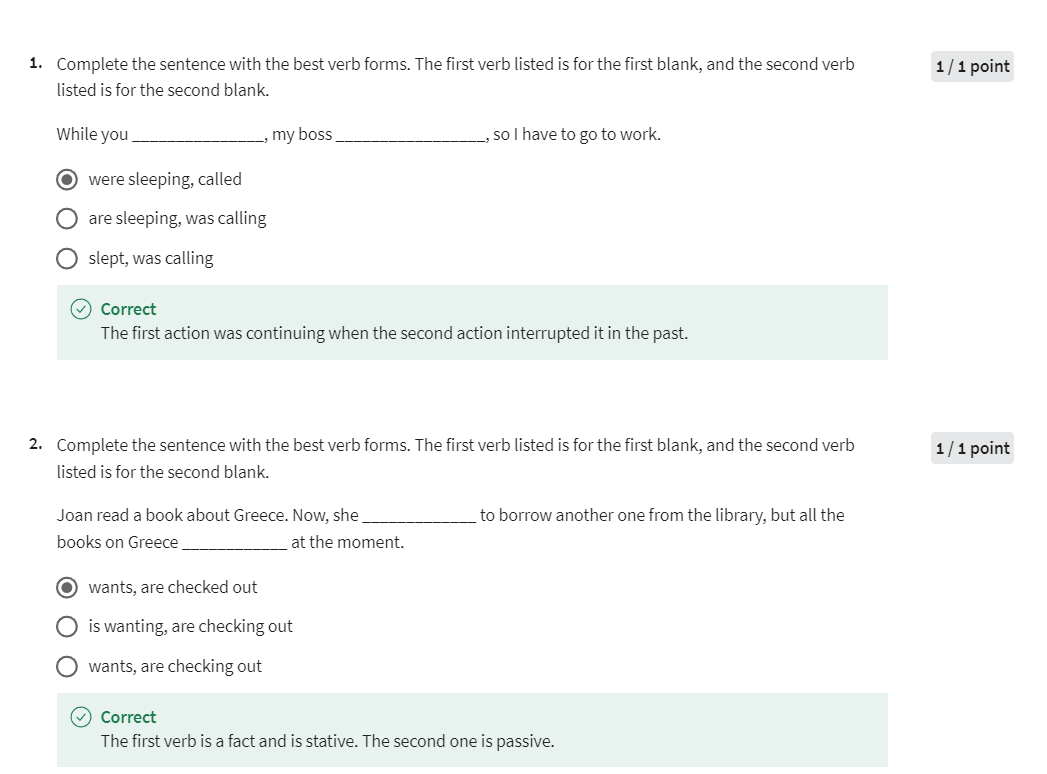
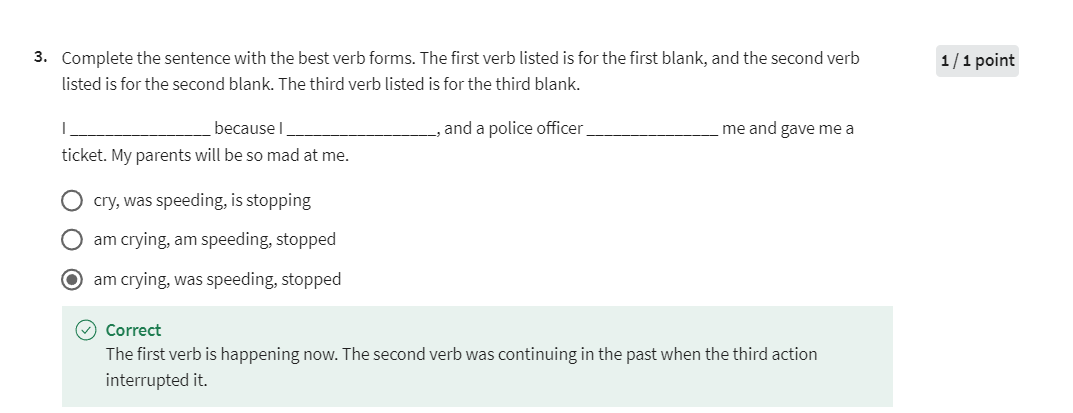
Graded Assignment: Final Mixed Verb Assignment
You will get a chance to demonstrate your ability to use all of the verb forms and tenses you’ve learned. You will choose one topic below to write a paragraph on using present, past, and future tenses correctly. You also need to use passives. You will need to be creative so that you can use a variety of verb forms. You must include at least 10 verbs in correct form and use at least five different tenses correctly. At least one of your verbs must be a perfect progressive verb (present, past, or future) and at least one must be passive. You will type the paragraph here for grading. I**talicize your verbs so they’re easy to see.
Topics
- your best memory
- your last vacation
- a difficulty you have overcome
- your favorite dish to cook
- a problem that you want to solve
My try
Undoubtedly, my best memory is the day I was proposed to by my partner. It happened during a romantic dinner overlooking the ocean. The sun had just set, casting a golden glow on everything around us. As we were enjoying our meal, a waiter discreetly approached our table and presented a beautifully wrapped box. I was completely taken by surprise as I opened it to find a stunning ring inside. Tears of joy were shed as my partner got down on one knee and asked me to spend the rest of my life with them. In that moment, everything stood still, and I knew that my life would never be the same again.
Graded Quiz
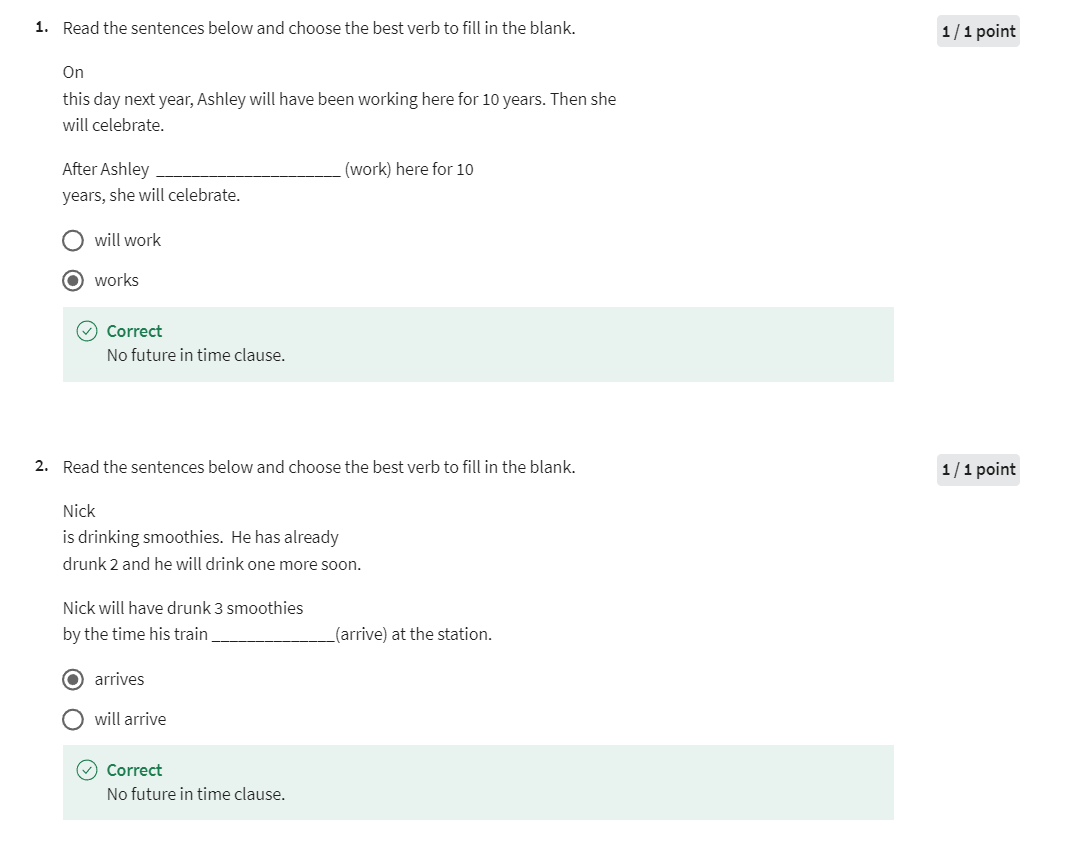
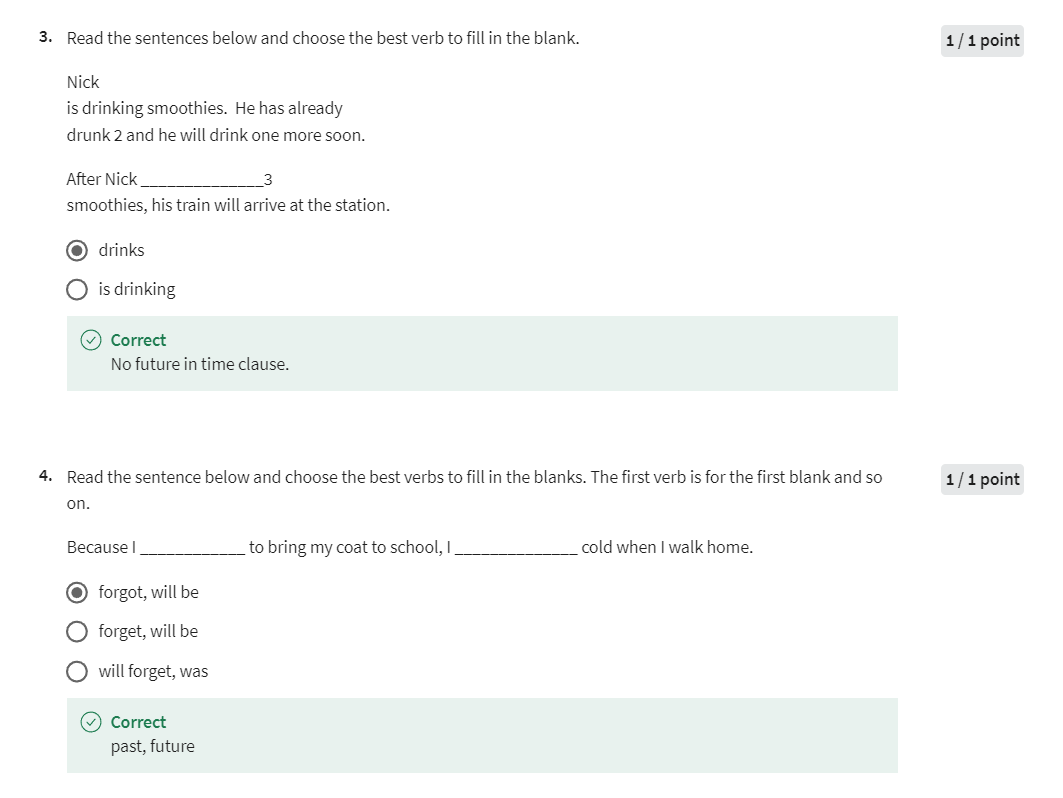
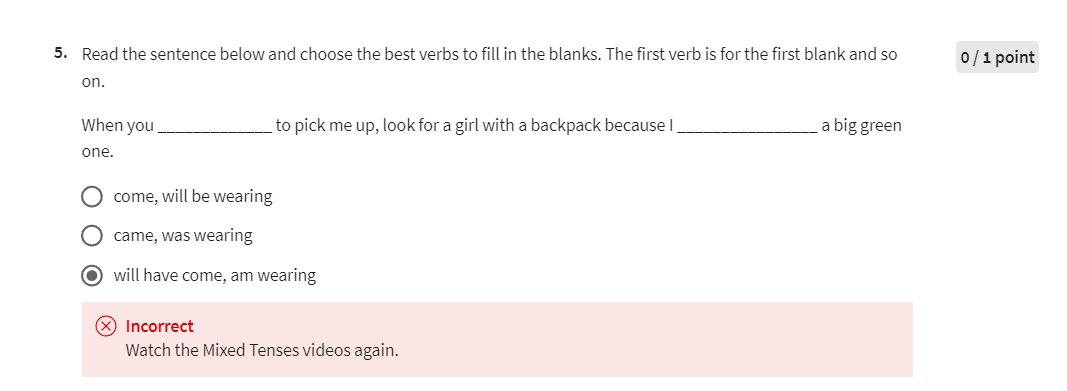
第五题做错了
The best verbs to fill in the blanks are:
When you come to pick me up, look for a girl with a backpack because I will be wearing a big green one.

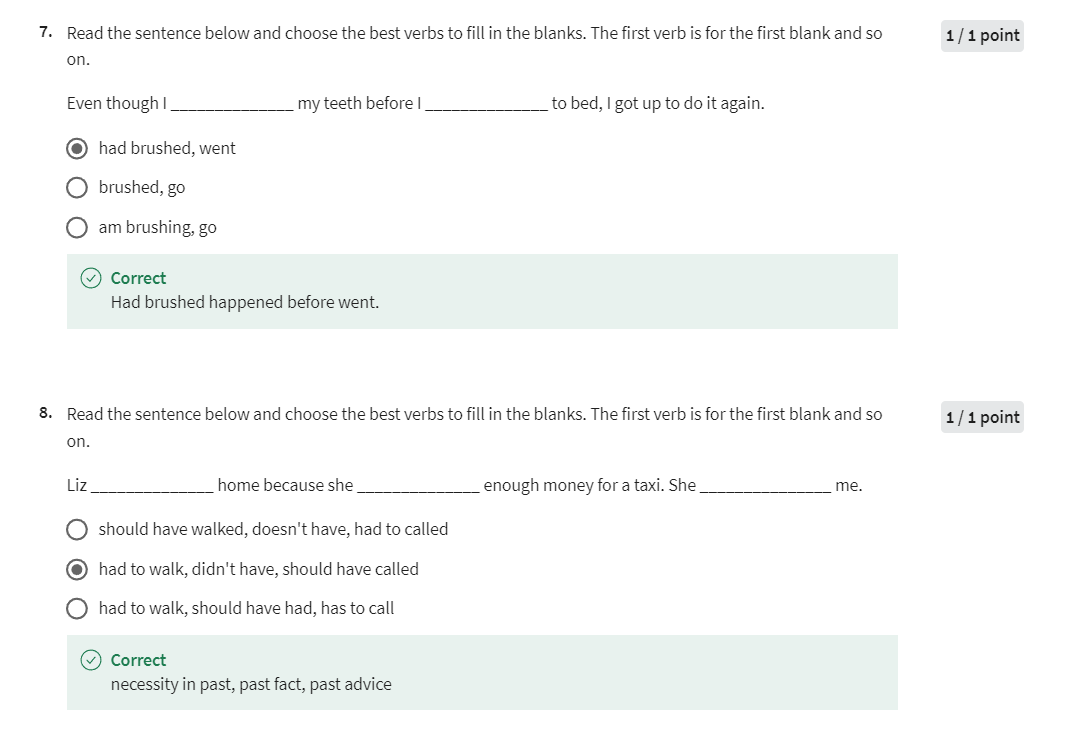
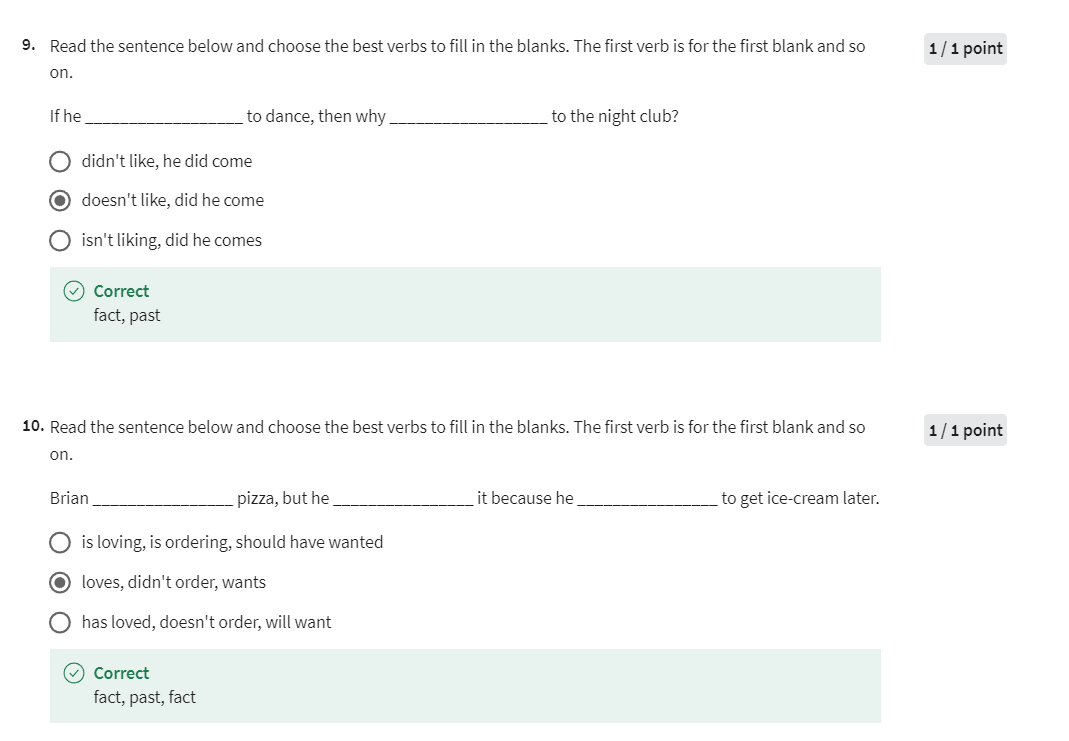
后记
2024年5月12日18点22分完成这门课的学习。主要包括一些动词完成时态和被动语态的学习。这是高级语法专项中的第一门课,知识点比较简单,主要是习惯介绍英文授课,接触英文世界的优质课程。
